Smartphone cameras are awesome. We've come a long way from the Nokia 7650 and its 0.3MP snapper which arguably kicked started the obsession of cramming cameras into handsets.
Now the top mobiles on the market rival - and even exceed - the capabilities of compact cameras while also performing a multitude of other tasks.
But which smartphone offers the best camera performance and image quality?
We've taken eight of the best phones from 2016 to find out who's top shot by shooting landscape, macro, indoor, low light and portrait images with each phone and analyzing all the photos with some highly trained, fine-toothed eyeballs.
- In a rush? Skip to the best camera phone verdict
Throw in a selfie camera test and a couple of high ISO challenges for good measure, and the best overall performer gets the glory.
If you're in the market for a new smartphone snapper this Christmas you're in the right place - skip to page 14 if you want to find out the results of our in-depth best camera phone test.
It's time to meet the contenders.
Apple iPhone 7 Plus

Key specs
- 12MP 1/3-inch, 28mm, f/1.8 and 12MP 1/3.6-inch, 56mm, f/2.8
- Optical image stabilization
- Phase detection autofocus
- Quad-LED dual-tone flash
- Front camera: 7MP, 28mm, f/2.2
- 5.5-inch IPS LCD display, 1080 x 1920, 401ppi
The iPhone 7 Plus is the first phone from Apple to boast dual cameras on the rear, with a couple of 12MP snappers located in the rounded bump on the body of the phone.
While both have the same megapixel rating, they are not identical with one having a wider field of view than the other.
This gives you the ability to 'zoom' by switching between the two cameras, and also allows the 7 Plus to sport a fancy portrait mode which can blur the background while keeping your subject in focus.
- Read our iPhone 7 Plus review
Google Pixel XL
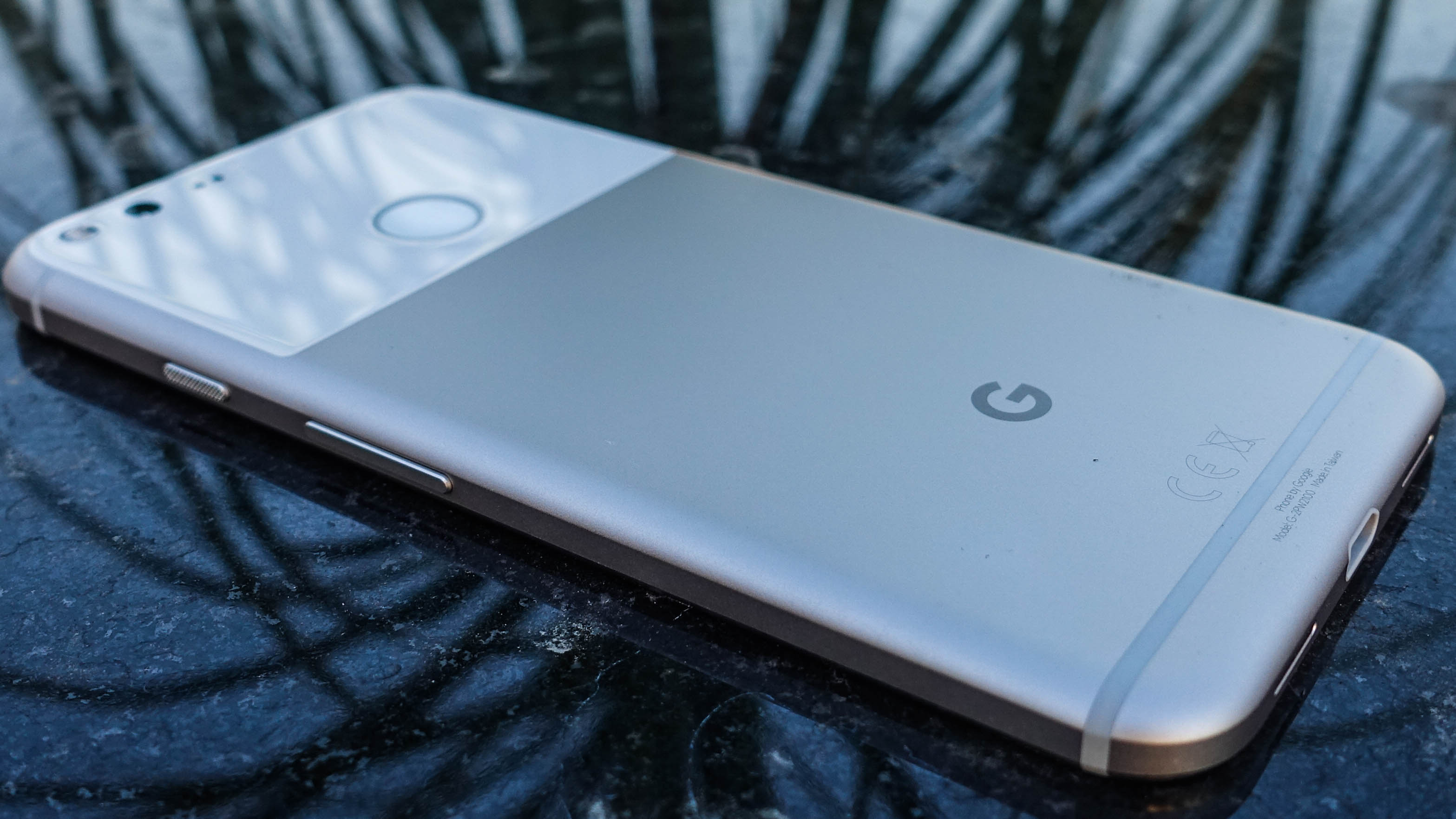
Key specs
- 12.3MP 1/2.3-inch, f/2.0
- Electronic image stabilization
- Phase detection and laser autofocus
- Dual-LED dual-tone flash
- Front camera: 8MP, f/2.4
- 5.5-inch AMOLED display, 1440 x 2560, 534ppi
Google's latest own-brand smartphone duo are of more premium ilk than previous years and the search giant has upped its camera game to bring the Pixel and Pixel XL in line with other top flagships on the market.
We've selected the Pixel XL of the two for our best camera phone test, as its larger 5.5-inch QHD display provides a larger, higher resolution viewfinder for your shots.
- Read our Google Pixel XL review
HTC 10
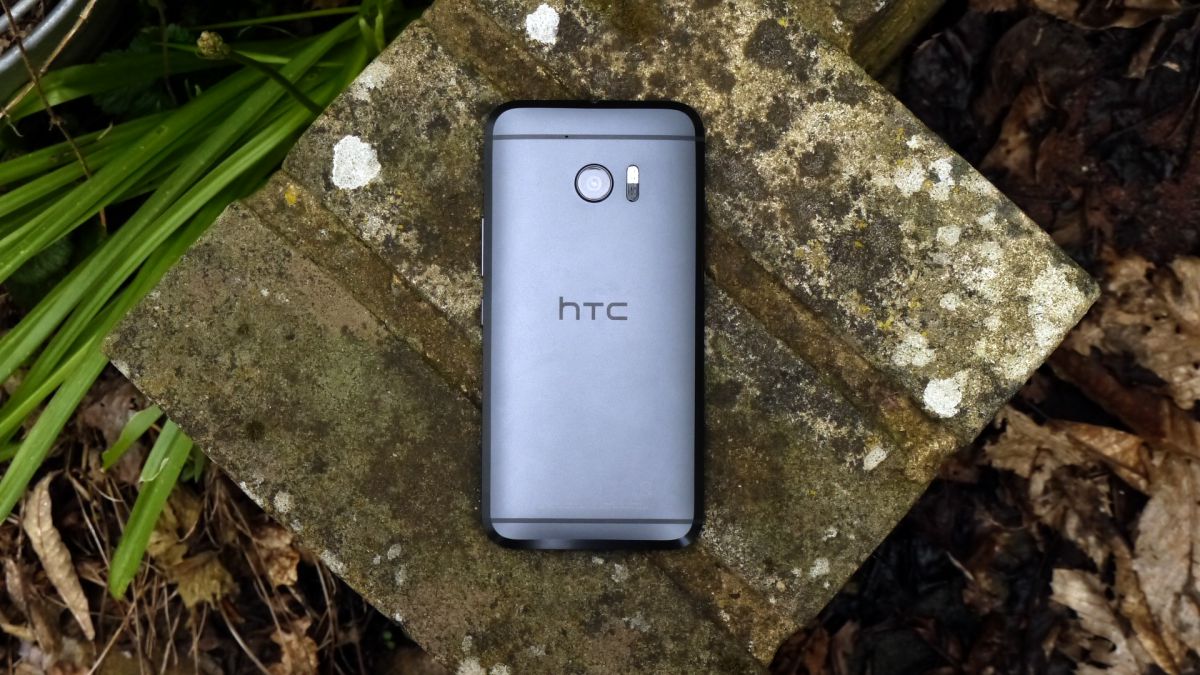
Key specs
- 12MP 1/2.3-inch, 26mm, f/1.8
- Optical image stabilization
- Laser autofocus
- Dual-LED dual-tone flash
- Front camera: 5MP, 23mm, f/1.8, OIS
- 5.2-inch LCD display, 1440 x 2560, 565ppi
- microSD
- Native raw capture
HTC has a strong pedigree in the smartphone camera market, and it has even dabbled in dual cameras in the past with the HTC One M8, but its latest flagship camera phone sticks with a single snapper.
There's a powerful manual mode baked into the camera app, and used the right way the HTC 10 is capable of some stunning shots - but is that enough to make it the best camera phone of 2016?
- Read our HTC 10 review
Huawei P9
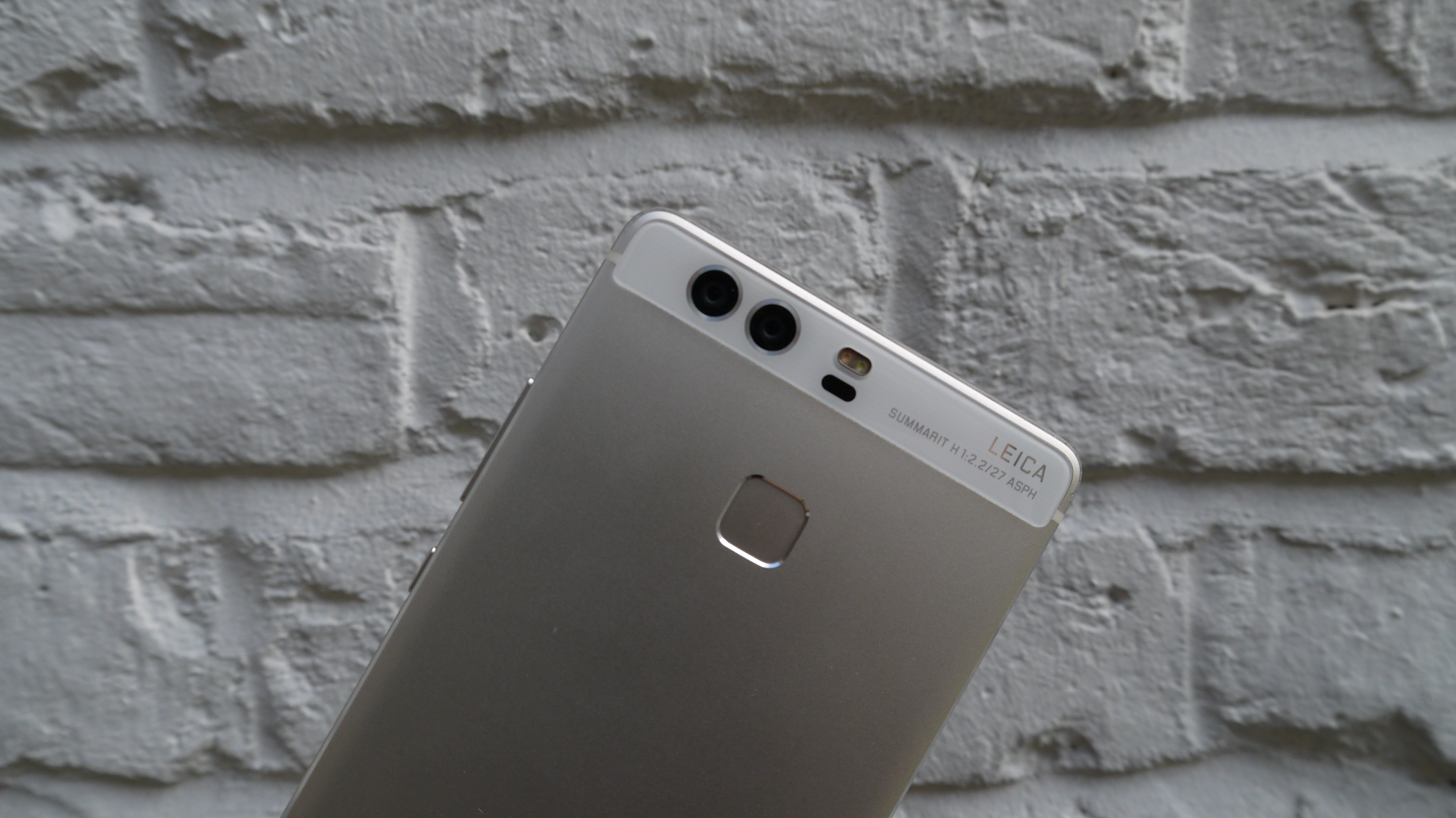
Key specs
- Dual 12MP, 27mm, f/2.2
- Phase detection autofocus
- Dual-LED dual-tone flash
- Front camera: 8MP, f/2.4
- 5.2-inch LCD display, 1080 x 1920, 423ppi
- microSD
- Native raw capture
It's double trouble on the Huawei P9 with two 12MP cameras sitting flush to the rear of the Chinese firm's handset - but like the 7 Plus they're not identical.
One is a full color RGB lens, while the other is a black and white offering tasked with sucking in extra light and working in unison with the color snapper. Co-engineered with camera giant Leica the P9 offers compelling camera phone competition.
- Read our Huawei P9 review
LG G5

Key specs
- 16MP, 29mm, f/1.8 and 8MP, 12mm, f/2.4
- Optical image stabilization
- Laser autofocus
- LED flash
- Front camera: 8MP, f/2.0
- 5.3-inch IPS LCD display, 1440 x 2560, 554ppi
- microSD
- Native raw capture
We're not done with the dual-snappers, with the LG G5 the third camera phone contender offering up a duo on its rear - and it's a third different implementation too.
Here you get a main 16MP snapper alongside a wide-angled 8MP camera and like the 7 Plus, you can jump between the two for a 'zoom' effect. LG's always trying something a bit different, but can its quirky pairing snap a victory?
- Read our LG G5 review
Motorola Moto Z
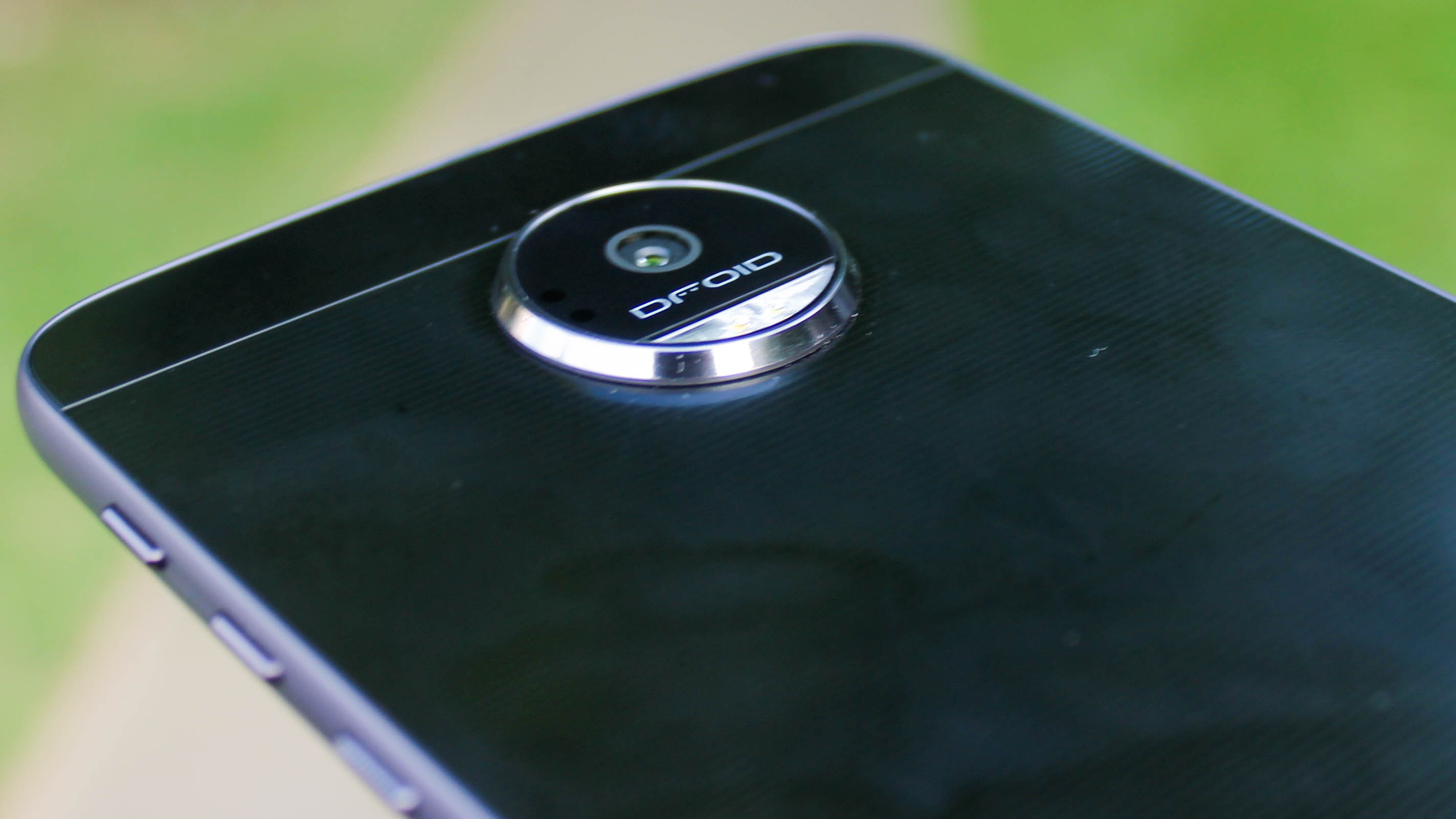
Key specs
- 13MP, f/1.8
- Optical image stabilization
- Laser autofocus
- Dual-LED dual-tone flash
- Front camera: 5MP, f/2.2
- 5.5-inch AMOLED display, 1440 x 2560, 535ppi
- microSD
Motorola has had somewhat of a resurgence in 2016 under the stewardship of new(ish) owner Lenovo and the flagship Moto Z is solid offering and a real camera phone contender.
A 13MP camera adorns the rear of the phone in a sizable circular bump, while also claiming the title of 'world's thinnest phone' - which means it'll slide nicely into your jeans.
- Read our Motorola Moto Z review
Samsung Galaxy S7 Edge
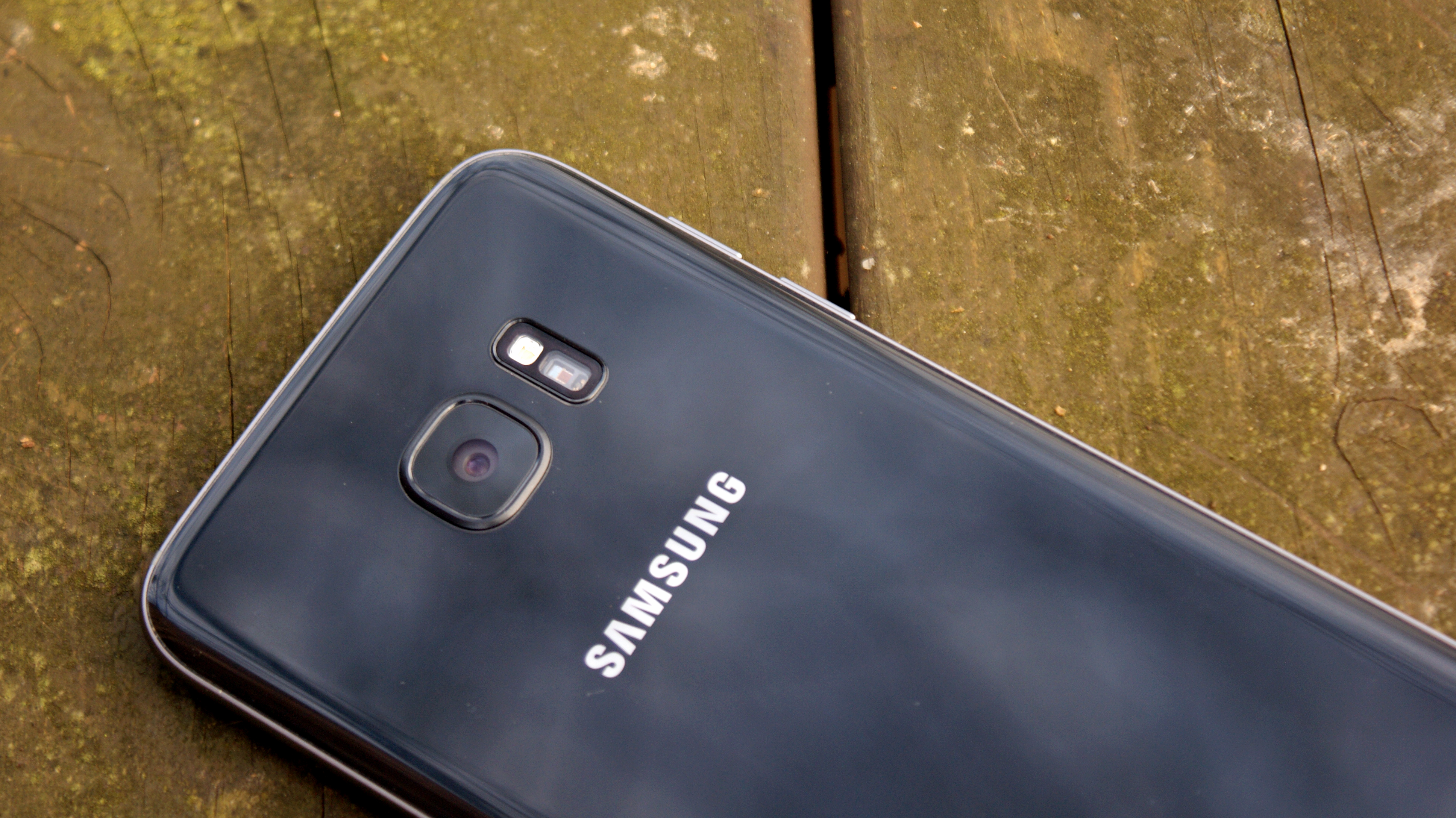
Key specs
- 12MP 1/2.5-inch, 26mm, f/1.7
- Optical image stabilization
- Phase detection autofocus
- LED flash
- Front camera: 5MP, 22mm, f/1.7
- 5.5-inch AMOLED display, 1440 x 2560, 534ppi
- microSD
- Native raw capture
The Samsung Galaxy S7 Edge is currently our best phone in the world right now, and for good reason as it excels in pretty much every way - including the camera.
We've chosen the S7 Edge over the Galaxy S7 for its larger screen and more stylish design. We know it's one of the best snappers on the market, but is it the best camera phone? Only one way to find out - read on!
- Read our Samsung Galaxy S7 Edge review
Sony Xperia XZ

Key specs
- 23MP 1/2.3-inch, 24mm, f/2.0
- Electronic image stabilization
- Phase detection and laser autofocus
- LED flash
- Front camera: 13MP, 22mm, f/2.0
- 5.2-inch IPS LCD display, 1080 x 1920, 424ppi
- microSD
Sony has an awesome background in photography, producing some of the best professional cameras around - and that technical know-how has filtered down to its smartphone range too.
The Xperia XZ is just the latest in what has been a long line of solid smartphone cameras, and the powerful 23MP snapper on the rear means this is a camera phone you'll want to keep an eye on throughout the test.
- Read our Sony Xperia XZ review
A good smartphone should have a default camera app that combines plenty of functionality and features, with an intuitive design that’s easy to use.
Screen brightness, contrast and color reproduction also affect the accuracy of the app’s image preview as you compose a shot, and while all our phones can focus fast, some autofocus systems are slightly more rapid than others.
Camera phone trivia: all about aperture
A camera lens is a bit like a hosepipe, but instead of water flowing through it, it flows light. The amount of light that can pass through at any one time can be controlled by adjusting the aperture.
This a basically a hole that can be varied in size, so the larger the hole/aperture, the more light can flow through to the sensor. A large aperture is good as it means you can snap a bright image without using a long shutter speed which could in turn result in blur from camera shake if you don’t hold steady.
It also means the sensor doesn’t need to use a high ISO sensitivity, so image noise is minimized.
The only downsides to a large aperture is it can cause a reduction in image sharpness in the corners of a photo, and it’s hard to photograph a scene where you want both the subject and background to be in focus.
Apple iPhone 7 Plus
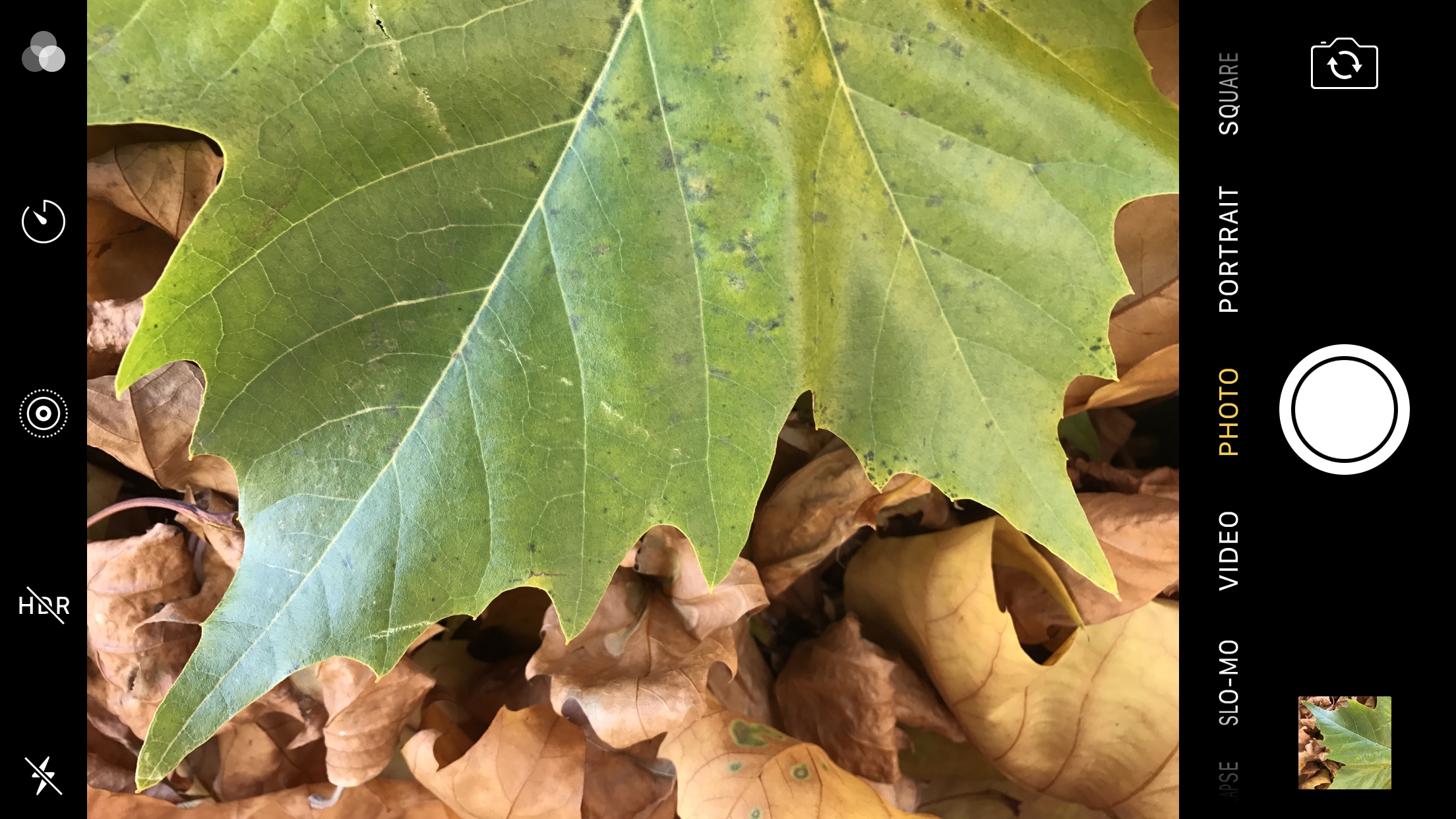
Apple’s native iPhone 7 Plus camera app is as clear and easy to use as you could want. There’s the usual iOS swipeable list of photo format options, easily accessible next to the shutter icon, and the list includes a Portrait mode that aims to replicate the shallow depth of field produced by a large aperture DSLR lens.
This can work quite well, but only when shooting a very isolated subject. Otherwise the effect can be more like a strange interpretation of a toy camera filter effect.
The default iOS camera app lacks any manual control or raw file capture, and while these features can be accessed through third-party apps, you may have to pay for the privilege. Apple’s camera app does give you some filter effects, and an HDR mode, but not much more.
Performance is hard to fault though, with lightning fast autofocus that never misses a beat. The app’s image preview is also top notch, just edging out the S7 for color and contrast accuracy.
Google Pixel XL

Google has taken inspiration from Apple’s camera app for the Pixel XL, and with similar results.
Apart from some nifty photo modes like Photo Sphere for shooting spherical panoramas, and a Lens Blur mode that rivals the iPhone’s Portrait mode, you’ve only got HDR, flash, white balance and exposure compensation to play with. But with so little cluttering the app, it’s a doddle to use.
Like Apple, Google has locked out raw image capture from its stock Android camera app, but you can get around this by using a suitable third-party alternative.
The native app’s image preview is reasonably accurate, but slightly oversaturated and doesn’t provide as realistic a view as the iPhone or S7’s apps.
Contrast is also a tad high, which makes for a punchy look, but at the expense of some slightly blown highlights and dark shadows. At least autofocus performance is near-perfect.
HTC 10
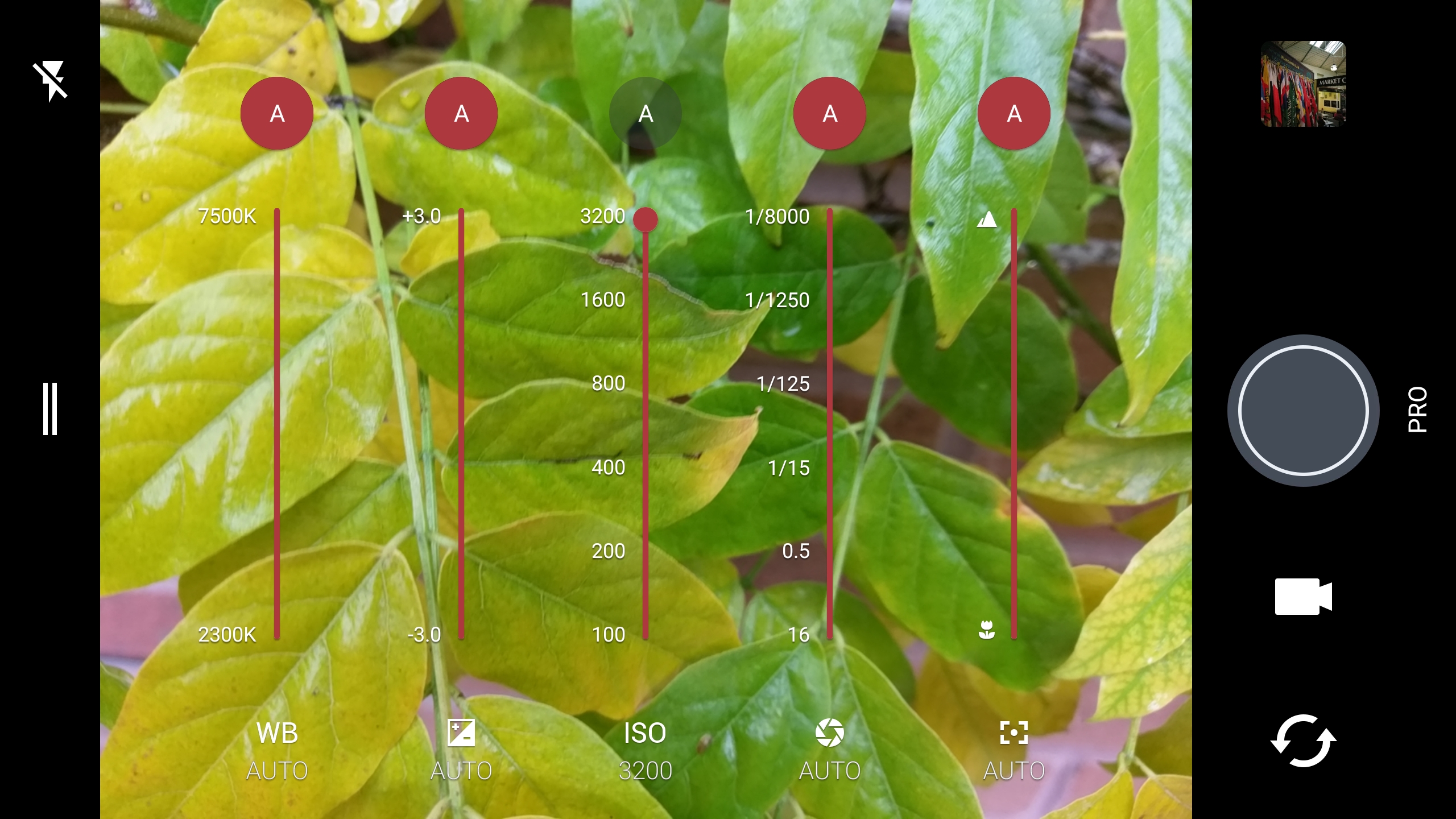
The HTC 10’s image preview exhibits similar traits to some of its rivals, oversaturating red and orange tones, and underexposing some darker shadow areas. Autofocus performance is also good but not great, as in some low light scenarios there can be minor focus hunting.
Standard Photo mode in HTC’s camera app includes common options like flash and HDR settings on the main preview screen, but select Pro mode and a new menu of manual camera functions pops out.
These settings include white balance, exposure compensation, ISO sensitivity settings and a manual focus feature, with each option getting its own easy to use slider. Pro mode also gives you the option of DNG raw capture.
Huawei P9
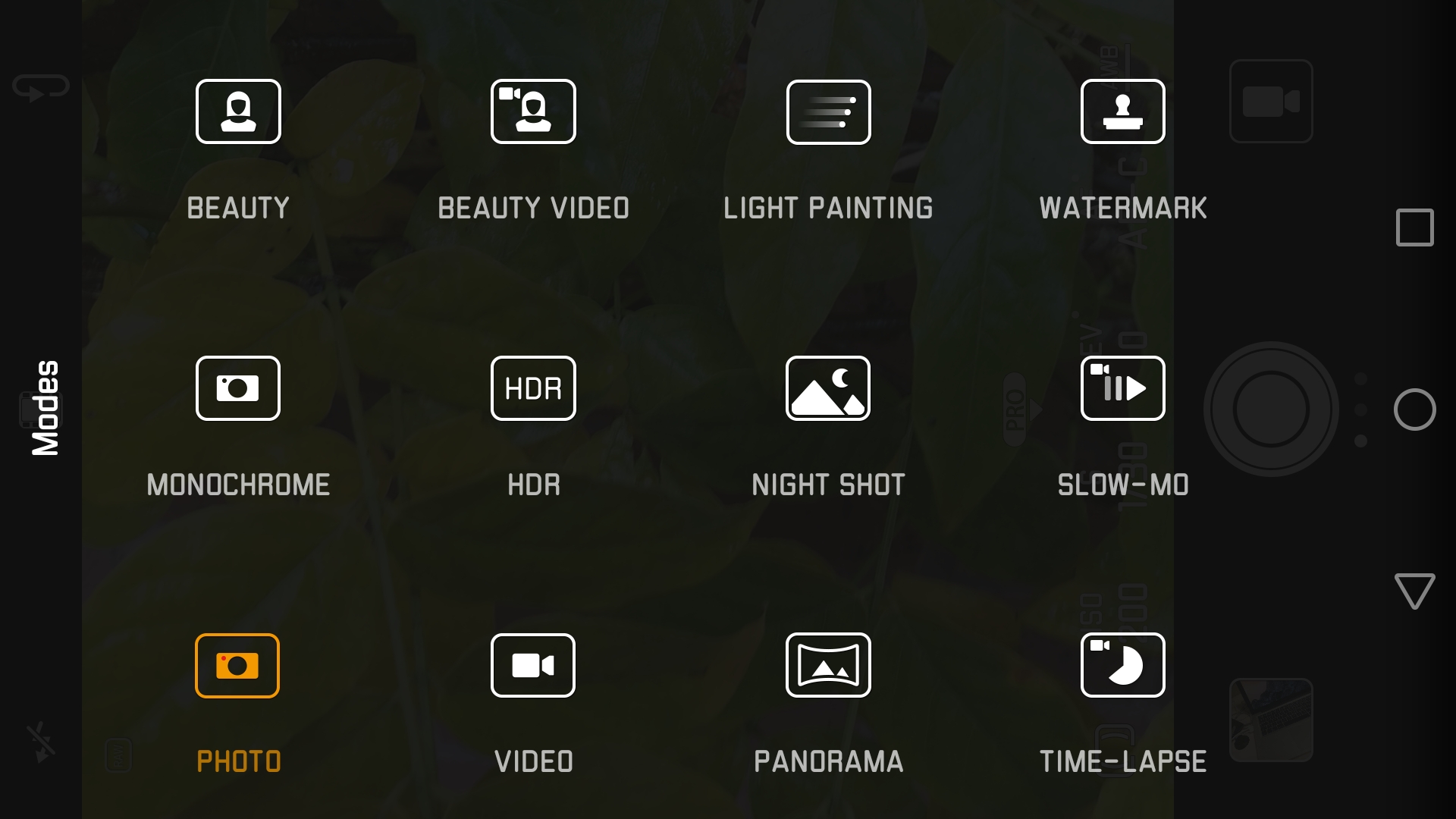
The joint Huawei/Leica-developed app on the Huawei P9 manages to fuse comprehensive manual control with good ease of use.
The interface is kept uncluttered by hiding the 14 shooting modes on a menu, accessed by swiping in from the left, while a swipe from the right reveals camera settings. Manual controls are easily revealed by swiping up from the shutter release icon, rather than hiding them in a separate pro mode.
Manual control covers metering options, sensitivity (ISO 50-3200), shutter speed, exposure compensation, autofocus options (continuous, single shot and manual focus), and white balance control that includes a custom scale covering 2800-7000k.
Autofocus isn’t quite as quick as the front runners, with minor lag when moving between near and far subjects, but it’s speedy enough. Huawei’s image preview is also slightly on the cool side, but colors aren’t oversaturated and dynamic range is good.
Annoyances? HDR is confined to a separate shooting mode, rather than being integrated into the default mode. The P9’s camera - like the iPhone’s - is also positioned in the far corner of the device, so you’ll need to be more careful where you place your fingers when shooting.
LG G5
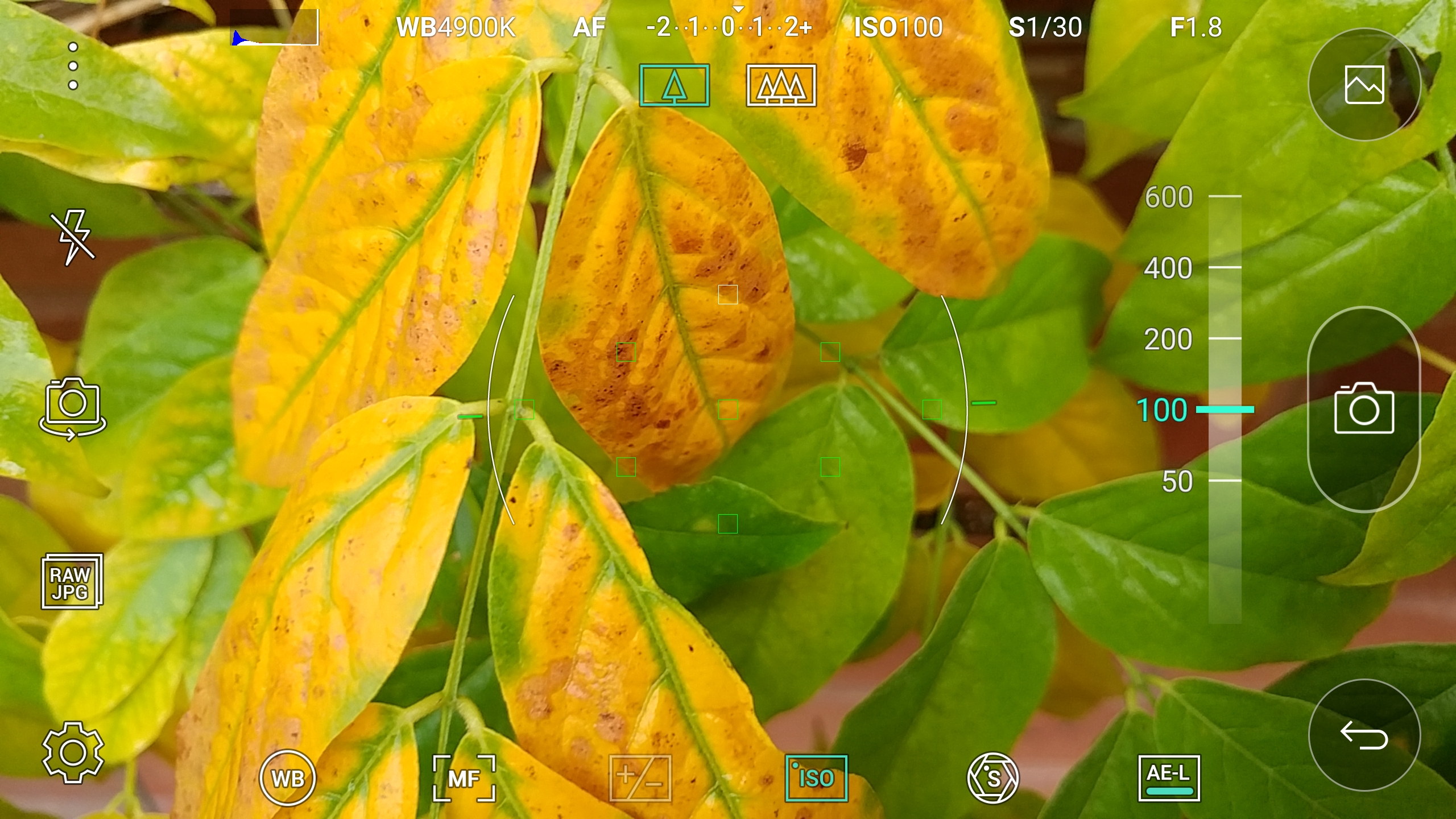
Apart from some slightly oversaturated colors, the LG G5’s image preview is impressively clear, with great dynamic range. This is the only phone here that shoots in a native 16:9 aspect ratio, filling the screen for a more immersive shooting experience.
Like the iPhone 7 Plus, the G5 packs dual cameras, but LG has gone for wide and wider in terms of focal length. The longer of the two lenses actually gives a typical wide-angle view, much like rival smartphones, whereas the ultra-wide lens provides an even larger field of view, albeit with plenty of barrel distortion.
Three main shooting modes are available: Simple, Auto, and Manual. Simple has no options at all. Auto reveals settings like aspect ratio, HDR, film color effects, image stabilization, and a voice activated shutter, while Manual mode gives you full-on control.
Options include manual focus, selectable ISO (50-3200), shutter speed, and there’s raw+JPEG capture. Manual really does mean manual though, so change the shutter speed and you’ll then need to tweak the ISO sensitivity to maintain an accurate exposure. It’s also annoying that you can only control the flash from within Manual mode.
Motorola Moto Z
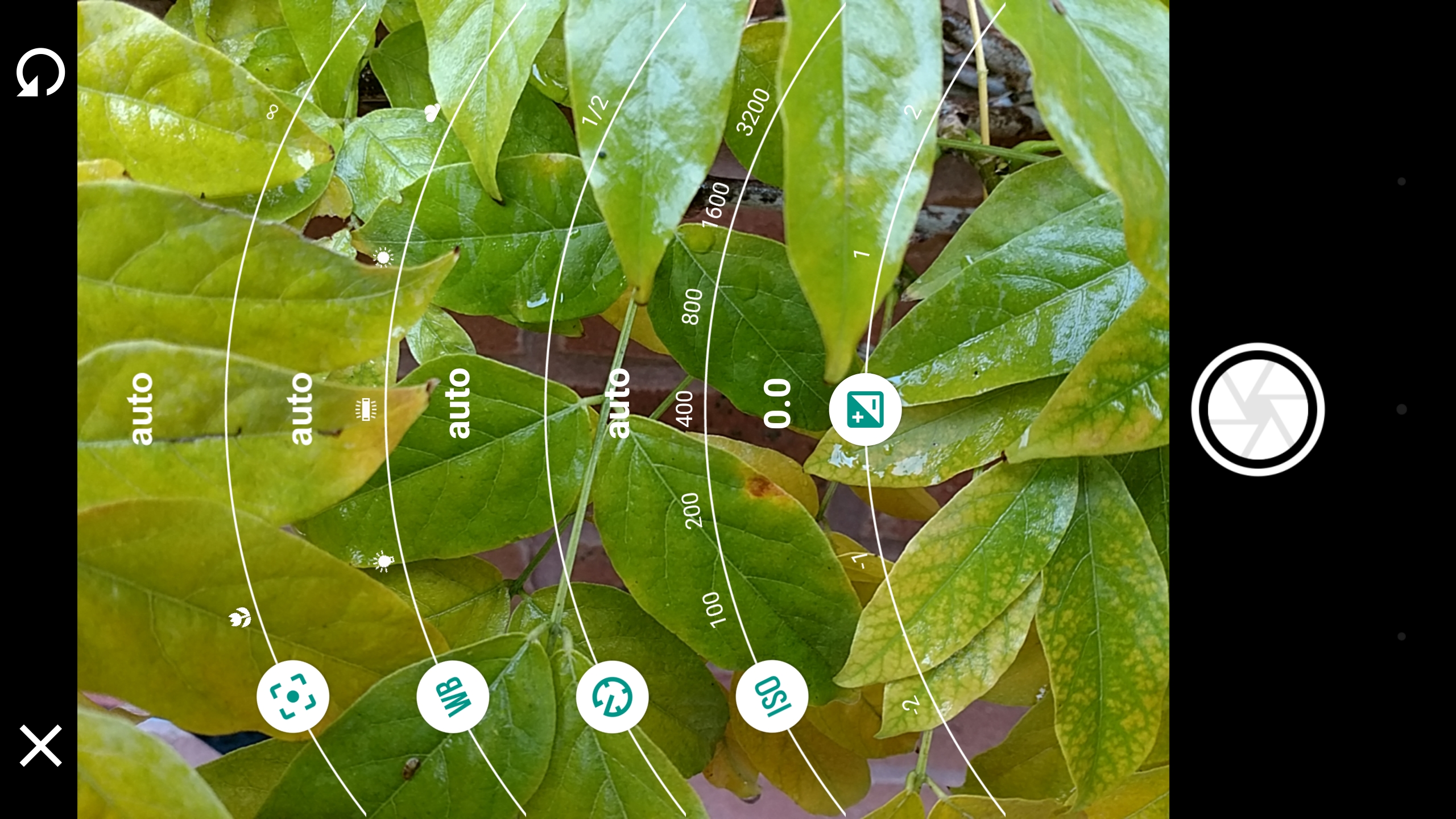
The Motorola Moto Z’s autofocus system puts in a solid performance, with just a slight pause when switching between close and far subjects before the camera locks on.
The stock camera app’s image preview isn’t quite as accomplished, as it oversaturates red hues, but not as much as the HTC or Sony phones. The app also struggles in mixed lighting situations, causing natural light to look overly cool when shooting from an indoor space with fluorescent lighting.
But when it comes to functionality, Motorola’s camera app is top notch. There’s easy adjustment of the self-timer, flash and HDR functionality from the home screen in Auto mode, while extra settings can be revealed by swiping in from the left edge.
Switch to Pro mode and more options appear, including manual focus, white balance, shutter speed, ISO sensitivity (100-3200), and exposure compensation. These settings can also be floated out to overlay the image preview with sliders for easier fine tuning.
Samsung Galaxy S7 Edge
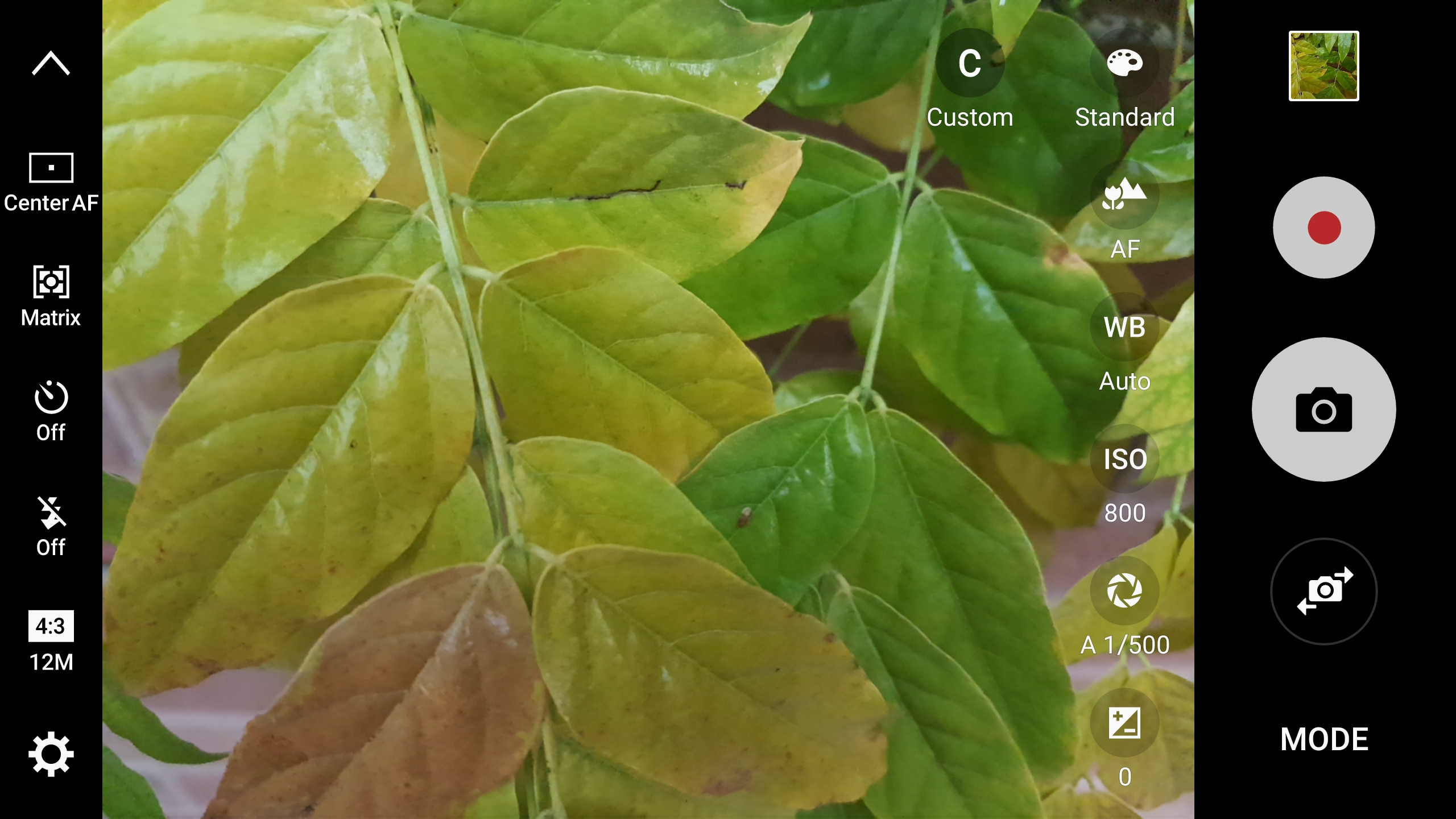
The Samsung Galaxy S7 Edge covers almost all the right bases. Its image preview impresses with color and contrast accuracy almost on par with the iPhone 7 Plus, but its app boasts much more creative control.
Auto mode gives you access to common settings like HDR, the flash and self-timer. But switch to Pro mode and there’s raw+JPEG capture and manual focusing, plus control over white balance, shutter speed and ISO sensitivity (100-800).
Pro mode enables even more expert options on a separate menu, including autofocus options (center and multi-point), as well as different metering modes (center-weighted, matrix, and spot). You even get three custom modes where you can save frequently used configurations.
There’s just one drawback to the S7 Edge’s usability: those curved screen edges make the phone a nightmare to hold on to.
Sony Xperia XZ
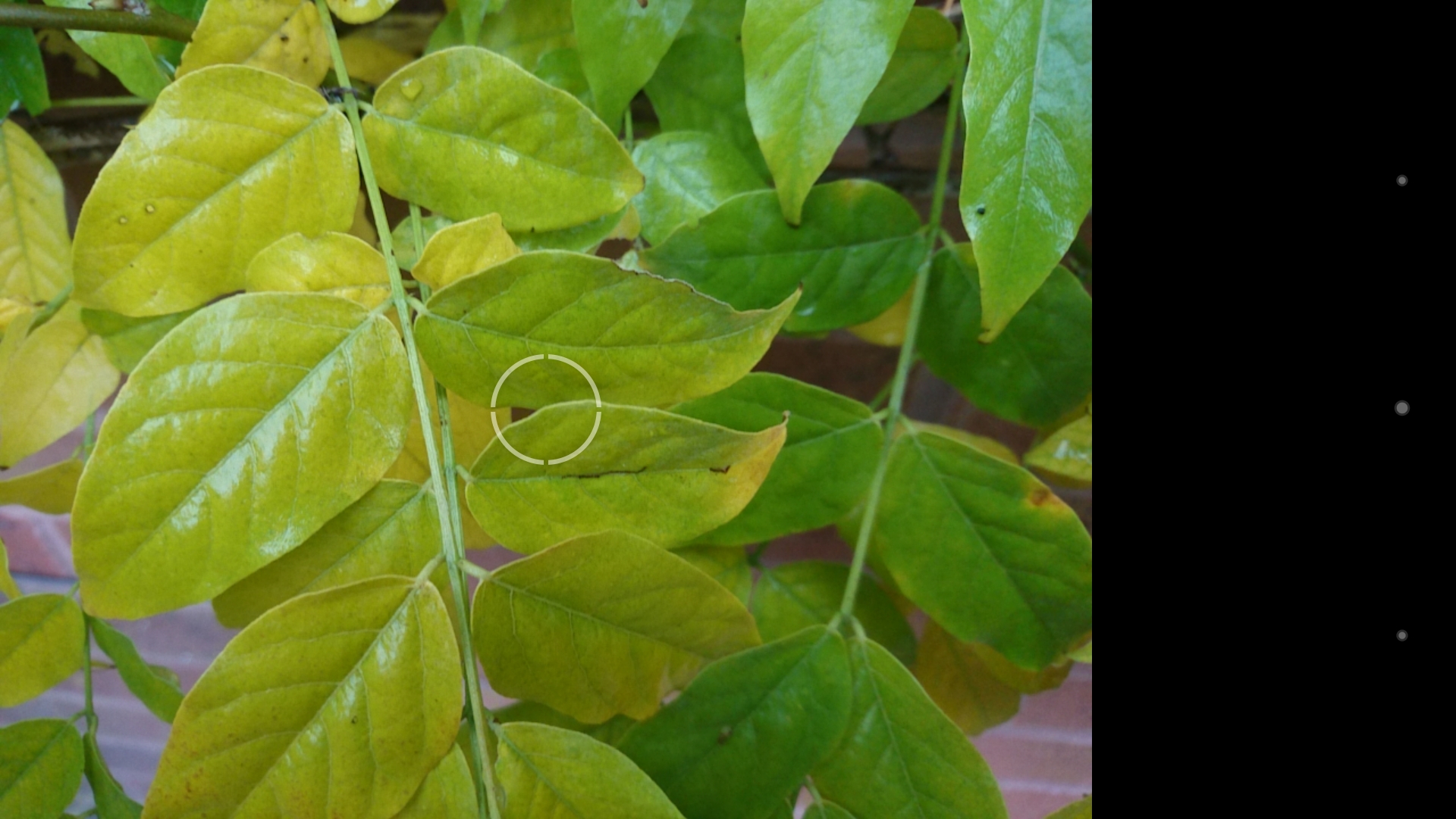
The Sony Xperia XZ follows in the footsteps of the Z3 and Z5 by including a proper two-stage hardware shutter button for a traditional camera feel. Half press to focus, then push all the way to shoot. A slightly chunkier physical form also helps the Xperia XZ feel marginally more secure in the hand than most rivals.
Fire up Sony’s camera app and you’re greeted by a mostly accurate image preview, apart from noticeably overcooked reds and oranges. Autofocus is more impressive, though not quite as nippy as the best phones here.
As with Sony’s previous flagship phones, maximum shooting resolution is 23MP, but where the Z3 did its best to lower this to 8MP in many scenarios, the XZ is content to maintain max res in the default Superior Auto mode, so that’s the resolution we went with for testing.
One swipe enters the manual mode, revealing ISO adjustment (50-3200) and metering options (face-detection, multi area, center weighted, spot, and touch) in the settings menu.
Strangely, these options are separated from other controls for exposure compensation, white balance, shutter speed and manual focus, which are accessed by tapping the sliders icon located between the settings and shutter release icons.
Winner: Samsung Galaxy S7 Edge
The combination of an accurate image preview and a fully-featured camera app with native raw capture earns the S7 Edge top marks here.
Runner up: Huawei P9
The Huawei P9’s image preview isn’t quite as realistic as the S7’s, but its app is beautifully designed and a pleasure to use.
Highly commended: Sony Xperia XZ
Includes a two-stage hardware shutter button that controls a comprehensive app packed with features. Preview color accuracy and autofocus performance could be improved though.
Highly commended: Motorola Moto Z
It’s not got the most accurate app preview and there’s no raw capture, but the app’s design is great and makes manual control a breeze.
A contrasty landscape scene is a great test of dynamic range and a sensor’s ability to resolve very fine detail.
We kept each phone’s HDR feature enabled for maximum dynamic range and the best possible color rendition.
Apple iPhone 7 Plus
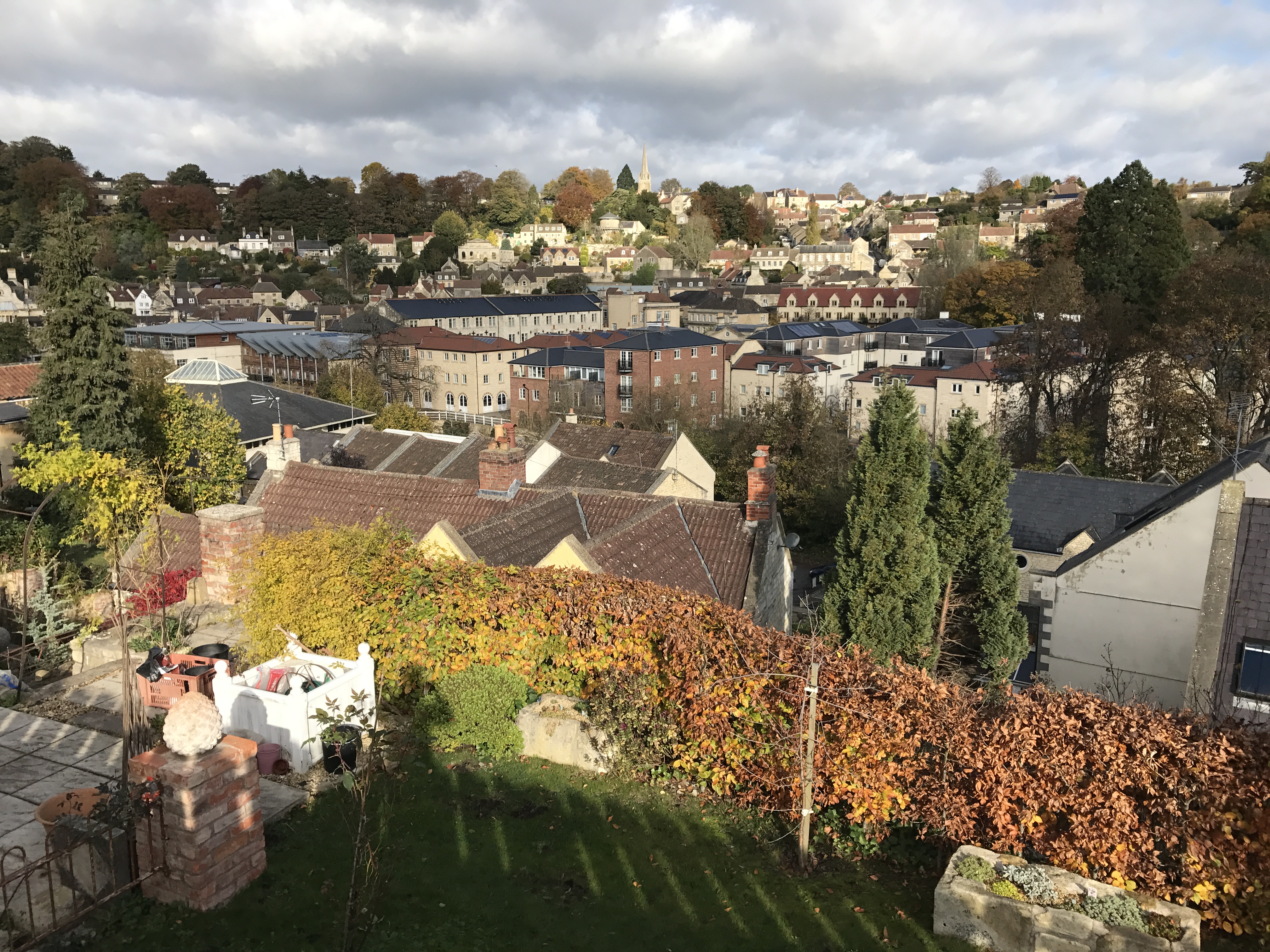
Click here to see the full resolution image
The iPhone 7 Plus’s landscape shot is initially impressive, with good dynamic range when HDR is enabled. This is helped by Apple’s very accurate exposure metering which avoids blowing highlight detail.
Highlight tones are rendered with more color saturation on phones like the Pixel XL in HDR mode, but Apple’s colors are marginally closer to what the eye perceives.
However, Apple’s shot doesn’t impress quite as much under closer scrutiny. Despite sharing a similar megapixel count to phones like the HTC 10 and Google Pixel XL, the 7 Plus’s landscape shot is noticeably less detailed when viewed at 100% image size, with fine foliage suffering the most.
Google Pixel XL
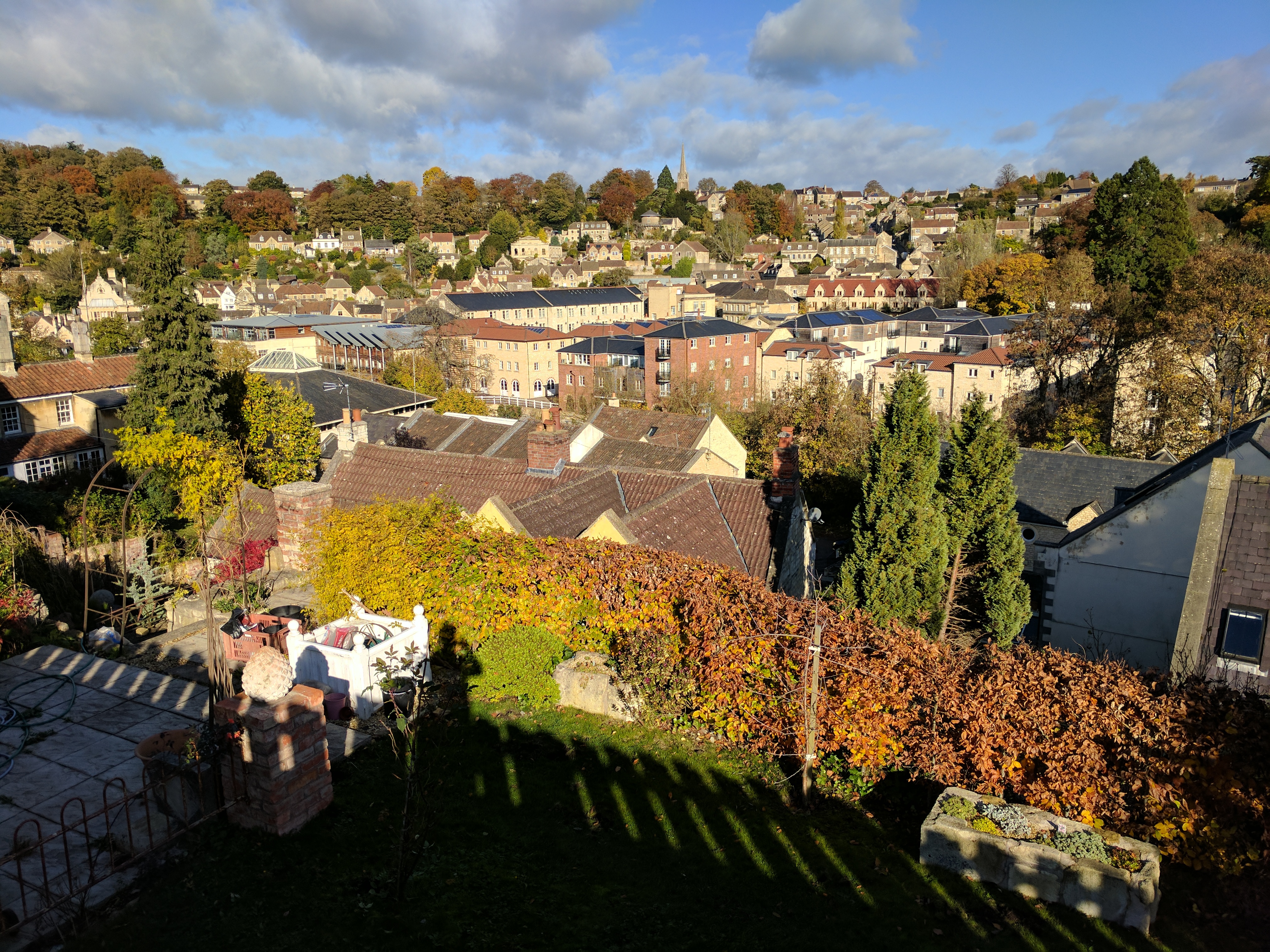
Click here to see the full resolution image
Apple can thank Google for showing up the 7 Plus’s mediocre detail reproduction. By contrast, the Pixel’s landscape images are incredibly sharp. Distant foliage, that is so often smeared by the small sensors in smartphones, is resolved with a level of detail that’s usually only seen with much larger Micro Four Thirds camera sensors.
Clearly Google is applying some considerable JPEG sharpening to its shots, and while this can result in some moiré interference on very fine repetitive textures like brickwork, this doesn’t detract from the overall image quality.
As well as its top-notch image sharpness, the Pixel XL also doesn’t disappoint when it comes to color reproduction and dynamic range.
HTC 10
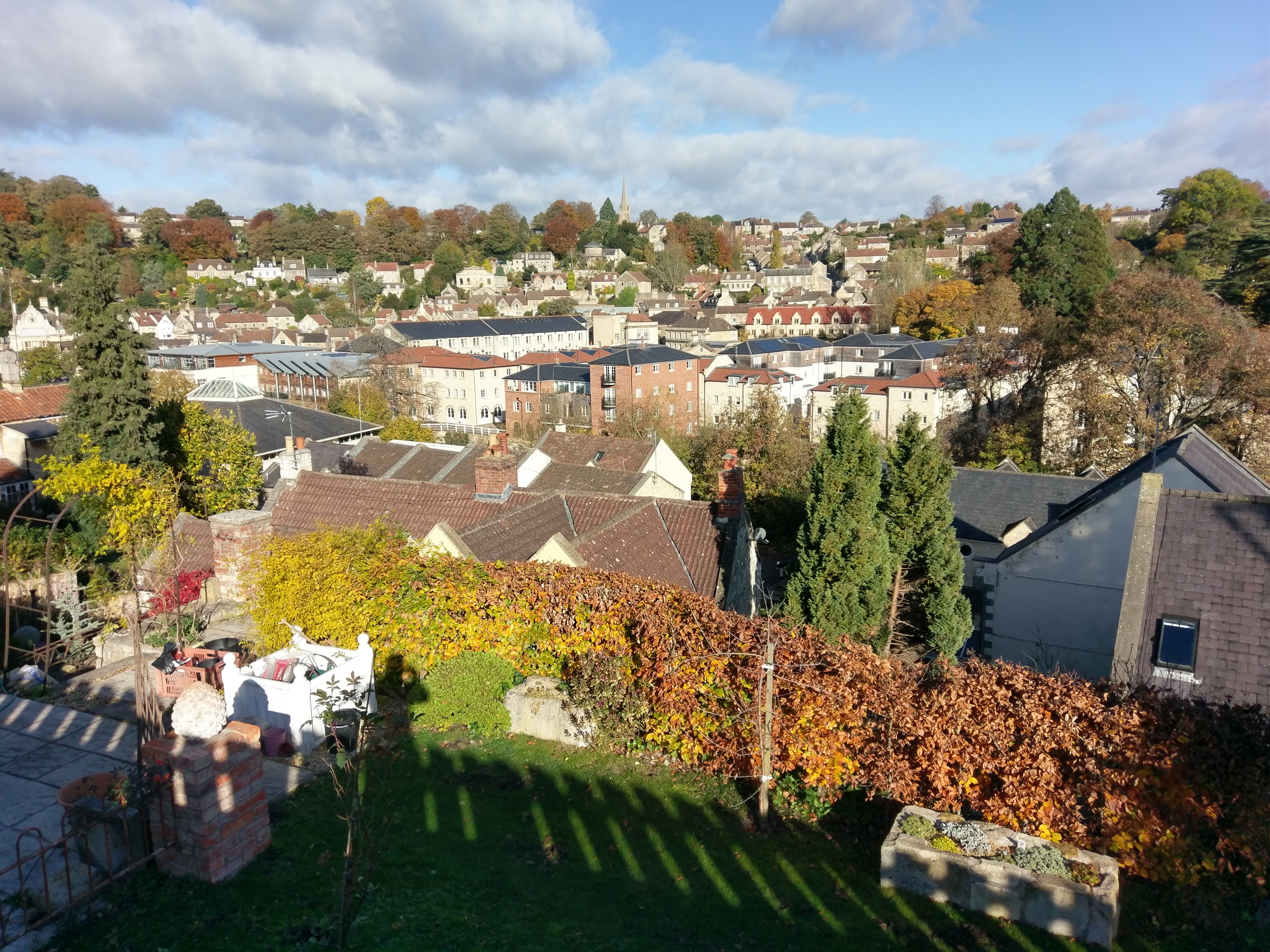
Click here to see the full resolution image
A landscape scene like this really exposed the weaknesses of the old One M9’s 20MP sensor, but the 12MP device in HTC’s newer flagship phone produces far better results. Detail is almost on par with the pin-sharp Pixel, and to some eyes HTC’s more conservative JPEG sharpening produces a slightly more natural overall appearance.
You could also call HTC’s color rendition natural, such are the more muted tones in the 10’s images. However, many will find these look slightly flat compared to the competition, with HTC’s HDR mode reducing contrast more than most.
Huawei P9
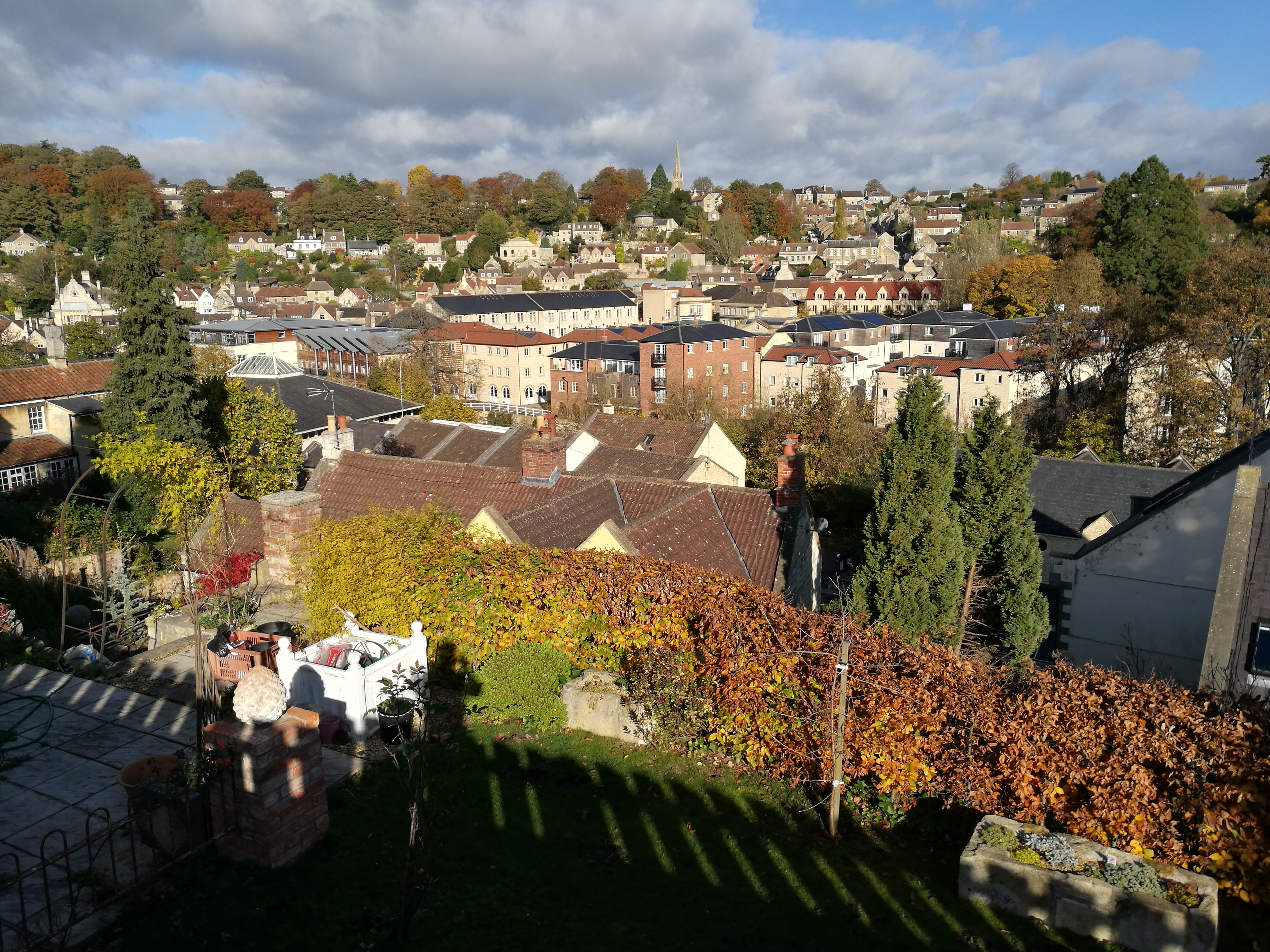
Click here to see the full resolution image
The Huawei P9 is another 12MP camera phone, and its connection with premium camera maker Leica suggests premium performance. But, like the iPhone 7 Plus, although the P9’s images are initially attractive, fine detail just isn’t up to the levels resolved by the top phones in the bunch.
LG G5

Click here to see the full resolution image
Even without selecting its ultra-wide angle camera, the LG G5’s native 16:9 image aspect ratio captures a significantly wider field of view than the 4:3 sensors in rival phones, giving a more panoramic perspective without needing to select the full-on panorama mode.
With HDR activated, the G5’s landscape shots are well exposed, with plenty of dynamic range. LG’s 16MP sensor suggests a detail boost over the 12MP cameras here, but although the G5’s shots aren’t lacking in sharpness, the HTC 10 and Pixel XL manage to resolve marginally more fine detail.
Motorola Moto Z
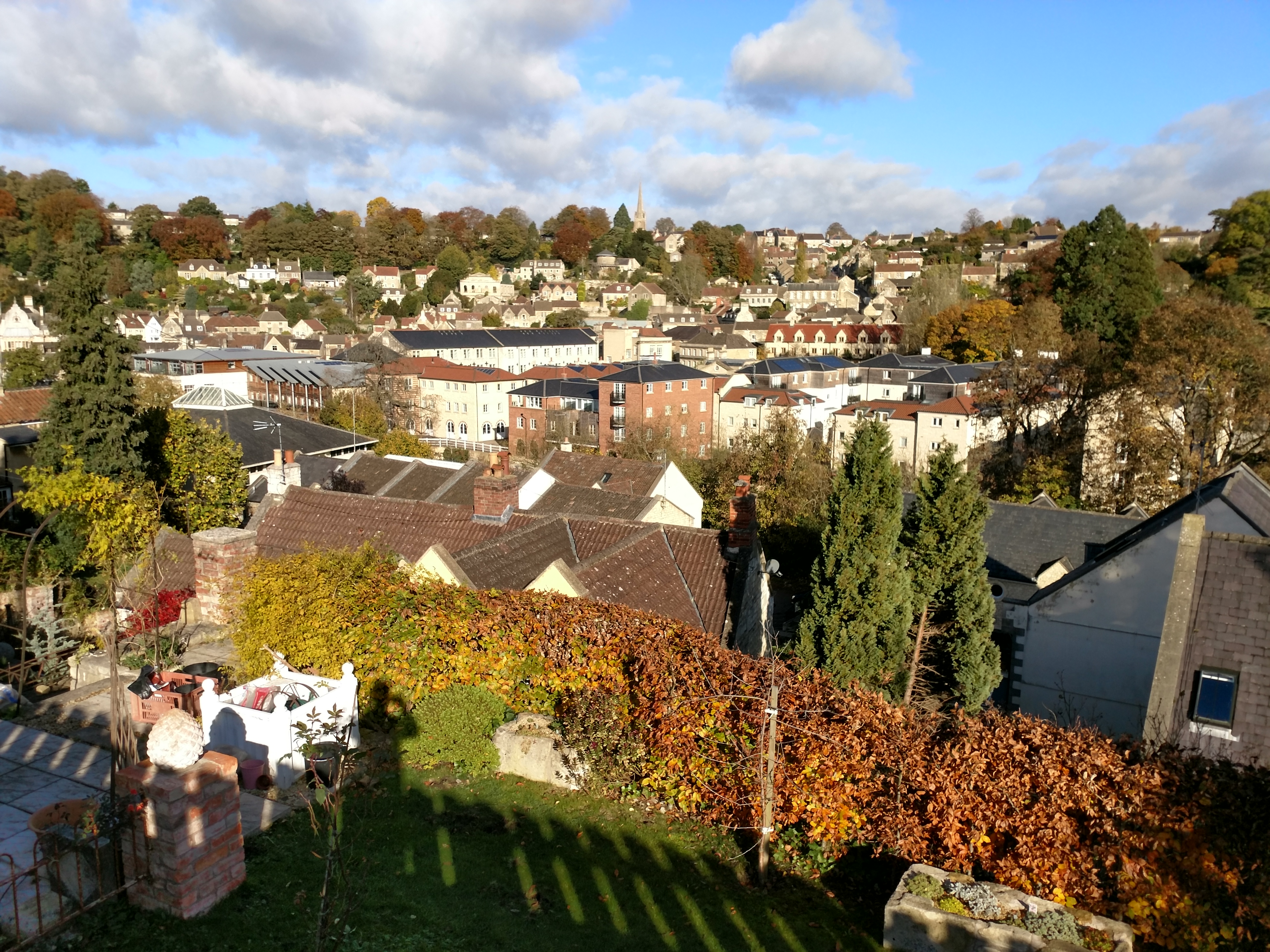
Click here to see the full resolution image
You need a very keen eye to find image quality faults with most of the landscape shots here, but unfortunately the Moto Z’s images are much easier to critique.
Even without viewing at a large image size, slight overexposure is causing bright highlights to blow out. Enlarge to 100% image size and the image quality looks a couple of years out of date, with image noise reduction smoothing fine detail to produce a slightly painterly appearance.
The effect isn’t as unsightly as the watercolor look that cheapo compact cameras can produce, but in such accomplished company, Motorola needs to up its game.
Samsung Galaxy S7 Edge

Click here to see the full resolution image
Getting the balance of capturing enhanced dynamic range in HDR mode while still maintaining enough contrast to make images ‘pop’ isn’t easy. Samsung has opted to keep things more contrasty for increased visual impact, but the result is arguably overcooked, with overly bright highlights that lack color saturation, alongside dark shadows that hide detail.
Detail in general is also a bit disappointing. Though the Galaxy S7 Edge doesn’t smear fine detail, neither does it resolve the really fine textures that HTC and Google’s phones can capture.
Sony Xperia XZ

Click here to see the full resolution image
Sony’s 23MP sensor in the Xperia XZ used to default to an 8MP setting for best results in the Xperia Z3 and Z5, but now it’s able to stay at maximum resolution in the default Superior Auto shooting mode.
Landscape scenes are one of the few areas where such a high megapixel count is actually beneficial to the final image quality, as the Xperia has resolved a huge amount of detail here. But, it’s not without flaws. Sony’s JPEG processing is harsh, with overzealous sharpening that makes fine textures like brickwork look over-processed and unnatural.
Winner: Google Pixel XL
No other phone here can match the Pixel’s level of detail capture, while decent dynamic range and color reproduction seal the deal.
Runner up: HTC 10
Generating shots almost as sharp as the Pixel, HTC’s effort only misses out on the top spot due to slightly flat color and contrast.
Highly commended: LG G5
Reasonable sharpness and a wide 16:9 aspect ratio make the G5 well suited to landscape photography.
Highly commended: Apple iPhone 7 Plus
What it lacks in detail, the 7 Plus mostly makes up for with realistic color and contrast.
It’s time to get in close to test autofocus accuracy and see how much detail each phone can capture under ideal conditions.
We’ve also thrown in some vibrant objects to test color reproduction as well.
Apple iPhone 7 Plus
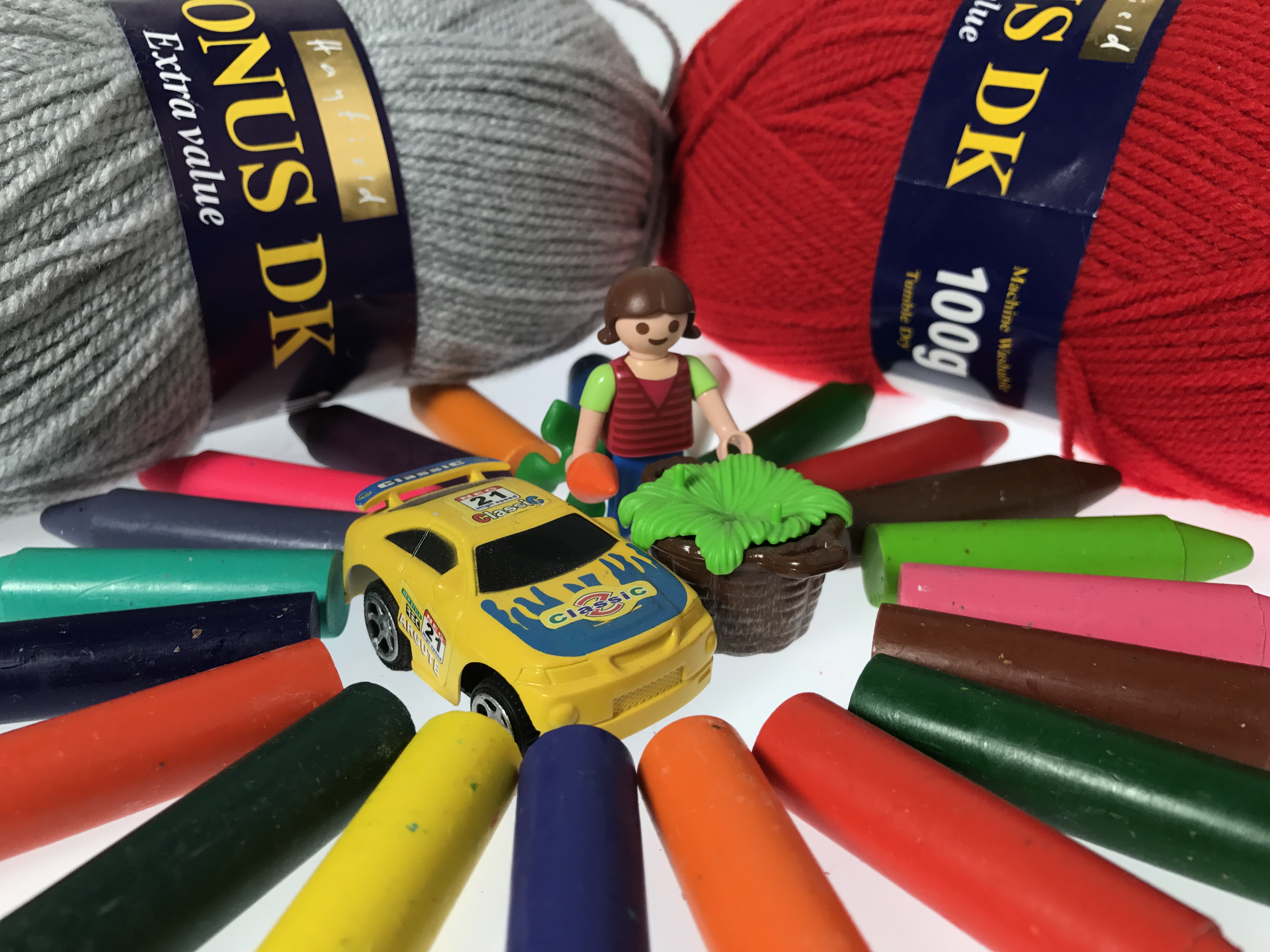
Click here to see the full resolution image
Just as in the landscape test, the iPhone 7 Plus’s 12MP sensor just can’t match the outright detail capture of many rivals, as it fails to resolve things like the fine dust on the toy car.
But the 7 Plus comes good with accurate exposure and white balance, helping to reproduce realistic color saturation across all hues. There’s also little sign of any image noise, while color boundaries are smooth and free from sharpening artefacts.
Google Pixel XL
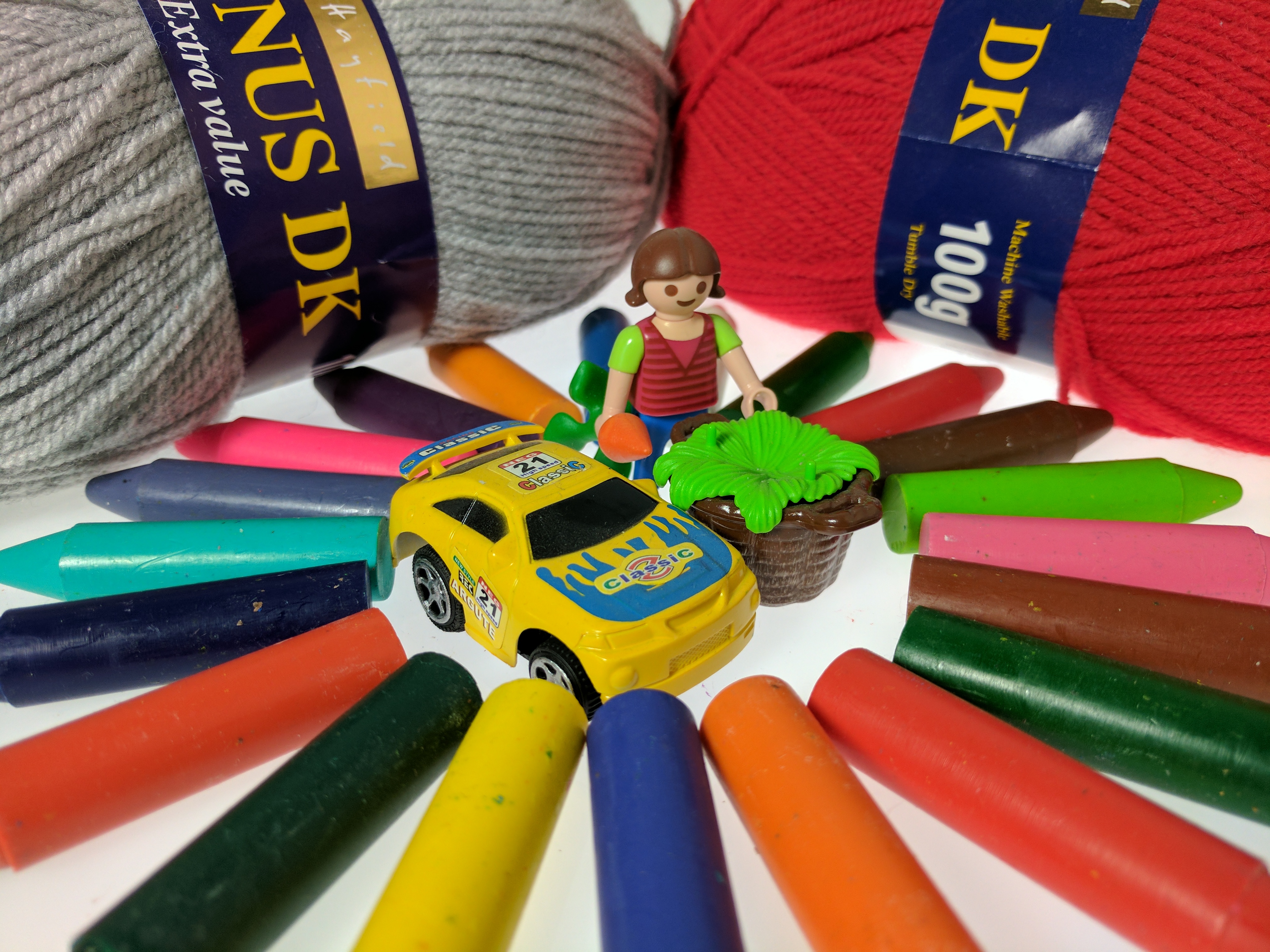
Click here to see the full resolution image
Compared to the iPhone’s macro shot, the Pixel XL’s looks a bit more processed, with the color boundaries in areas of sharp focus appearing slightly too razor sharp to be considered completely realistic.
Google has managed this without any sign of sharpening halos though, and image noise is all but eliminated. Color accuracy isn’t quite on a par with the iPhone, but there’s little to complain about here.
HTC 10
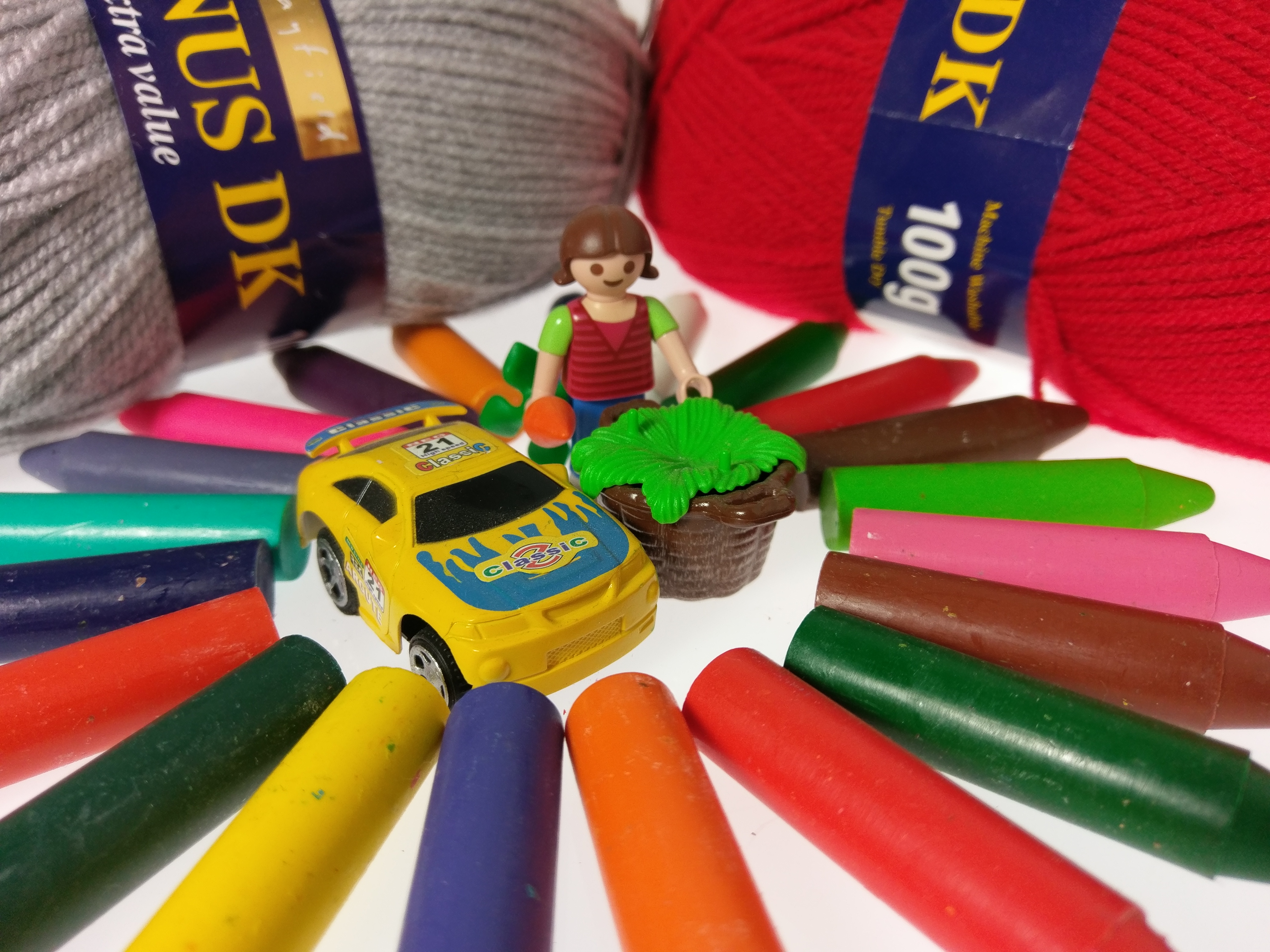
Click here to see the full resolution image
HTC’s conservative color rendition from the landscape scene is continued here, as the vibrant tones in this scene don’t pop as much as they could.
Detail certainly isn’t lacking though and the shot is up there with those by the S7 Edge and Pixel XL, however the HTC 10 does introduce a level of grain noise that most of the phones here avoid.
Huawei P9
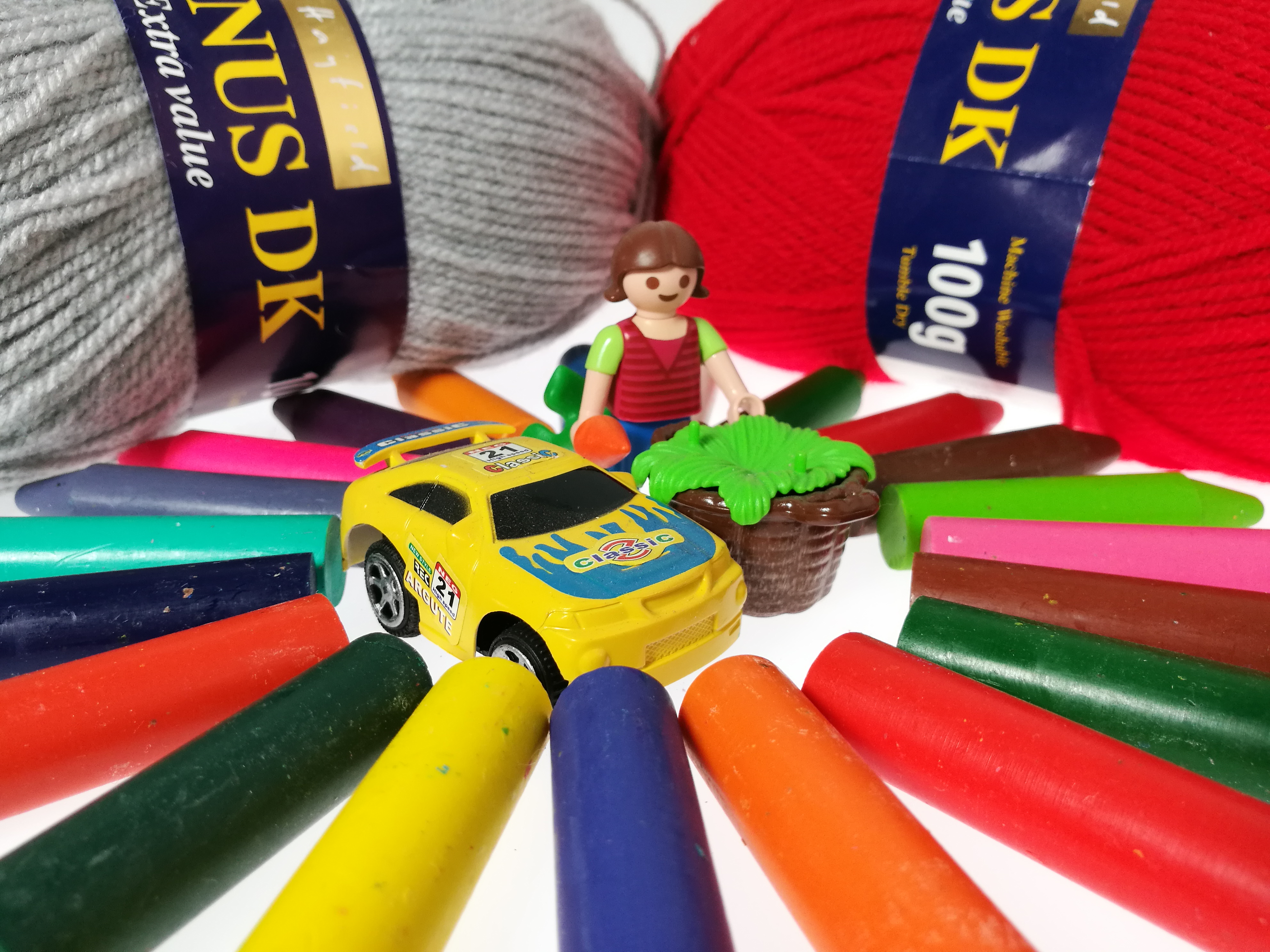
Click here to see the full resolution image
Compared to the HTC 10, the Huawei P9’s macro result is marginally less detailed, and while this definitely isn’t a deal-breaker, it is enough for the P9 to lose out in this incredibly close-run test.
Color, contrast and white balance are all good though, helping to make the P9 a solid option for macro photography.
LG G5

Click here to see the full resolution image
Look closely and the LG G5’s considerable JPEG processing is evident here, with significant sharpening on high-contrast color boundaries resulting in a halo effect that causes sharp edges to appear overly bright.
This sharpening also causes some in-focus edges to look slightly jagged and pixelated, and other flaws include some oversaturated red tones. At least the G5 successfully conceals grain noise though.
Motorola Moto Z
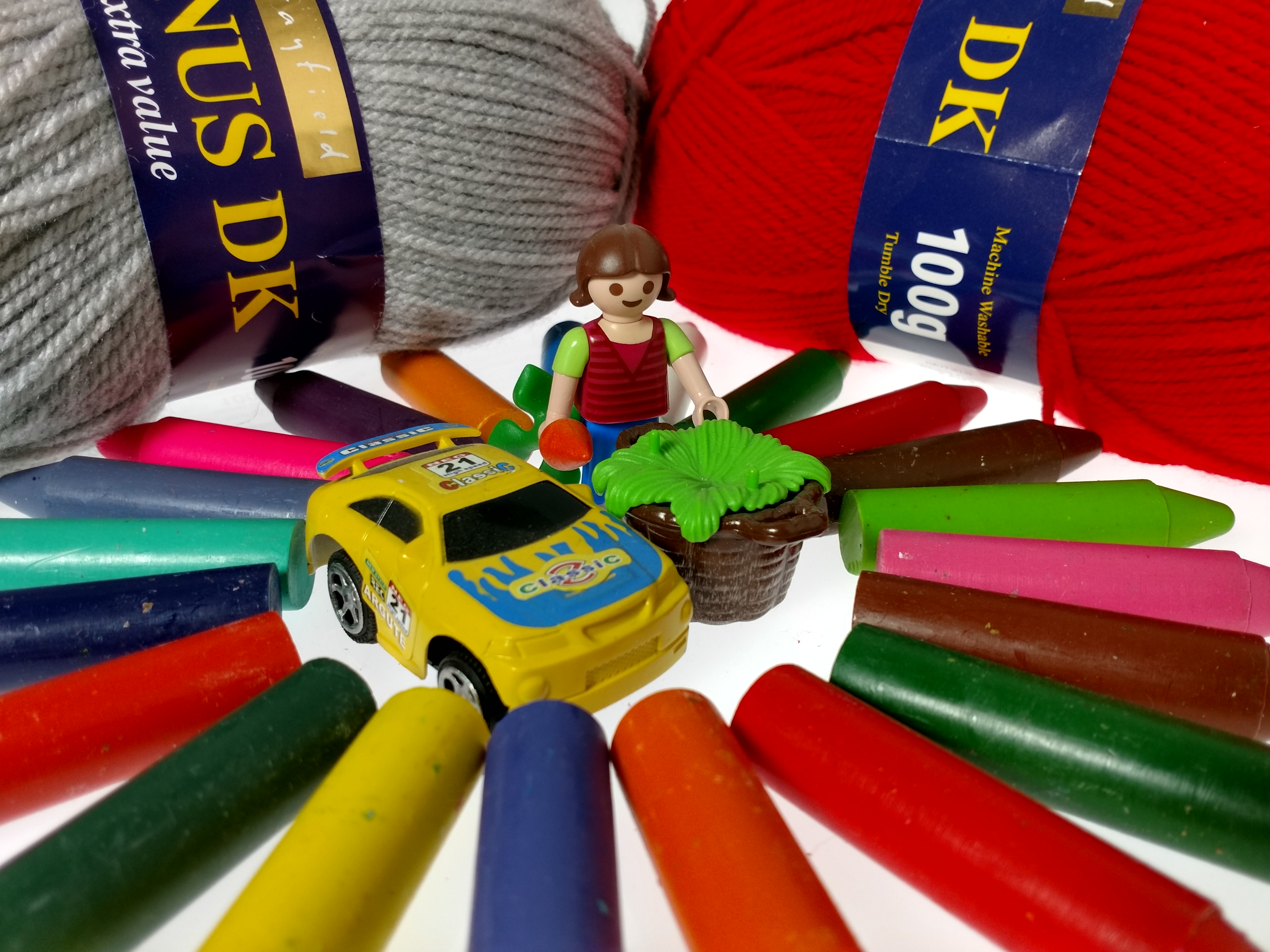
Click here to see the full resolution image
Motorola's exposure metering could do with some fine tuning, as this shot is a little underexposed. This alone wouldn’t be too bad, but combine it with slightly flat contrast and oversaturated pinks, and the Moto Z slides further down the order.
But it’s the relatively poor detail capture and a tendency to introduce a slightly painterly appearance in places that drop the Moto Z to the bottom of the pack in this test.
Samsung Galaxy S7 Edge
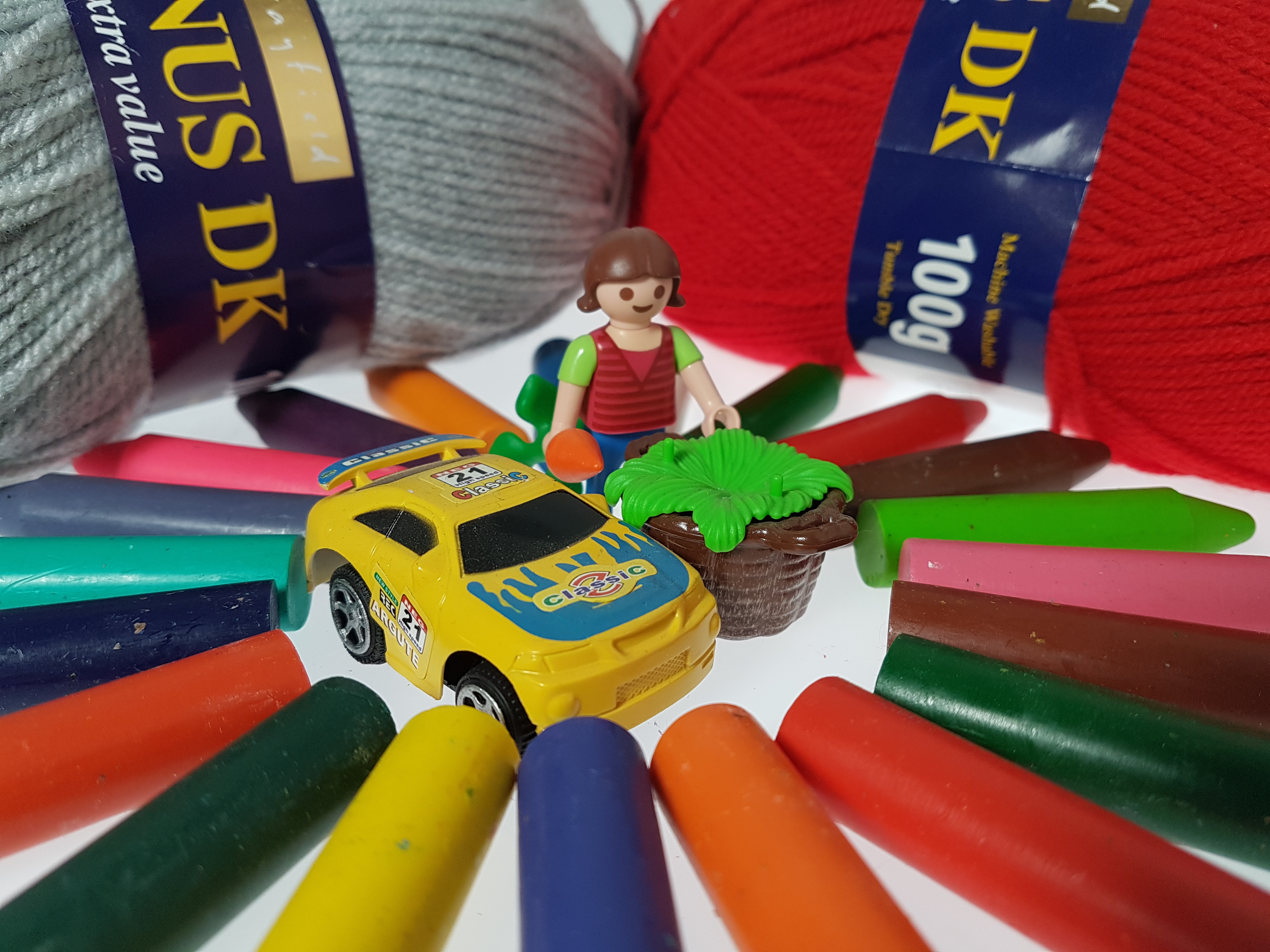
Click here to see the full resolution image
The S7 Edge manages an impressive feat here by resolving a serious amount of fine detail without producing unwanted side effects, like noise or unrealistic sharpening.
Check out the color boundaries on the toy car, which are sharp while still being smooth and natural. If we’re to be very picky, some of the colors could do with a little more saturation.
Sony Xperia XZ

Click here to see the full resolution image
Where the Xperia XZ resolved masses of detail in the landscape test with few drawbacks, the large areas of solid colors in this scene exposes the XZ’s big weakness: noise. Along with a noticeable amount of grain across areas of uniform tones, color boundaries are also gritty, where phones like the S7 Edge render them smoothly.
It’s enough to completely undo the Xperia’s high pixel count, as most of its rivals manage to capture considerably more fine detail, despite packing fewer megapixels.
Winner: Samsung Galaxy S7 Edge
Its blend of good color reproduction, excellent detail capture, and an overall smoothness, with an emphasis on clarity over unrefined sharpness, secures the S7 Edge the win here.
Runner up: Google Pixel XL
The Pixel XL again lives up to its name, with incredible sharpness, but here it’s so extreme that you may prefer something a touch smoother and less demanding on the eye.
Highly commended: HTC 10
Produces highly detailed macro shots, but noise could be better controlled.
Highly commended: Apple iPhone 7 Plus
It excels in color and contrast accuracy, but Apple, just give us a bit more detail!
With many of today’s flagship smartphones packing a serious amount of creative control, we thought we’d ditch auto mode and see if we could get even better results by switching to manual.
No winners or losers in this category - it’s just a demonstration of what can be achieved if you want to experiment.
Camera phone trivia: white balance overview
Switch on an old tungsten light bulb and the light it gives off is ever so slightly yellow, but go outside on a sunny day and by comparison, the sun’s light is actually quite a lot more blue.
This difference is easiest to see when looking at a pure white subject like paper, though your brain naturally compensates for the color difference to some extent.
A camera also needs to adjust the way it takes photographs in different lighting conditions. In a room lit by a traditional light bulb, it makes photos more blue to counteract the bulb’s yellow light, and the opposite happens outside, so colors end up staying accurate in both environments.
This adjustment of a photograph’s color is known as white balance. It’s a process that usually happens automatically at the point a photo is captured, but some cameras are slightly better at it than others.
Apple iPhone 7 Plus
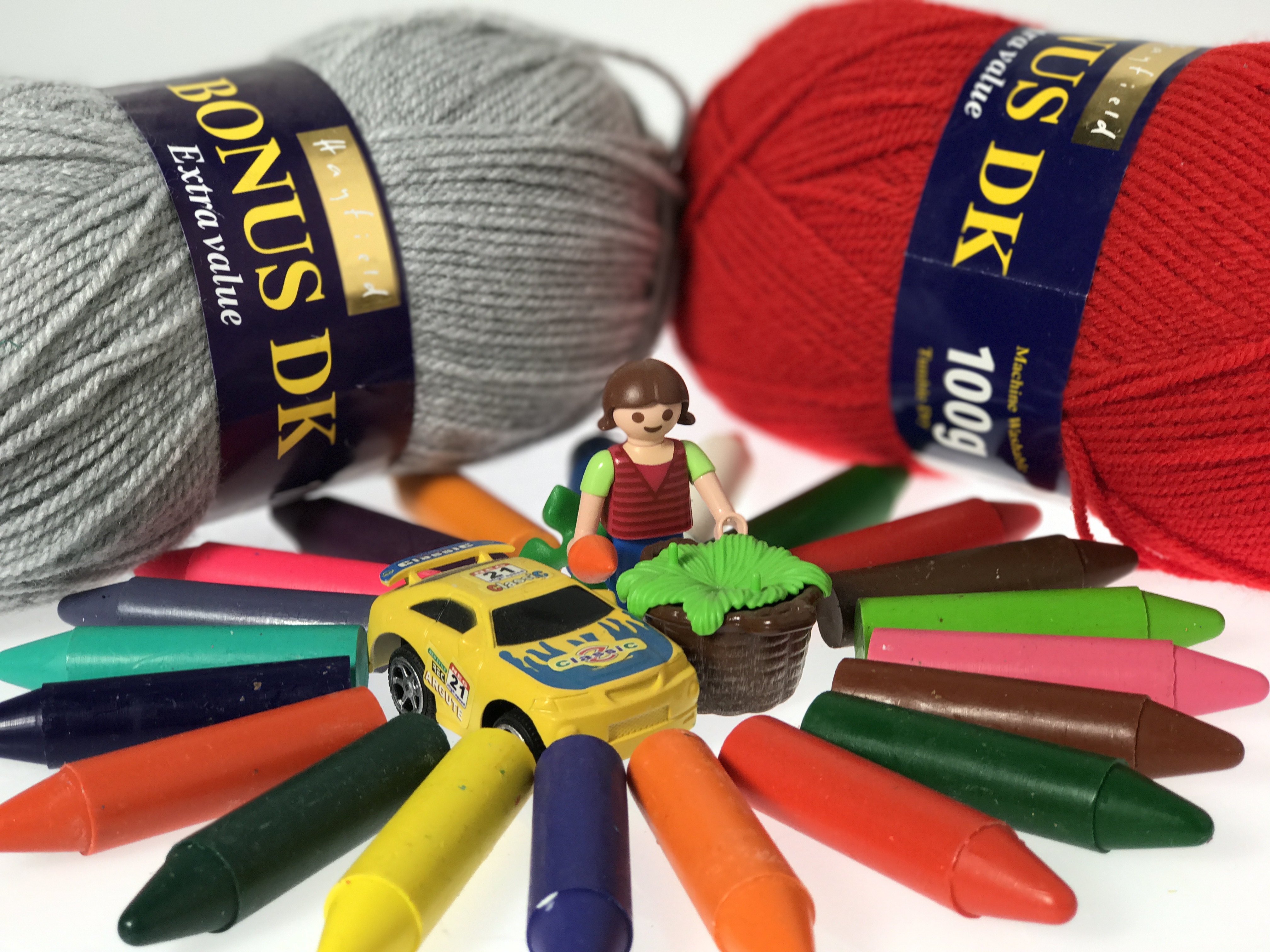
Click here to see the full resolution image
With the iPhone 7 Plus’s stock camera app lacking much manual control, we used this opportunity to try out Portrait mode. The result isn’t that convincing, but to be fair, you really need a more isolated subject for this feature to work at its best.
Google Pixel XL

Click here to see the full resolution image
Here we’ve changed to fluorescent white balance to see if this would produce better color accuracy than auto white balance managed, and forced HDR on to ensure maximum dynamic range.
HTC 10
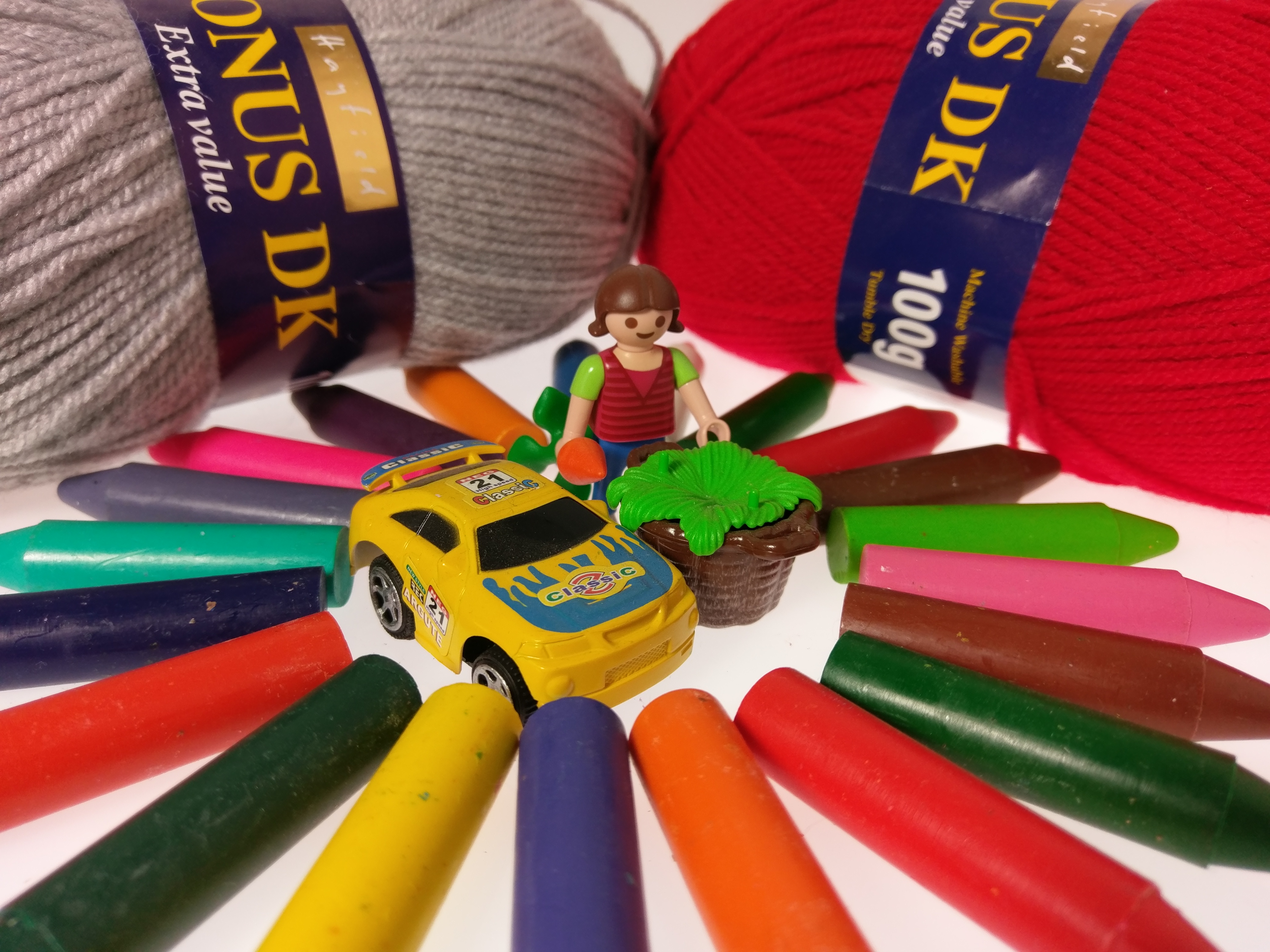
Click here to see the full resolution image
The HTC 10’s auto white balance was a touch off in default Auto mode, so this shot has been captured with white balance set to 5000k and sensitivity dropped to the minimum ISO 100 to try and eliminate image noise.
Huawei P9
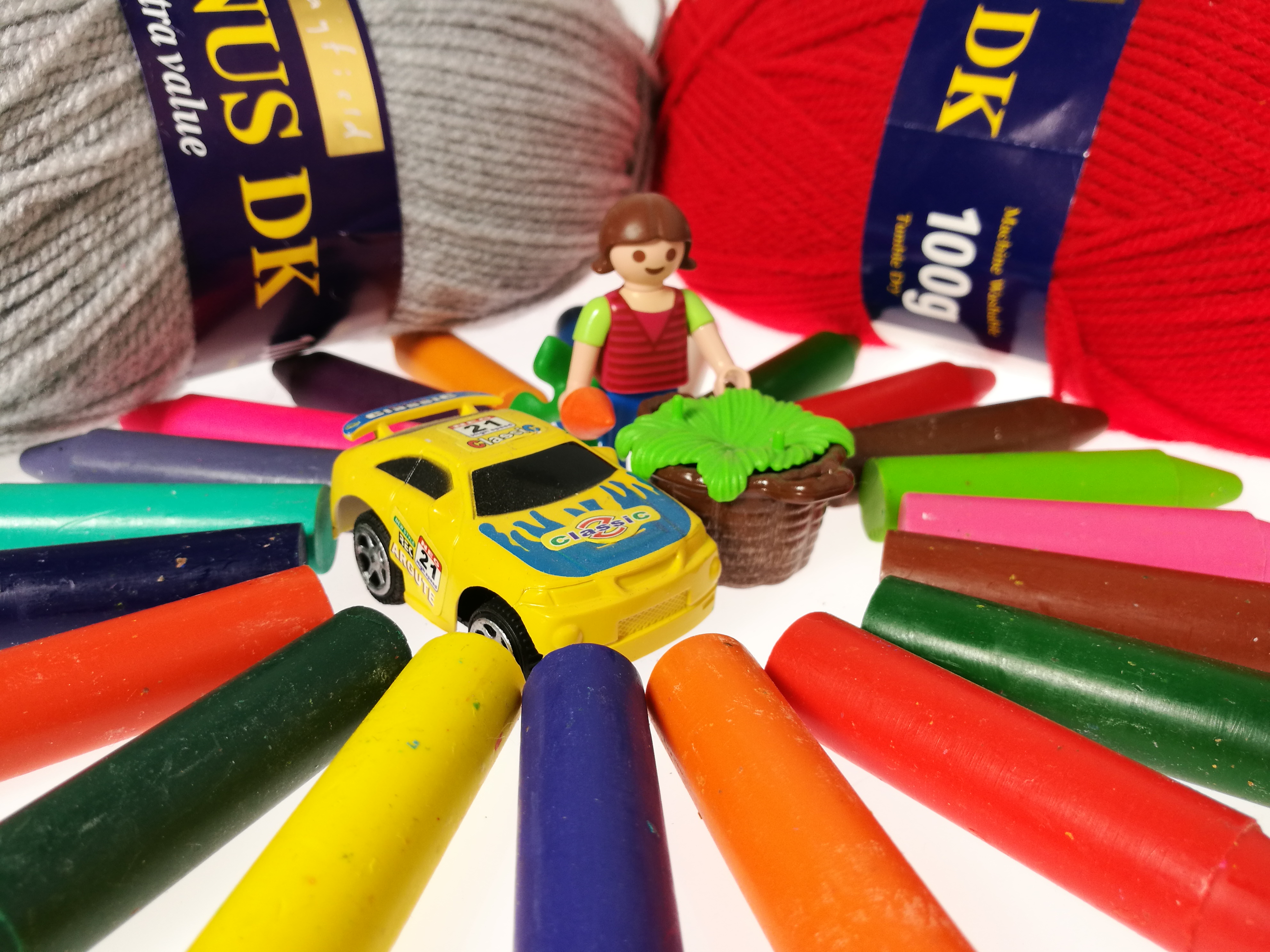
Click here to see the full resolution image
The Huawei P9’s shot looked a little warm at the same 5000k color temperature as the HTC 10, so this shot is at 4600k. Base ISO 50 sensitivity is utilized for the cleanest possible image quality.
LG G5

Click here to see the full resolution image
Many of the phones produced a very slightly too cool overall color temperature in their auto modes, hence the LG G5’s white balance has also been tweaked to 5000k to add a bit more warmth. Manual focus has ensured a precise focal point using the longer of the G5’s two lenses for less distortion.
Motorola Moto Z
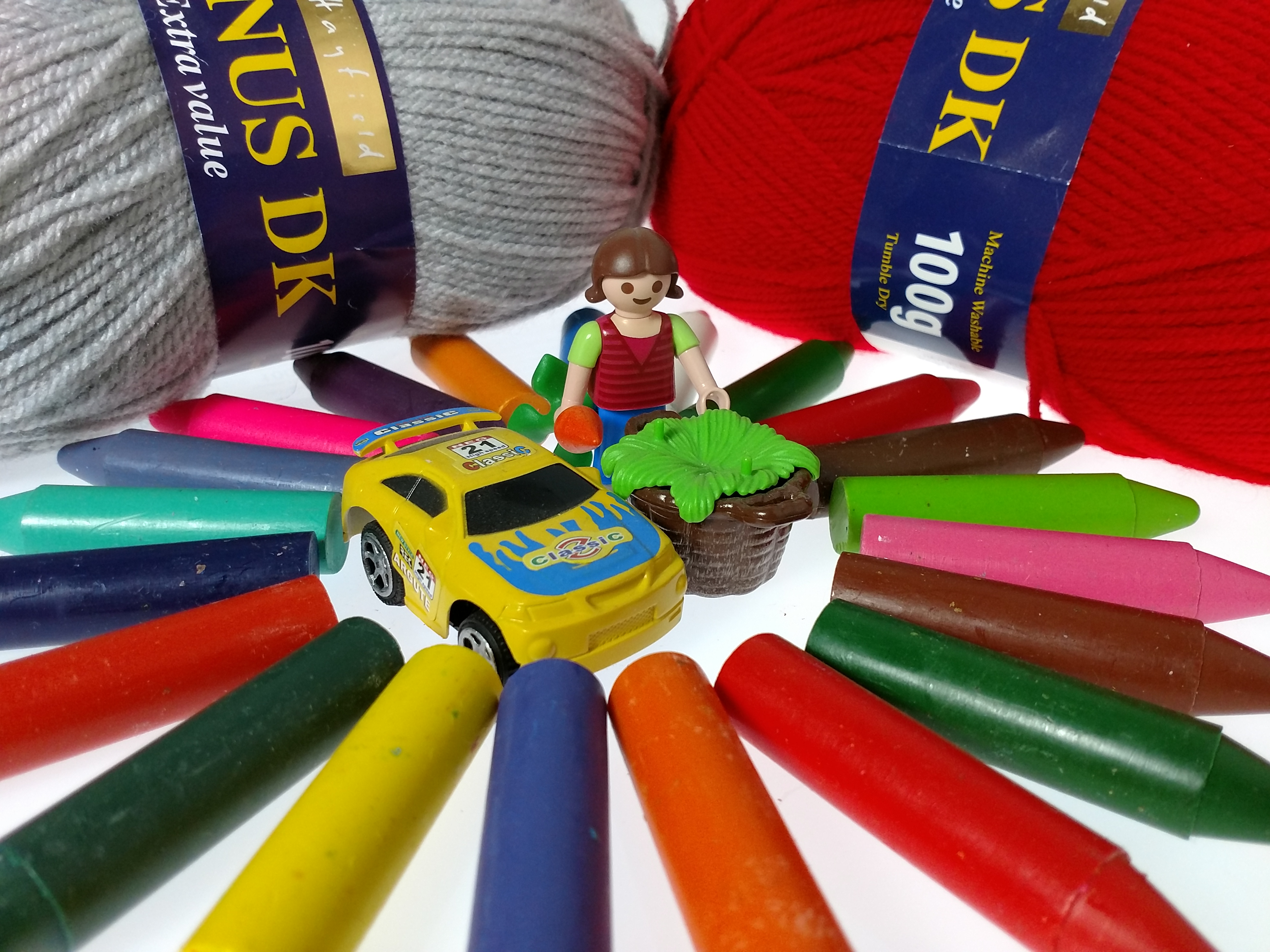
Click here to see the full resolution image
White balance was set to fluorescent here in an attempt to produce more faithful color reproduction, and the image is recorded at ISO 100 for maximum detail.
Samsung Galaxy S7 Edge
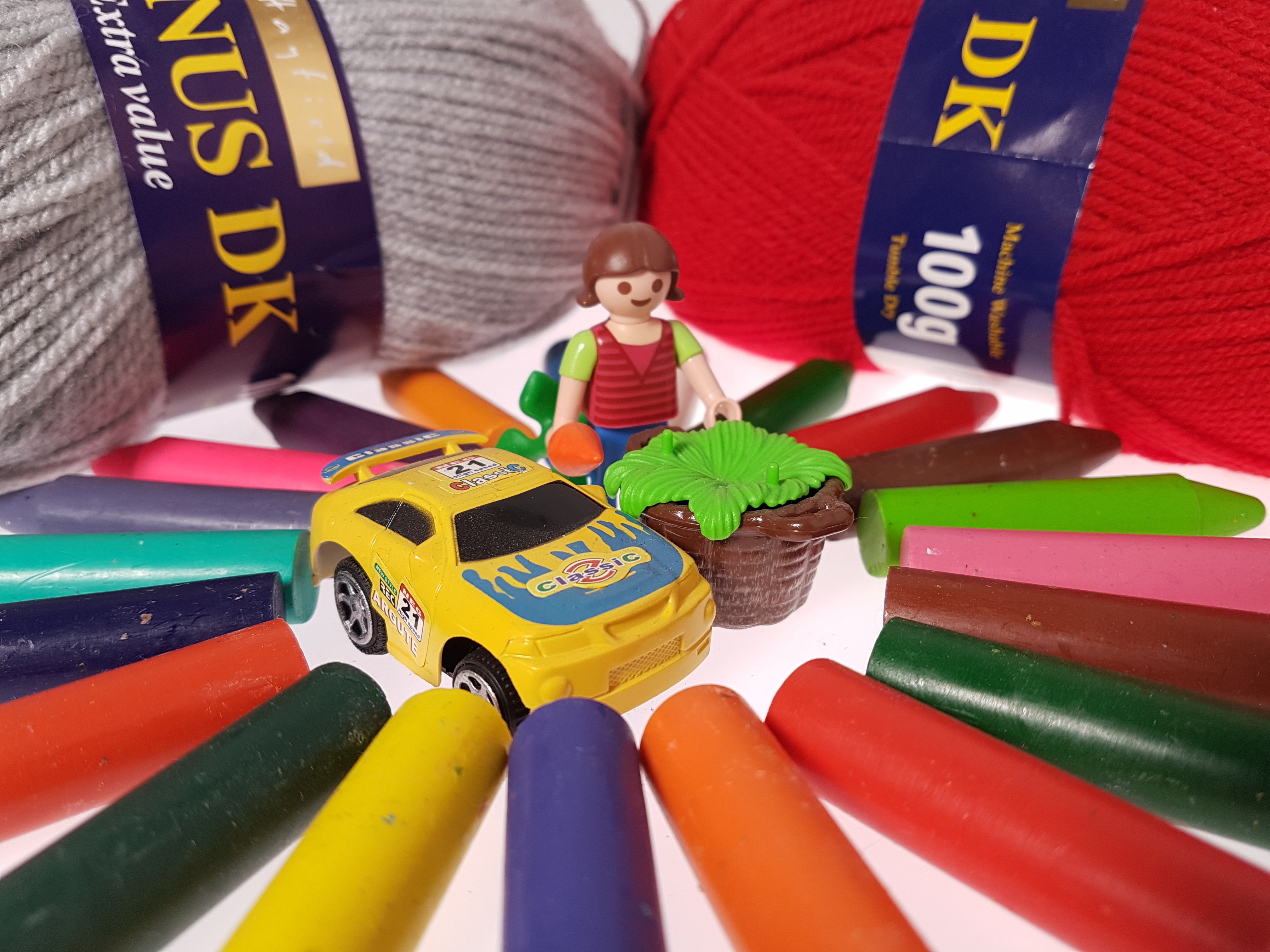
Click here to see the full resolution image
Another minimum sensitivity for maximum clarity shot, this time recorded at ISO 50. 5000k manual white balance is again used to add a bit more warmth.
Sony Xperia XZ
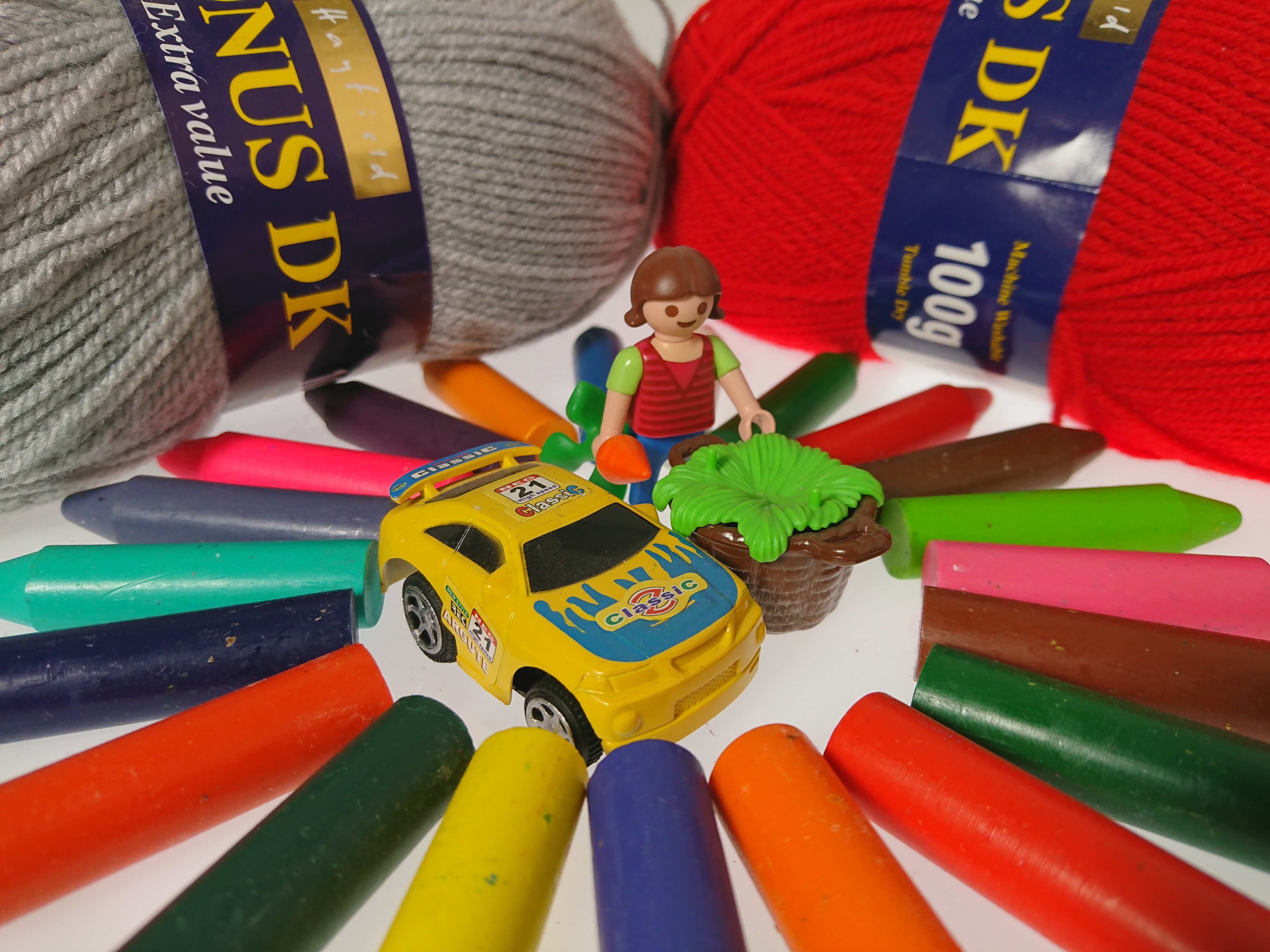
Click here to see the full resolution image
You know the drill by now: ISO 50, fluorescent white balance, and a touch of manual focus to control that all-important focal point.
This slightly wacky looking scene is specifically tailored to identify image quality weaknesses when shooting at high ISO sensitivities.
Bright colors, fine textures and a strong contrast between highlight and shadow areas provide a torture test for camera sensors.
Apple iPhone 7 Plus

Click here to see the full resolution image
Apple’s excellent color reproduction and auto white balance are clear to see here, as the iPhone 7 Plus’s image is free from any color casts, and the tricky red tones are faithfully reproduced.
But view at 100% image size and there’s a surprising about of noise reduction processing considering the shot was captured at only ISO 200. Just compare the iPhone’s shot with the Pixel XL and S7 Edge’s images, using the yellow car left of the divide as a reference point.
Google Pixel XL
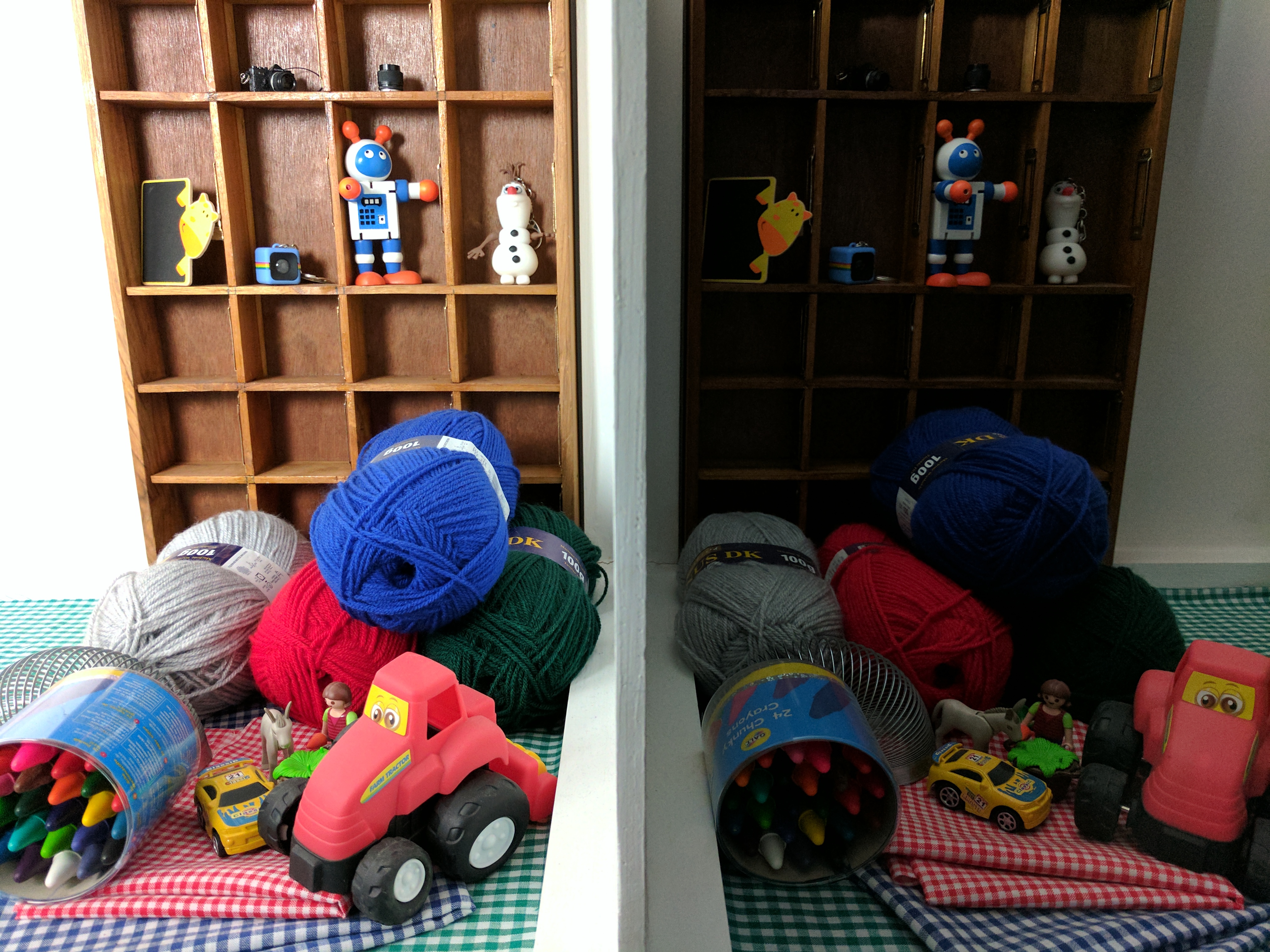
Click here to see the full resolution image
The Pixel XL has recorded this scene at a relatively high ISO 914 sensitivity, so inevitably there’s some grain noise visible under close scrutiny. However, it’s very fine and Google hasn’t attempted to mask it with noise reduction processing, so fine detail is still well retained.
View the image as a whole and the exposure is bright and attractive, though some highlight detail on the left of frame is just starting to overexpose. The red wool on this side is also a little pinker than it should be.
HTC 10
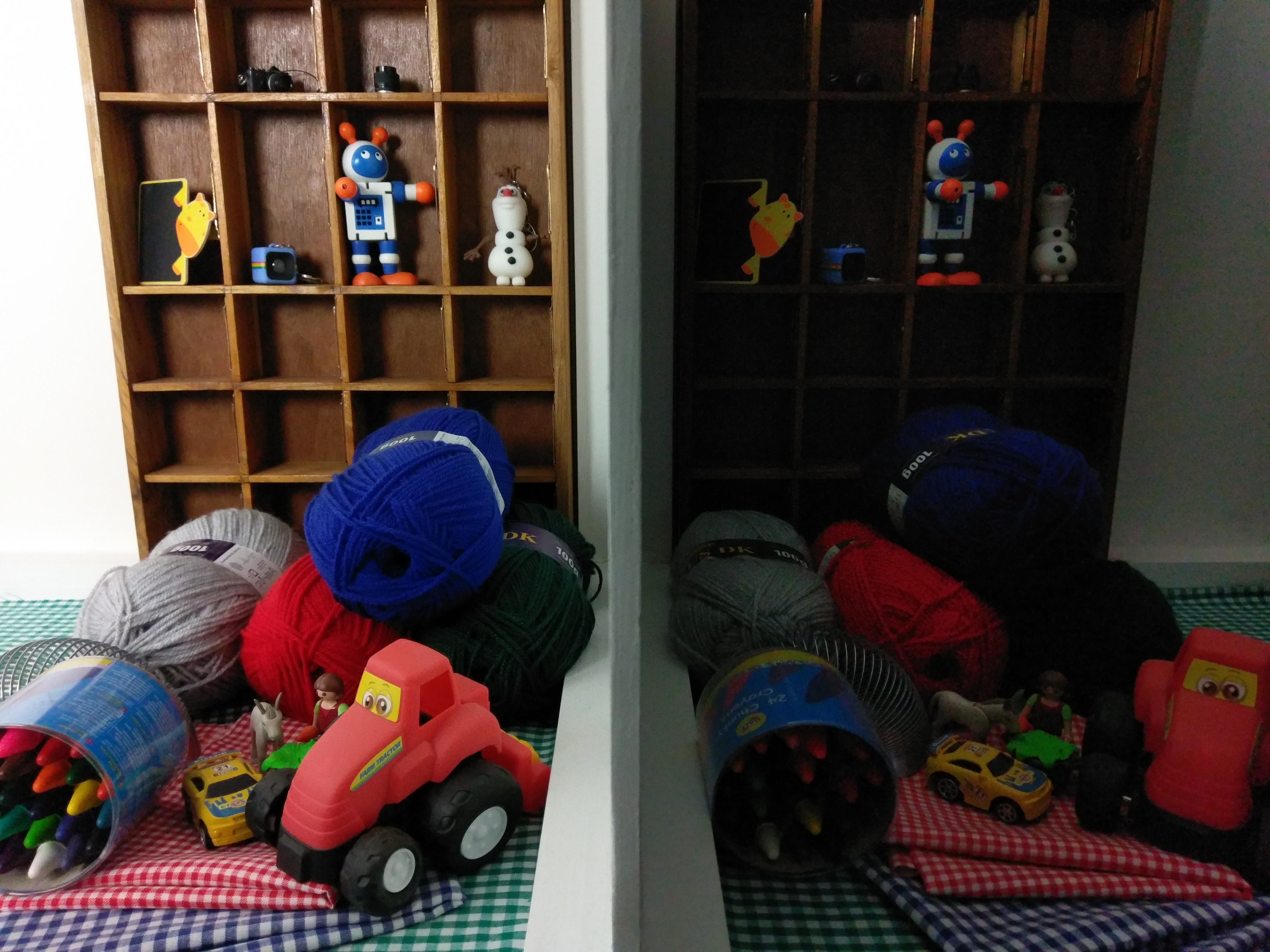
Click here to see the full resolution image
Where some of the phones here have managed to record this scene at a low sensor sensitivity, the HTC 10 has resorted to ISO 800.
That’s introduced quite a lot of noise (especially visible on the far right of frame), and though HTC’s noise reduction isn’t too intrusive, it’s harsher than the Pixel’s and consequently some fine detail has been smoothed away. Color reproduction is pretty good though, and the exposure metering is spot on.
Huawei P9
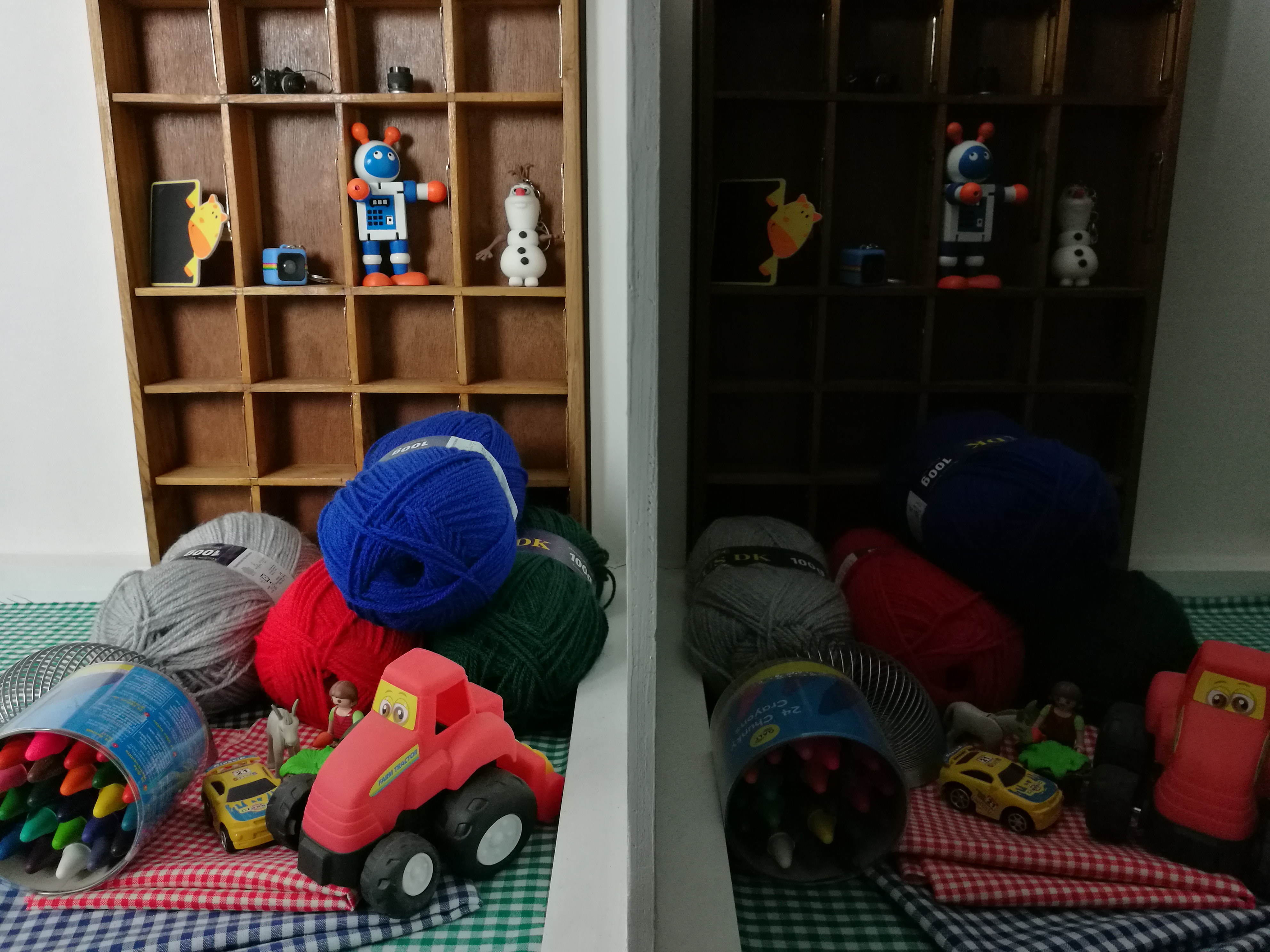
Click here to see the full resolution image
The Huawei P9 delivers a solid performance here, with well controlled noise at ISO 400, accurate color rendition and a balanced exposure. It just loses out to the S7 Edge and Pixel XL due to marginally lower levels of fine detail.
LG G5
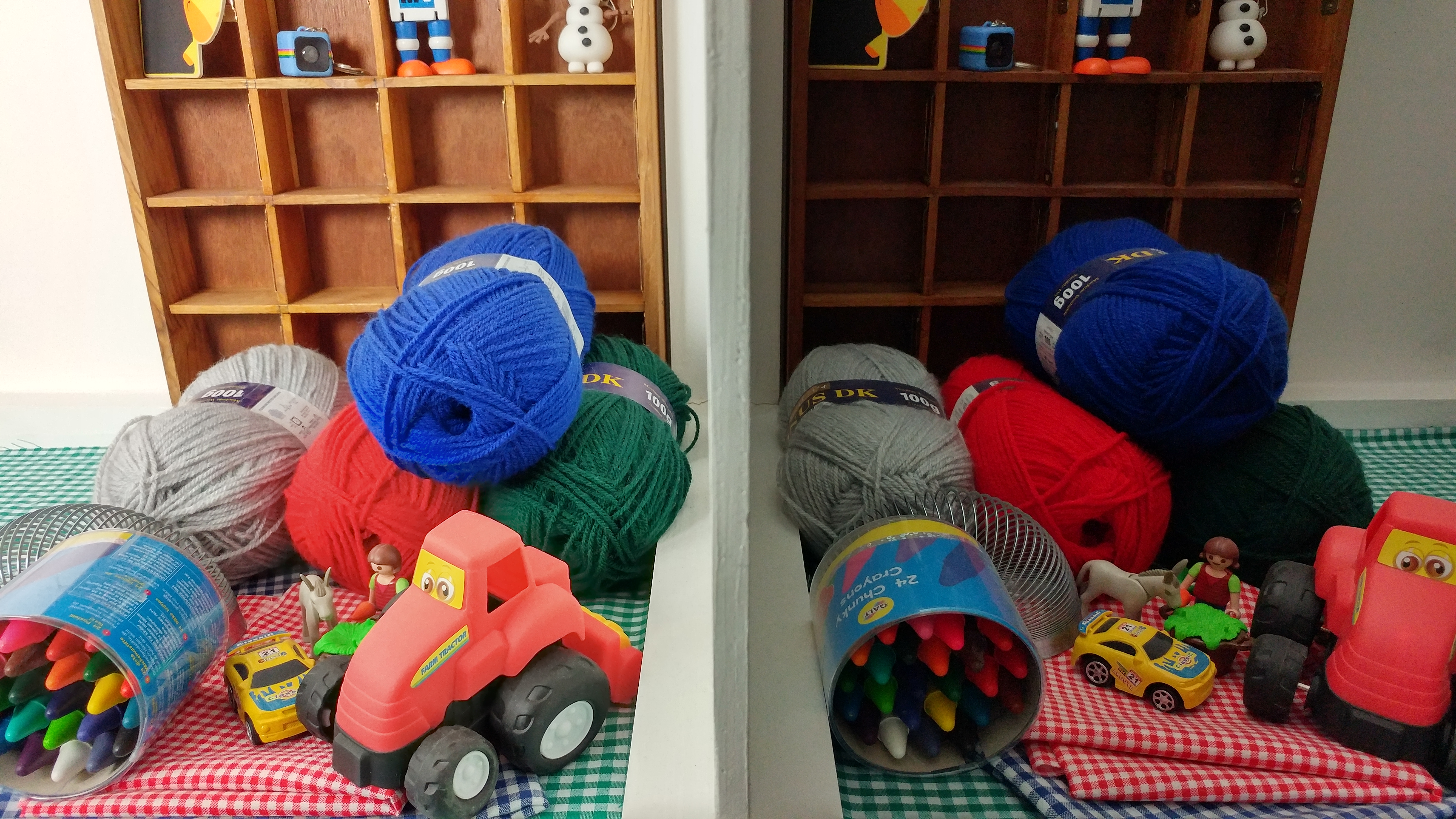
Click here to see the full resolution image
It’s likely that the LG G5’s HDR setting was left active for this shot, explaining the abnormally wide dynamic range and the red wool that’s a bit too pale. The G5 has plumped for a middling ISO 400 sensitivity and noise is very well controlled.
This sensitivity seems to be the upper limit of the G5’s acceptable noise levels though, as things are much worse at ISO 800. Detail is well preserved and the shot is sharper than the P9’s, but the G5’s painterly rendering of the wool texture lets it down.
Motorola Moto Z
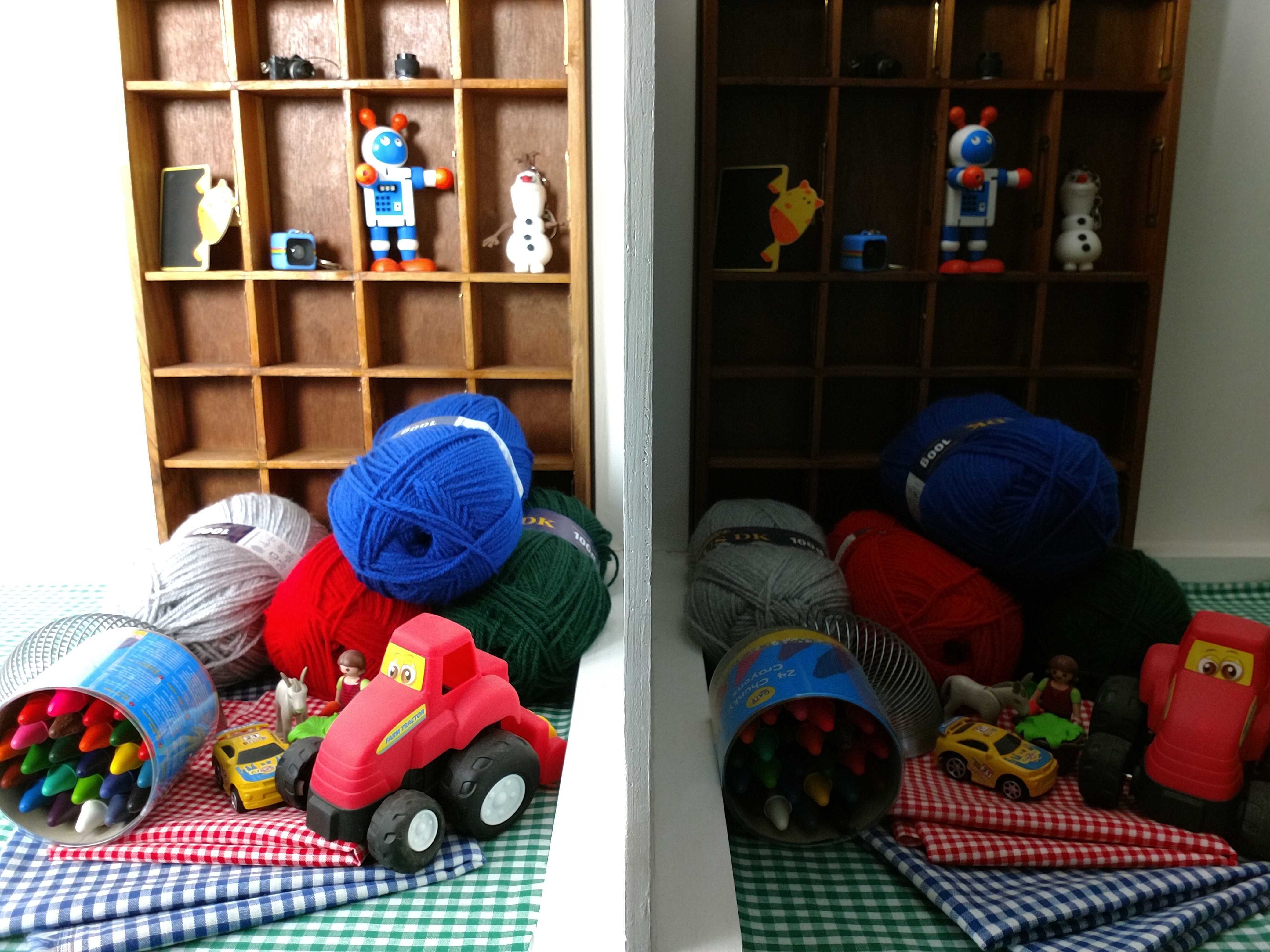
Click here to see the full resolution image
This test exposes the Moto Z’s relatively poor dynamic range. Highlights at the left of frame are blown, and this extends to the red wool which has also lost a lot of definition, yet there’s no extra shadow detail on the right of frame to compensate.
At least there’s very little noise in this ISO 500 image, but detail is still soft, with the highlights on the silver slinky right of the divide failing to pop like they do in the S7 Edge and Pixel XL’s shots.
Samsung Galaxy S7 Edge

Click here to see the full resolution image
With its large f/1.7 lens aperture, the S7 Edge has been able to use just ISO 250 here. Noise levels are low and detail high, plus unlike the Pixel XL, the S7 Edge has got the exposure nailed, although this does make the shadow areas a bit darker.
Color accuracy is mostly good, but auto white balance isn’t quite correct as the overall color temperature is marginally too cool.
Sony Xperia XZ
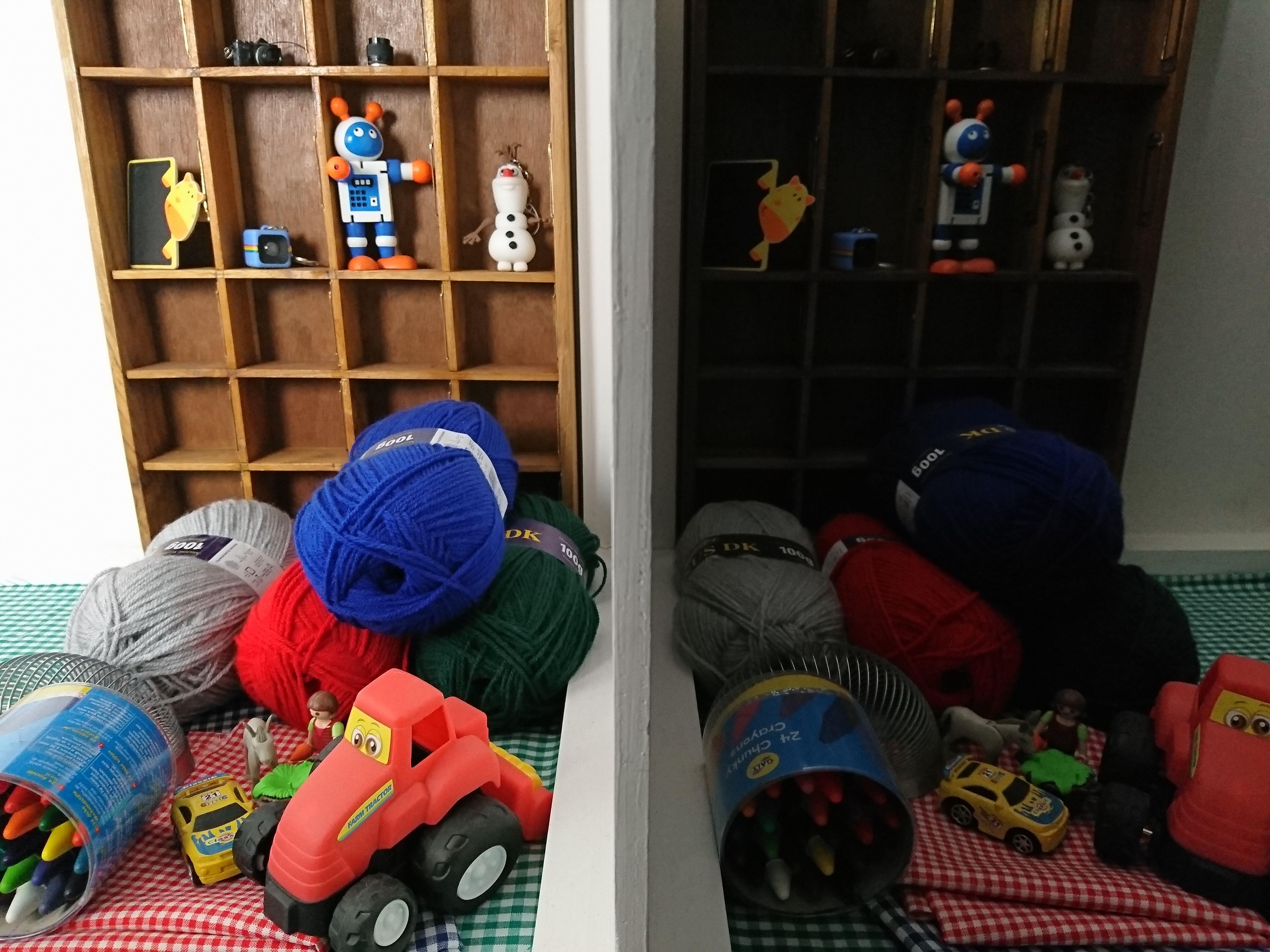
Click here to see the full resolution image
Lastly, here’s proof that more doesn’t always mean better. The Xperia XZ’s 23MP sensor has produced a much larger image than the S7 Edge’s, but detail is way lower.
Noise isn’t actually too bad at ISO 320, but color saturation in the shadow areas is nothing special. Plus points? Exposure metering and white balance are very accurate.
Winner: Samsung Galaxy S7
Barely beaten by the Pixel XL in terms of outright detail, the S7 Edge edges into the lead thanks to its superior color reproduction and exposure metering.
Runner up: Google Pixel XL
A stellar result considering the Pixel XL’s shot was captured at ISO 914 compared to the S7 Edge’s ISO 250. Google’s auto white balance is also marginally more accurate than Samsung’s here.
Highly commended: Huawei P9
A phone that ticks all the right boxes, but is marginally outclassed by exceptional rivals.
Highly commended: LG G5
Superb dynamic range really helps the G5 in low light, though more detail would be welcome.
Same scene, this time with added illumination from each phone’s built-in flash.
A strong flash means a shot can be captured with a lower ISO sensitivity, and therefore image noise should be reduced and detail increased.
Apple iPhone 7 Plus
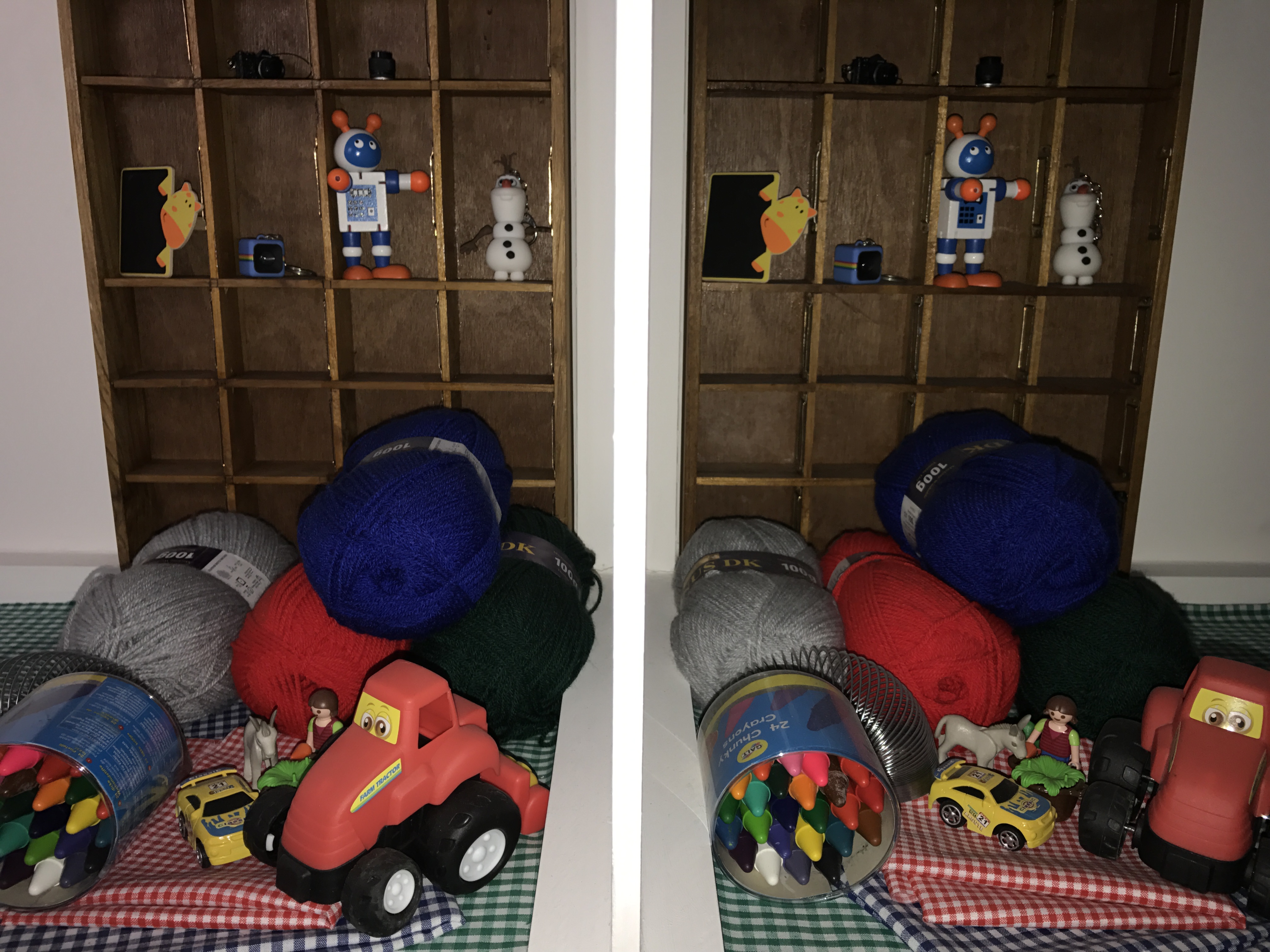
Click here to see the full resolution image
The iPhone’s flash seems a little down on power compared to the S7 Edge’s, which may explain the drab color saturation of the wood at the back of the shot.
Detail isn’t as lacking as it is in some of our tests though, with fine textures on the gingham fabric swatches being rendered quite well, but the S7 Edge still captures noticeably more detail. As always, color accuracy is first class.
Google Pixel XL
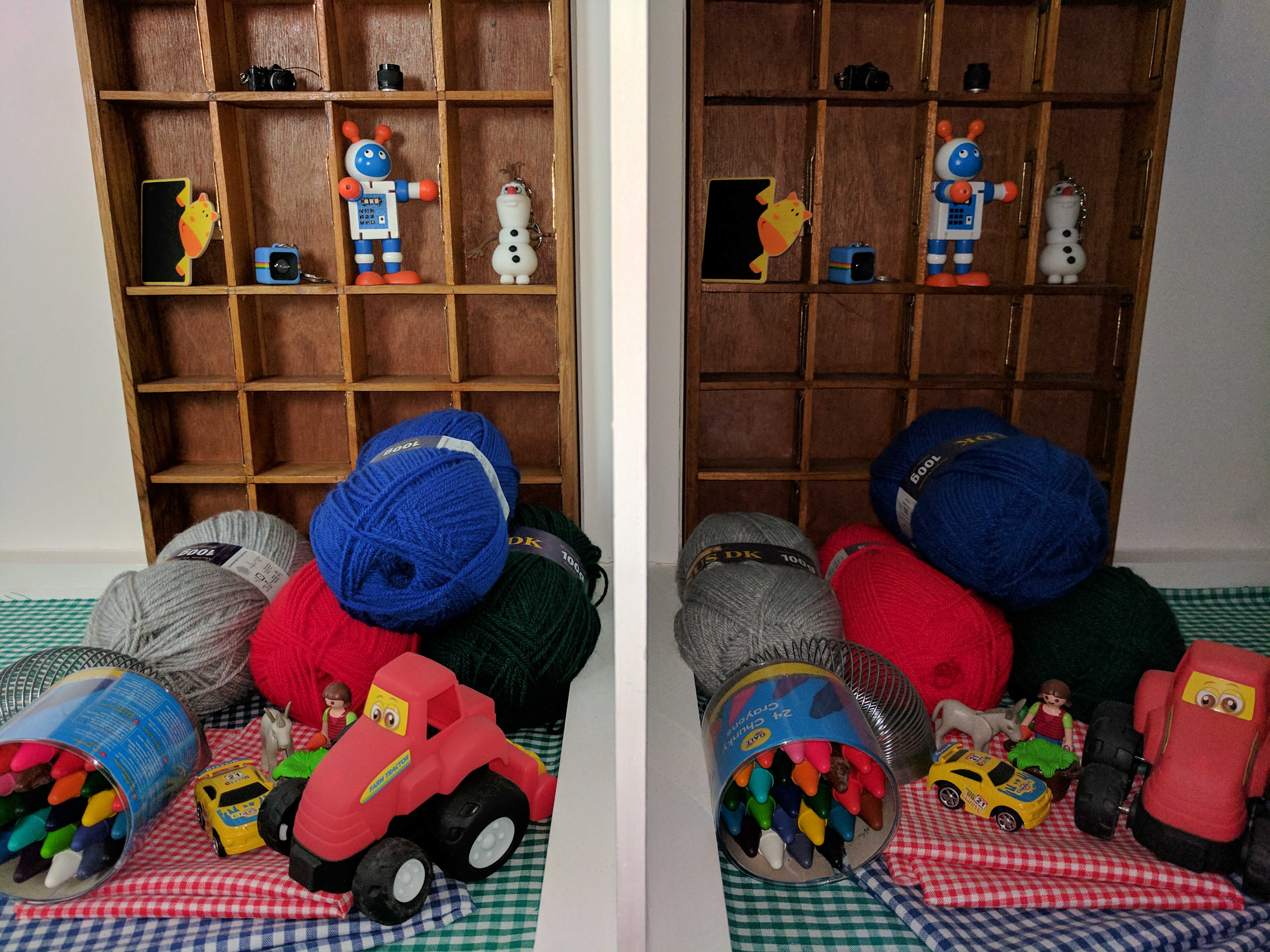
Click here to see the full resolution image
With its flash enabled, the Pixel XL’s result is much less convincing. Despite being recorded at roughly half the ISO sensitivity of the non-flash shot, grain is still quite pronounced, though it is very fine and not too intrusive.
The camera again has some trouble rendering red tones, which are a touch too pink, though metering is much improved and there’s no sign of highlight overexposure.
HTC 10
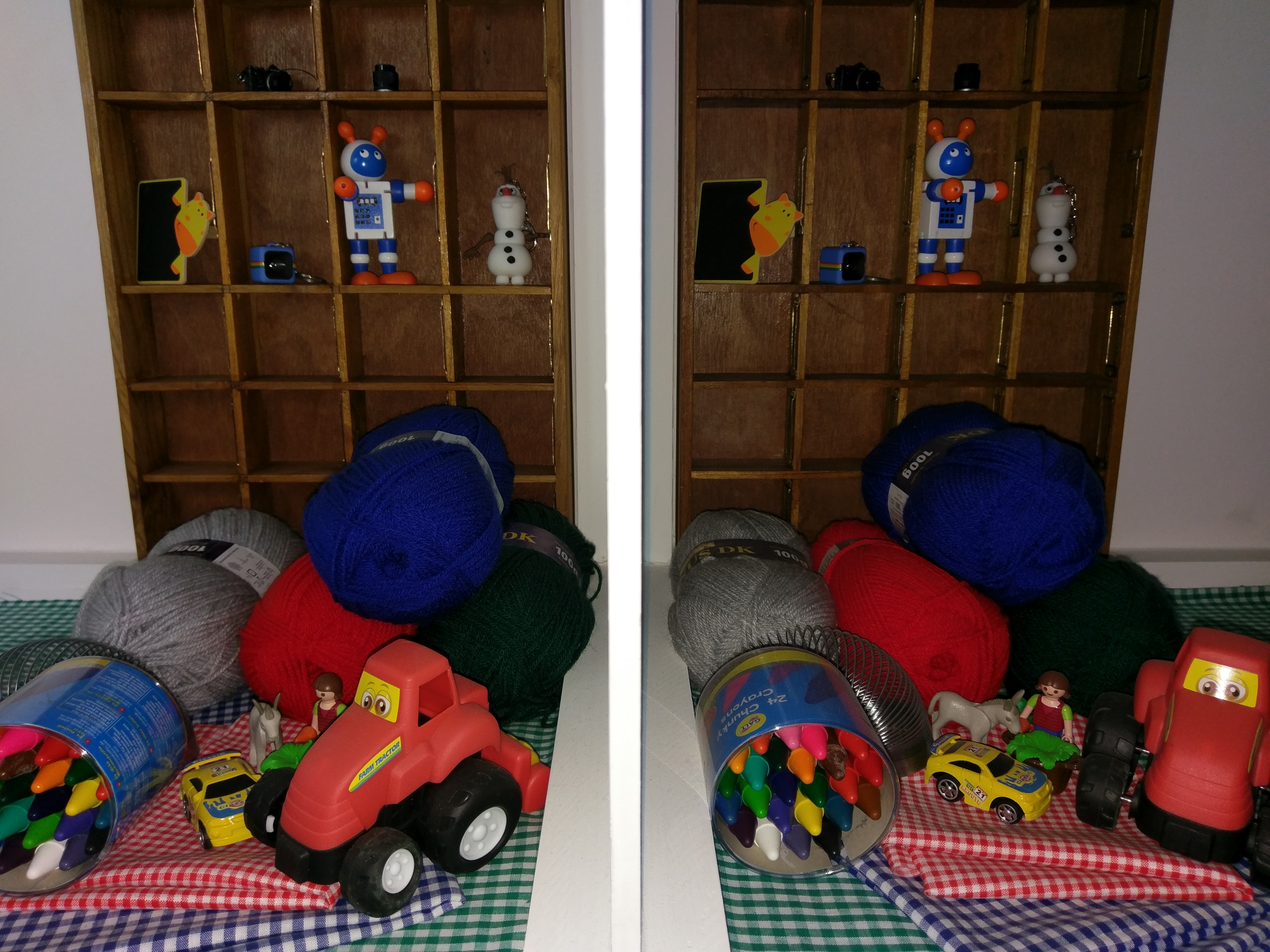
Click here to see the full resolution image
Comparing the chequered texture on the fabric swatches reveals the HTC 10 isn’t quite a match for the S7 Edge in terms of outright detail, and its slightly painterly rendition of the gray wool to the left of frame could do with improvement. But respectable noise levels, good sharpness and decent color accuracy go in HTC’s favor.
Huawei P9
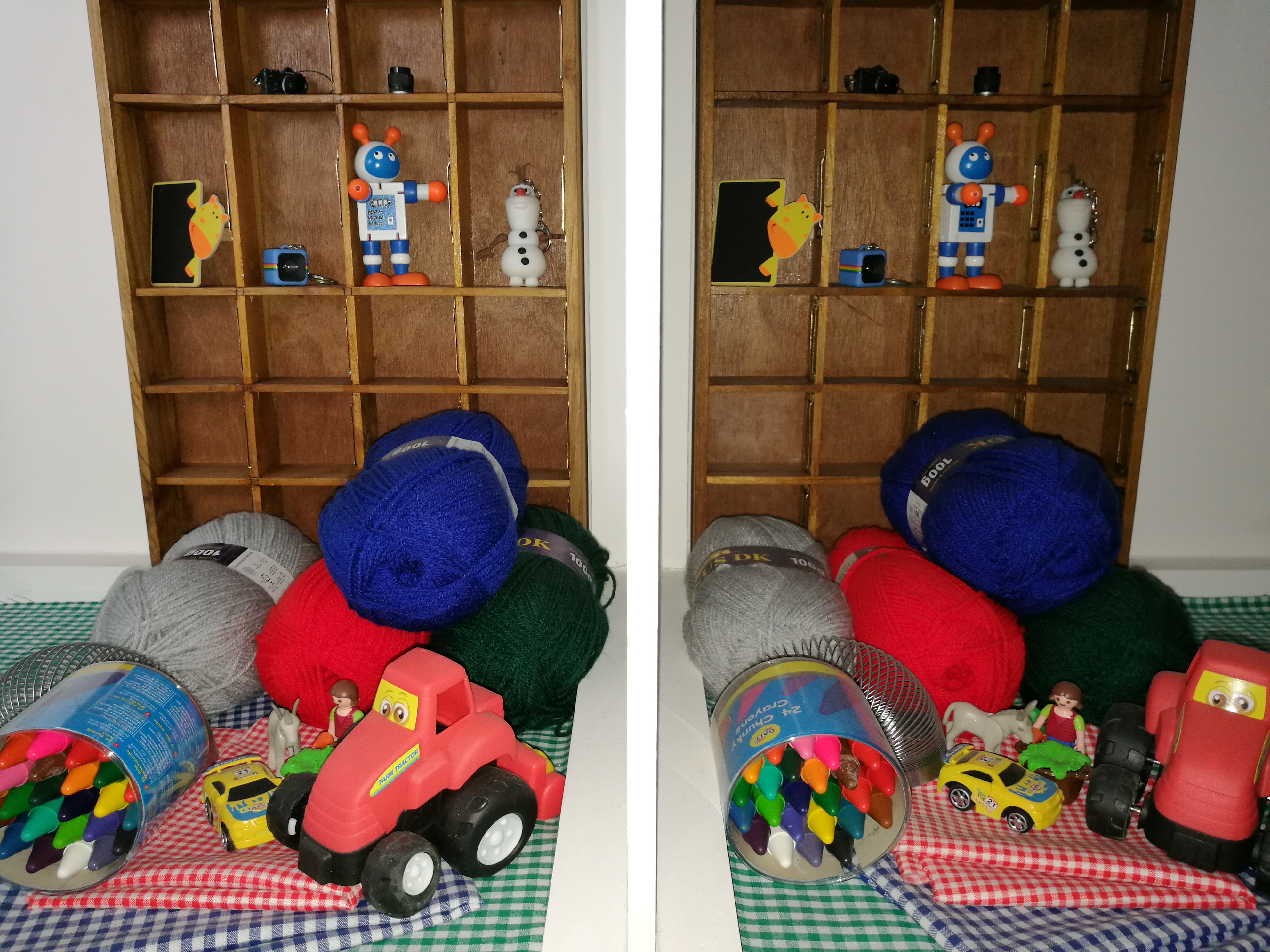
Click here to see the full resolution image
It’s another solid performance from the Huawei P9, as it delivers great color and white balance. Compared to the S7 Edge, definition in the wool could be better and the image as a whole isn’t the sharpest, but the P9 is right up there in this test.
LG G5
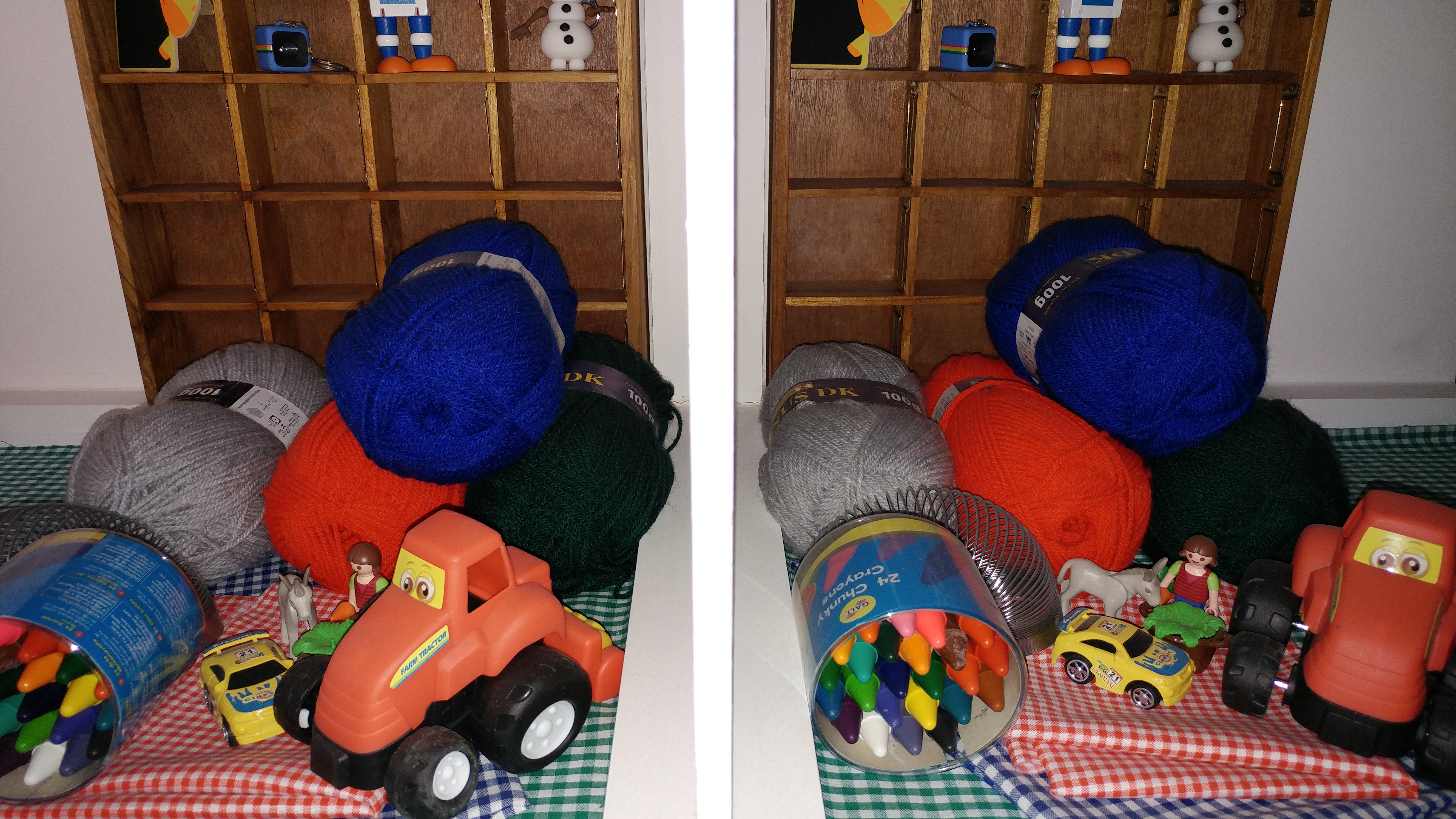
Click here to see the full resolution image
Straight away it’s clear that the LG G5 has had trouble reproducing red tones, as they’re too orange. LG’s flash isn’t short on power though, as darker items on the right of the divide are just as well lit as in the S7 Edge’s image.
Note that the limited vertical field of view is due to having to reframe the shot to keep the left and right edges of frame consistent and compensate for the G5’s wider field of view. This has brought the phone physically closer to the subject, which has helped it resolve a lot of detail, though it’s an advantage that hasn’t prevented the wool from looking painterly.
Motorola Moto Z
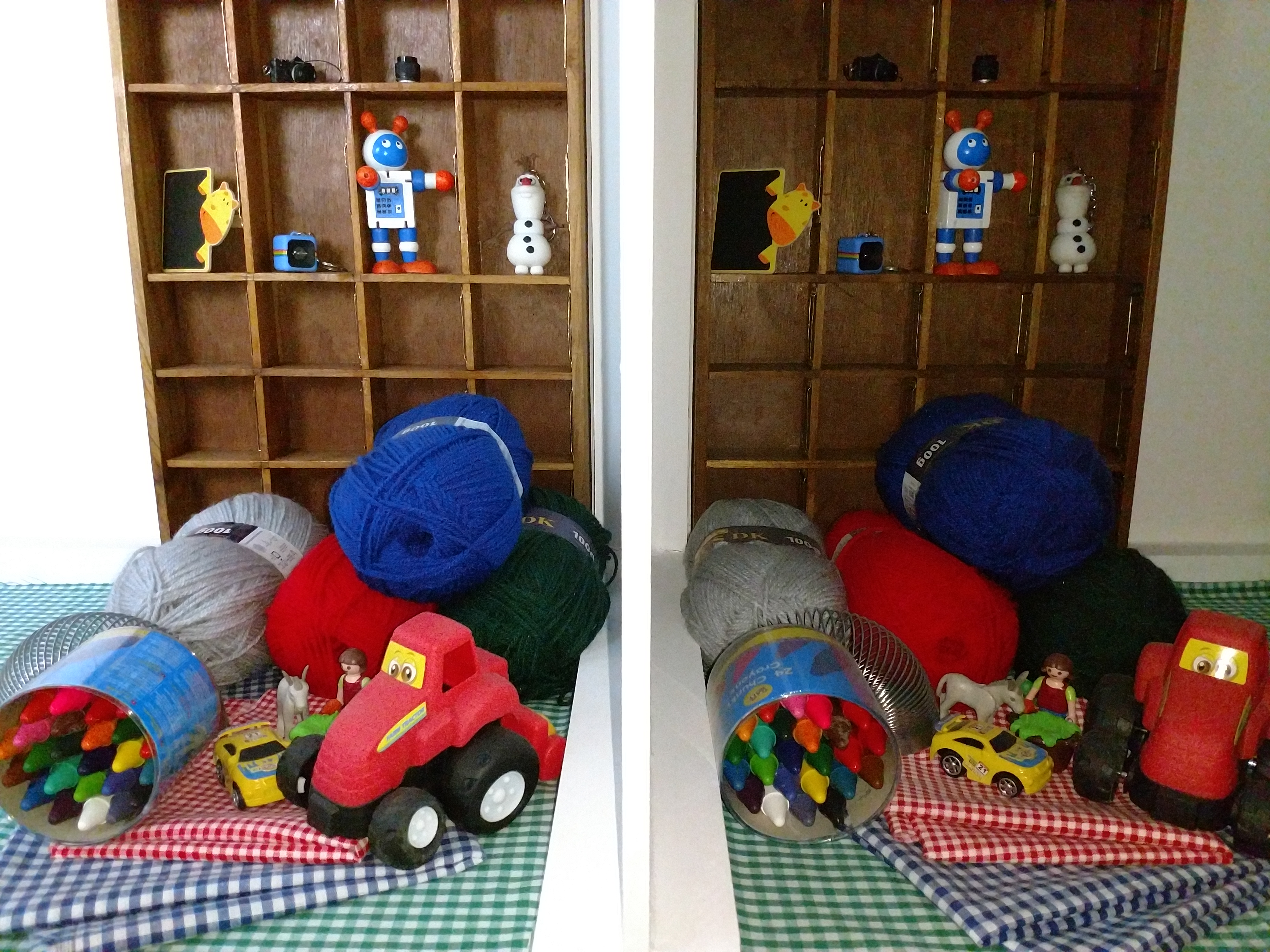
Click here to see the full resolution image
There isn’t much wrong with the Moto Z’s shot at first glance - color accuracy is pretty good, though white balance is a tad warm - but enlarge to 100% and it all falls apart. Clearly Motorola’s flash is down on power, as despite using an f/1.8 aperture, ISO 1600 was required to maintain a bright exposure.
That’s meant plenty of noise, and with it some extreme noise reduction processing which has ruined fine detail to a point where the image may as well have been painted with a brush.
Samsung Galaxy S7 Edge
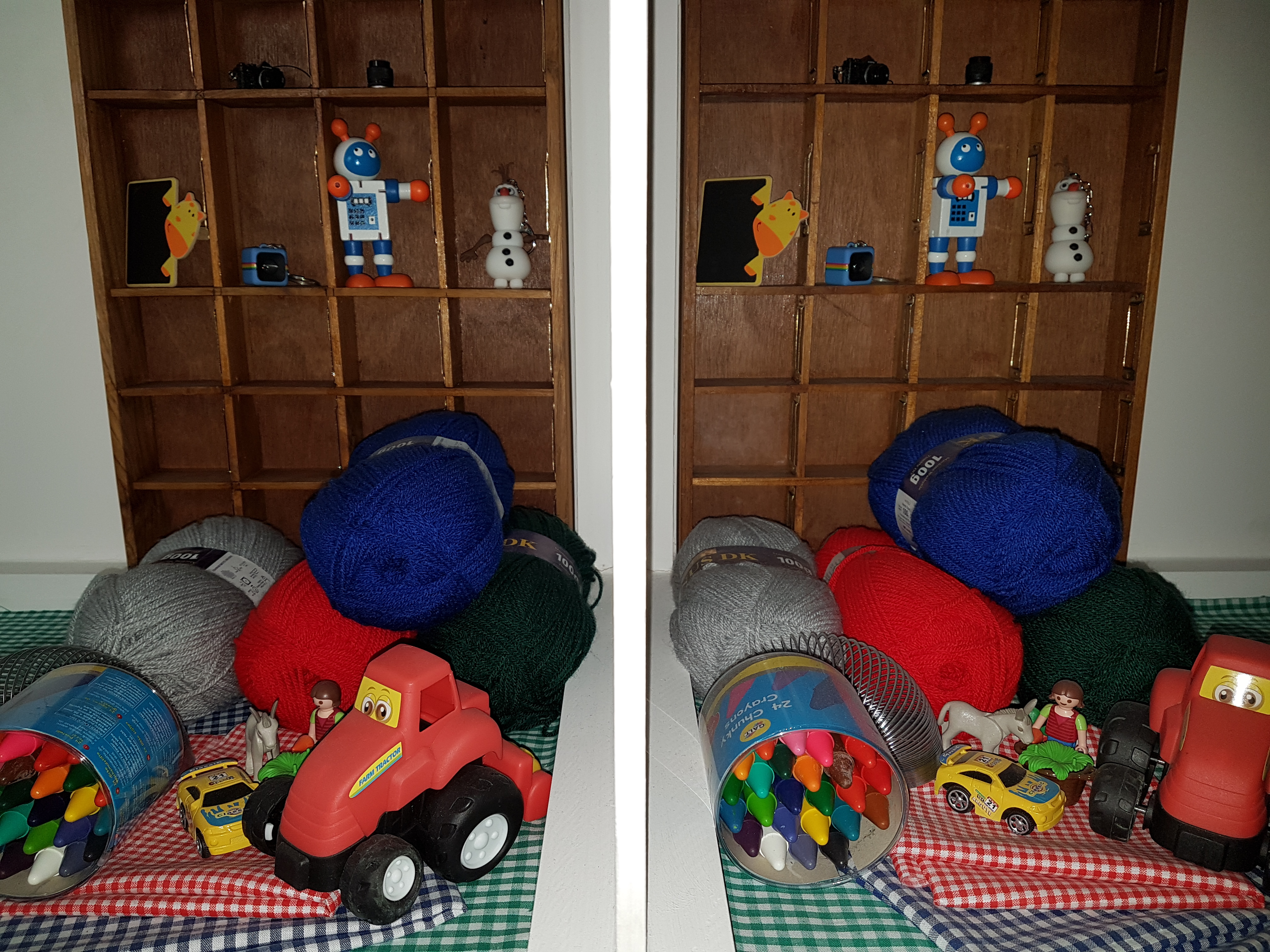
Click here to see the full resolution image
With its powerful flash and f/1.7 lens, the S7 Edge has been able to record its image at just ISO 50, so it’s little surprise that detail is superb and noise non-existent. Add faultless color reproduction, and the S7 Edge is a clear winner in this test.
Sony Xperia XZ
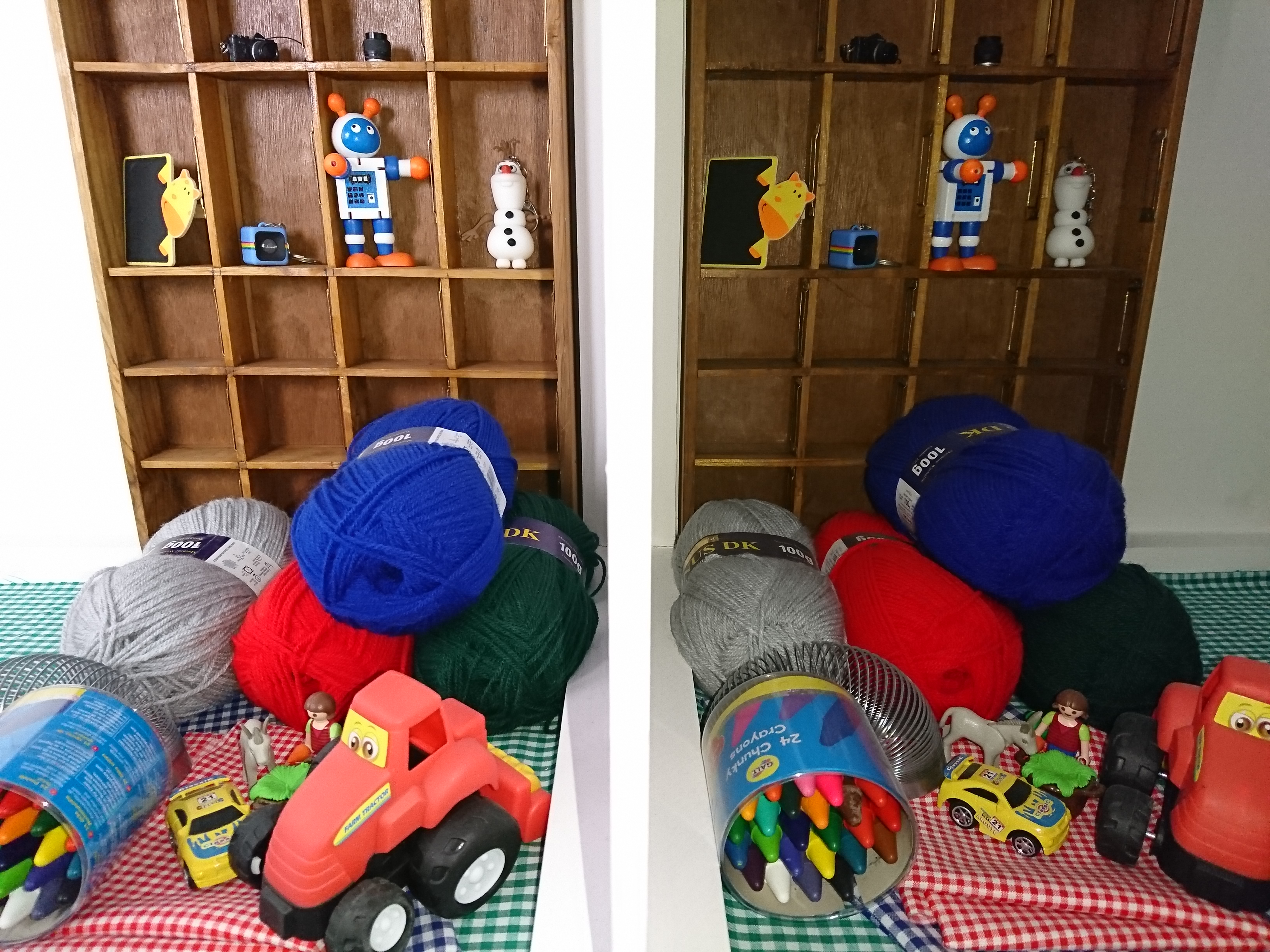
Click here to see the full resolution image
Sony’s effort is a similar story to the Moto Z’s - good at first glance, but less so under closer scrutiny.
The overall exposure is bright, auto white balance is bang on, and color reproduction is near perfect. Zoom in though and again the Xperia XZ’s extra megapixels aren’t being put to good use, such is the noise and lack of detail in this ISO 500 shot.
Winner: Samsung Galaxy S7 Edge
Class-leading flash power enables the S7 Edge’s sensor to work at its best in low light, resolving masses of detail.
Runner up: Huawei P9
The P9’s image isn’t as detailed as the S7 Edge’s, but apart from that it’s hard to fault.
Highly commended: HTC 10
A good result, just slightly noisier and more painterly than Huawei’s effort.
Highly commended: LG G5
Bright, punchy and detailed, though those red tones aren’t the most accurate.
ISO 800 is the highest manually-selectable sensitivity on the Galaxy S7 Edge, and it’s high enough to put the small sensors in smartphones through their paces to see how they deal with low light image noise.
The iPhone 7 Plus is absent here, as its native camera app doesn’t allow manual ISO control. The Pixel XL does scrape in though, as though its app also lacks manual control, auto ISO picked ISO 914 for this shot, over qualifying it for the test.
Best camera phone trivia: ISO explained
Put simply, the job of the millions of pixels on a digital camera sensor is to gather light. The amount of light they can detect at any one moment can be changed though, so on a sunny day the pixels can be set to not be very light-sensitive at all, as the sun is throwing plenty of rays around.
However, in a dark room they need to be super-sensitive in order to gather as much of the limited available light as possible. Trouble is, just as our view isn't exactly crystal clear in a dimly lit room, a hyper-sensitive camera sensor also has trouble seeing in the dark, and it makes mistakes. These show up collectively as image noise, such as grain and unwanted specs of color.
The difference between the least light sensitive sensor setting and its most sensitive state is measured on a standardized scale known as the ISO scale. ISO 50 is usually the lowest sensitivity setting, and most smartphones top out at a maximum sensitivity of ISO 3200. At this setting, a sensor is able to gather 64 times as much light as it could at ISO 50, but with that trade-off of reduced image quality.
Google Pixel XL
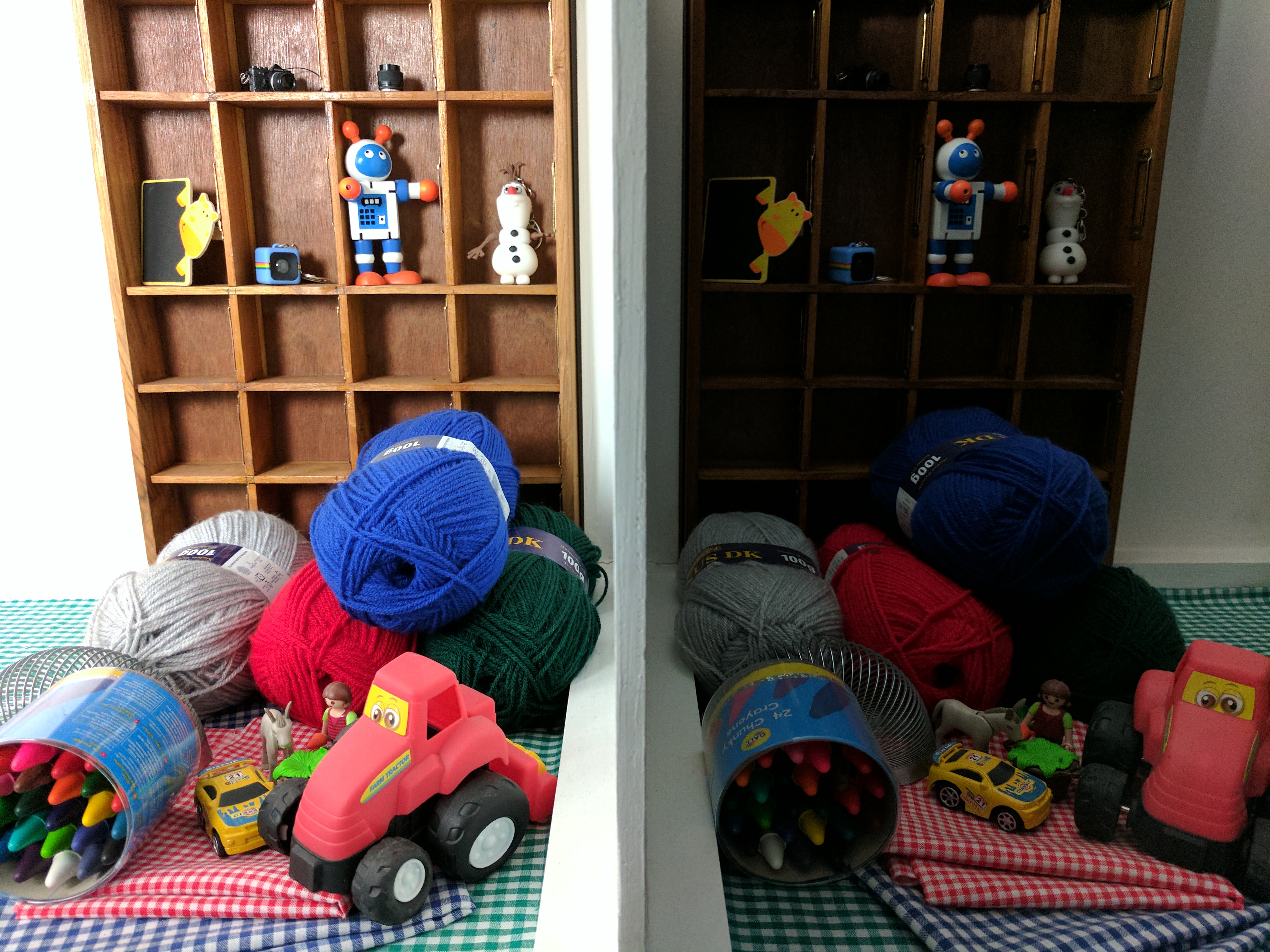
Click here to see the full resolution image
Despite using a sensitivity higher than required for this test, the Pixel’s shot is impressively clear of noise.
Detail is very well resolved across the shot, equalling the sharpness of the P9’s image, but Google just loses out to Huawei due to the Pixel’s slightly inaccurate reproduction of the red wool and its minor overexposure of highlights.
HTC 10
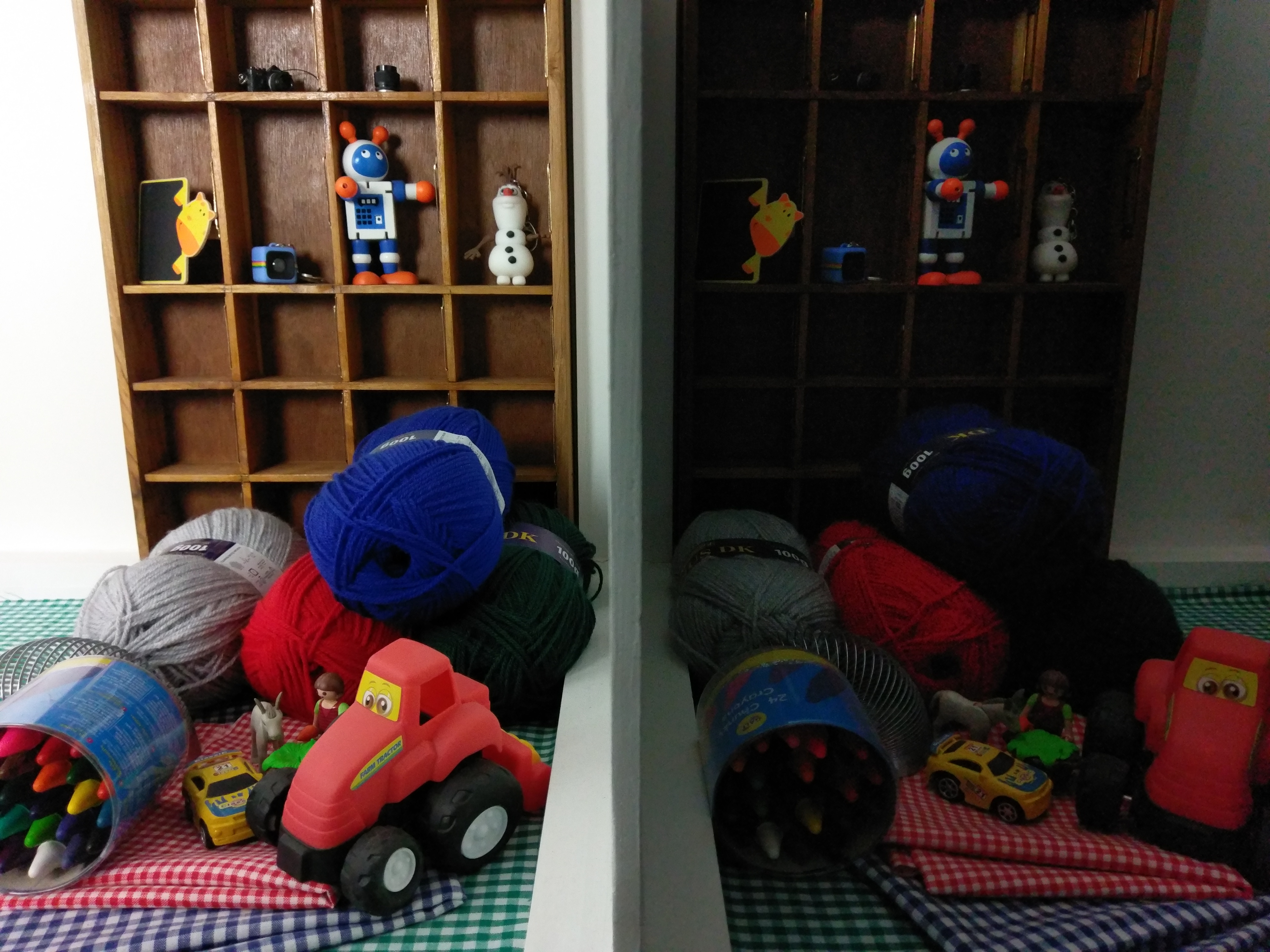
Click here to see the full resolution image
The HTC 10 does a good job of managing image noise, but it’s down on detail when compared to the top phones here.
Huawei P9
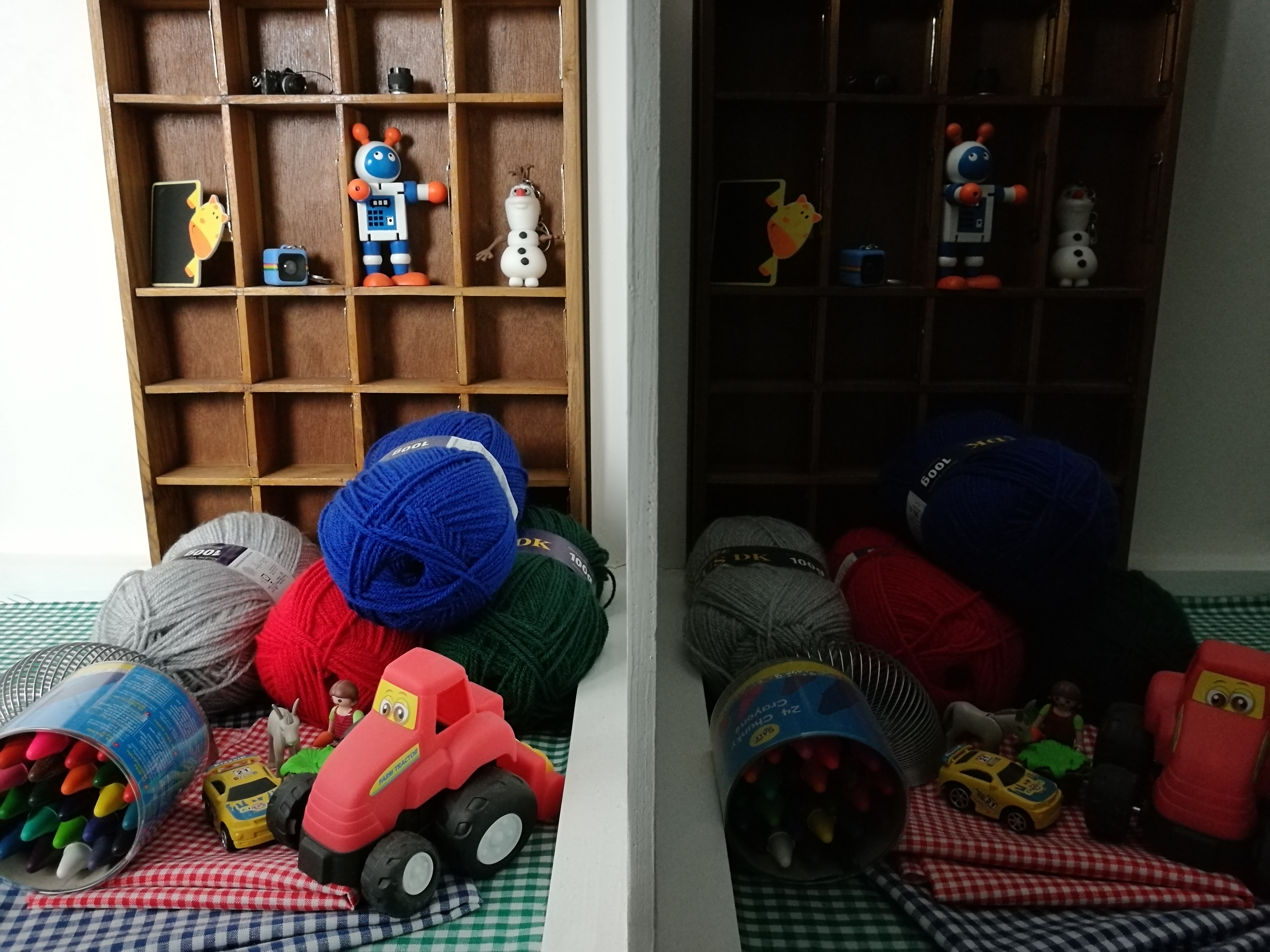
Click here to see the full resolution image
Cranking up the ISO really puts the Huawei P9 in its happy place. Huawei/Leica has done a stellar job of controlling image noise while also managing to retain plenty of detail - that’s no mean feat.
LG G5

Click here to see the full resolution image
Usually shooting at higher sensitivities restricts dynamic range, but LG doesn’t seem to have got that memo. The LG G5 manages superb dynamic range and captures more low light detail than most, but it’s badly let down by excessive image noise that becomes unsightly when viewing beyond 50% image size.
Motorola Moto Z

Click here to see the full resolution image
At first glance the Moto Z’s shot looks better than the G5’s, but that’s because Motorola has applied more noise reduction processing. This has had the effect of smearing fine detail where the G5’s shot still retains it.
It is worth noting that due to some fumbled finger work, this shot was captured at ISO 1000, but it’s doubtful things would be appreciably better at ISO 800.
Samsung Galaxy S7 Edge

Click here to see the full resolution image
With its f/1.7 maximum lens aperture and optical image stabilization, the S7 Edge rarely needs to resort to high sensor sensitivities, and that’s a very good thing. Manually select ISO 800 in low light and noise runs riot.
Combine this with Samsung’s unsightly attempt at noise reduction and fine detail is all but obliterated, while color saturation is also noticeably reduced.
Sony Xperia XZ

Click here to see the full resolution image
High megapixel counts traditionally compromise low light performance, as cramming more pixels onto a small sensor makes each individual pixel smaller and less light-sensitive.
Sadly, nobody told Sony this, and the Xperia XZ’s ISO 800 shot is barely better than Samsung’s in terms of grain. Sony’s higher pixel count does resolve slightly more detail than the S7, but it’s nothing to shout about.
Winner: Huawei P9
We’d be happy to see ISO 800 image quality like this from an entry-level compact system camera. It’s almost witchcraft coming from a smartphone.
Runner up: Google Pixel XL
Superb detail and low noise at high sensitivities - it’s a rare combination. Better exposure metering may have given Google the win here.
Highly commended: HTC 10
Not the sharpest shot, but it’s pleasing to the eye if you can do without max detail.
A colorful, detailed, yet fairly dim indoor scene lit by a bright skylight gives a good combined test of color accuracy, dynamic range and detail capture in challenging conditions.
Best camera phone trivia: what is HDR?
Camera sensors can only capture so much highlight and shadow detail at once. The difference between the darkest and brightest areas of a scene that a camera can detect (before shadows just turn black and highlight areas overexpose to white) is known as dynamic range.
A camera phone with HDR - high dynamic range - can detect increased highlight and shadow detail through software processing trickery, giving you a photo that’s closer to what your eyes see.
Apple iPhone 7 Plus

Click here to see the full resolution image
The 7 Plus remains true to form in this test, producing attractive overall image quality with realistic color and contrast. But it again loses out due to lackluster detail - just examine the definition of the writing on the cafe’s chalk boards compared to the Pixel, HTC and S7 Edge’s shots.
Google Pixel XL

Click here to see the full resolution image
If it wasn’t that it’d probably violate Motorola’s trademarks, Google should really have called the Pixel something razor-related; its images are that sharp.
It’s not just a one trick pony though, as color and contrast are also bang on, and there's good dynamic range with HDR enabled. The only flaw is some noticeable chromatic aberration (purple fringing) around the skylight in the roof - something that isn’t apparent in shots from the other phones.
HTC 10

Click here to see the full resolution image
As with the landscape test, enabling HDR enhances the 10’s dynamic range, but to a degree where contrast suffers and results look flatter than those taken by most of HTC’s rivals. It’s a very easy Photoshop fix though, yet you’d have trouble mimicking the 10’s admirable ability to resolve fine detail while maintaining a smooth, natural look.
Huawei P9
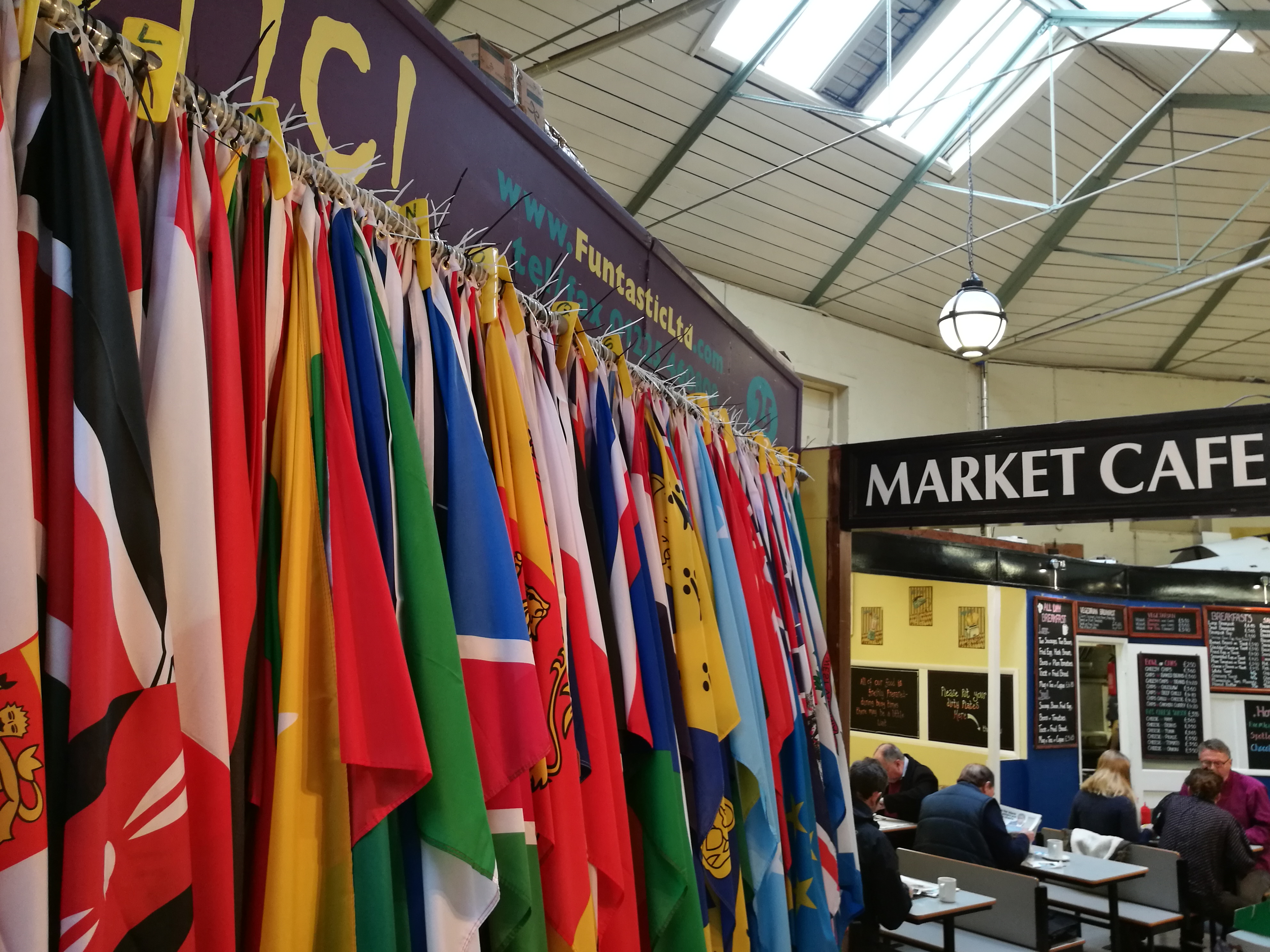
Click here to see the full resolution image
Comparing the writing on the blackboards in the cafe suggest the Huawei P9 has generated an uncharacteristically soft shot in this test. The flags are sharp though, and the camera has used a relatively narrow f/2.2 aperture here, which should generate more depth of field.
The softness in the cafe area is therefore likely due to the P9 picking a focal point much closer to the foreground. Color, contrast and dynamic range are all perfectly acceptable though.
LG G5

Click here to see the full resolution image
You wouldn’t notice it in isolation, but the LG G5’s color reproduction isn't quite as accurate as it should be for some hues in this scene. There’s also marginally more noise than the Pixel XL and S7 Edge have generated, but LG fights back with great overall brightness, punchy contrast and excellent detail.
Motorola Moto Z

Click here to see the full resolution image
The Moto Z’s image quality here is pretty good, if you don’t pixel-peep. There’s good vibrancy and enough contrast to give the scene impact while still retaining a wide dynamic range.
But enlarge to 100% image size and you’ll see fine detail is smoothed by noise reduction processing, and there’s a hint of unwanted watercolor effect not apparent in shots from the other phones.
Samsung Galaxy S7 Edge

Click here to see the full resolution image
There isn’t much to say here, as the Galaxy S7 Edge’s shot nails color, contrast and an accurate exposure while resolving superb detail.
Sony Xperia XZ

Click here to see the full resolution image
Even at ISO 200, the Xperia XZ is already out of its comfort zone and noise is becoming obvious. Consequently, fine detail has suffered and you don’t need to strain your eyes to spot these flaws.
Winner: Samsung Galaxy S7 Edge
Detailed without looking overly sharp, while also being vibrant yet realistic - a perfect balance.
Runner up: Google Pixel XL
The Pixel XL’s extra sharpness technically gives it an edge (pun tragically intended) over the S7 Edge, but the Edge’s shot looks marginally more natural, and the S7 Edge doesn’t produce fringing like the Pixel XL.
Highly commended: HTC 10
Sharp and natural, but there’s room for better color saturation.
Highly commended: LG G5
Only some slightly iffy color reproduction and a bit of image noise keep the G5 off the top spots here.
A shakedown like this wouldn’t be complete without seeing how these phones perform at their maximum sensor sensitivity, and for all but the iPhone 7 Plus, Pixel XL and S7 Edge, this can be manually set to ISO 3200.
It’s rare that you’d ever need to max out the sensitivity scale like this, but it’s a good way to separate the men from the boys.
HTC 10

Click here to see the full resolution image
Inevitably there’s some grain here, but HTC has managed to retain a respectable amount of fine detail and has kept color saturation high - something not all cameras manage at higher ISO sensitivities.
Huawei P9

Click here to see the full resolution image
The Huawei P9 wasn’t fazed at ISO 800, but we thought upping the ante to ISO 3200 would give it more grief. Not so. Clearly the Leica connection is more than name-only, as the P9’s camera produces uncannily detailed and clean results at high sensitivities.
LG G5

Click here to see the full resolution image
Credit to LG for not simply throwing maximum noise reduction processing at the LG G5’s high ISO shots and ending up with a smeary watercolor effect. But a little more noise reduction wouldn’t hurt here, as the G5’s ISO 3200 shots are excessively noisy.
Motorola Moto Z

Click here to see the full resolution image
The Moto Z’s shots at this sensitivity aren’t quite as noisy as the G5’s, but they’re not far off.
Sony Xperia XZ
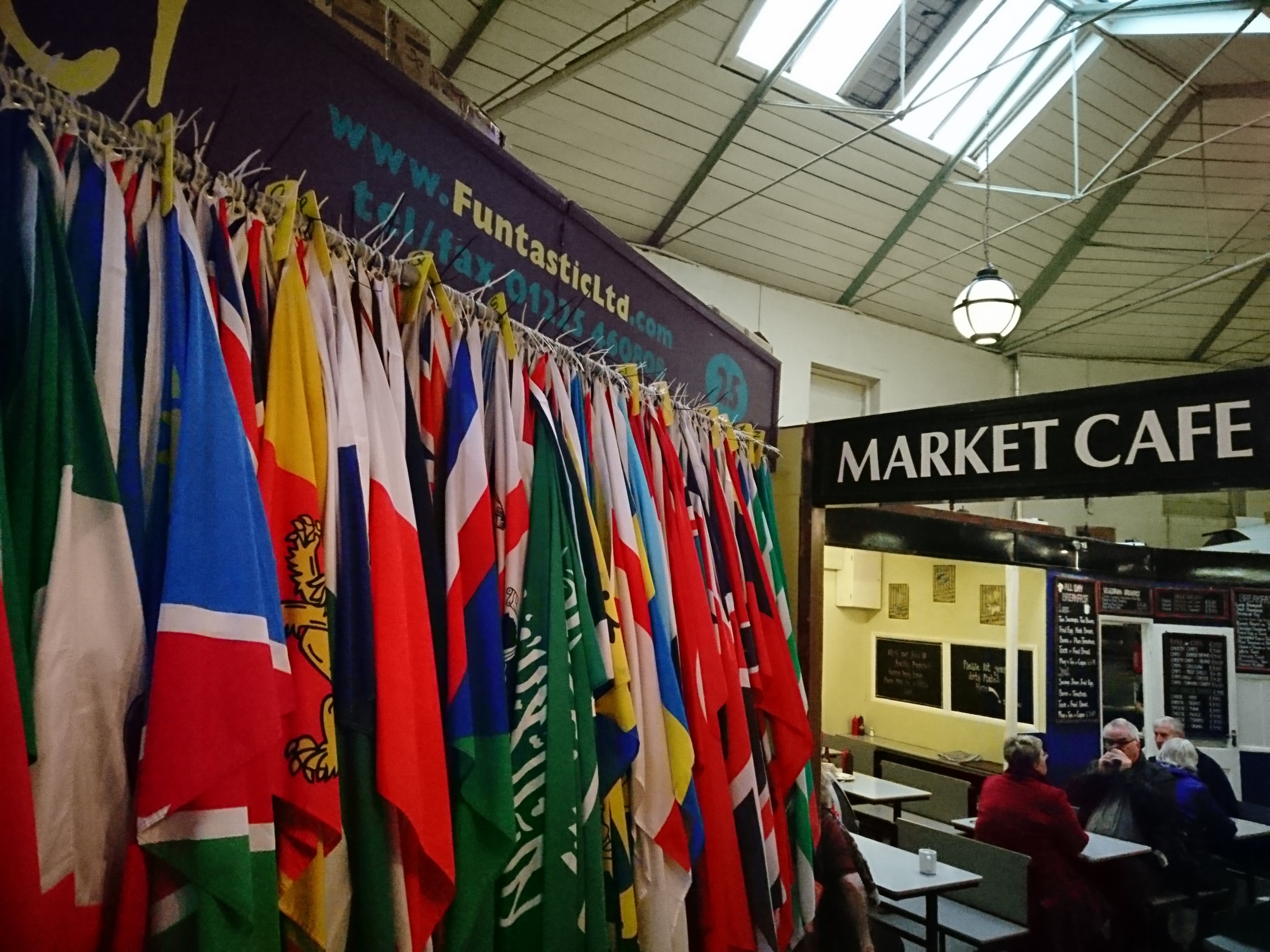
Click here to see the full resolution image
Strangely, considering the Xperia XZ’s high noise levels in our ISO 800 test, cranking up to ISO 3200 hasn’t hurt image quality too much more. The overall exposure is quite dark though, and detail is very soft. But with 23MP to play with, there is scope to downsize the shot to enhance sharpness and hide some noise.
Winner: Huawei P9
Some of these tests are close contests - this one isn’t. The P9 schools the competition in high ISO image quality.
Runner up: HTC 10
The HTC 10 is the only phone that can hold a candle to the P9’s performance at ISO 3200.
Accurate white balance, autofocus, contrast and color reproduction are all essential for flattering portrait shots.
Apple iPhone 7 Plus
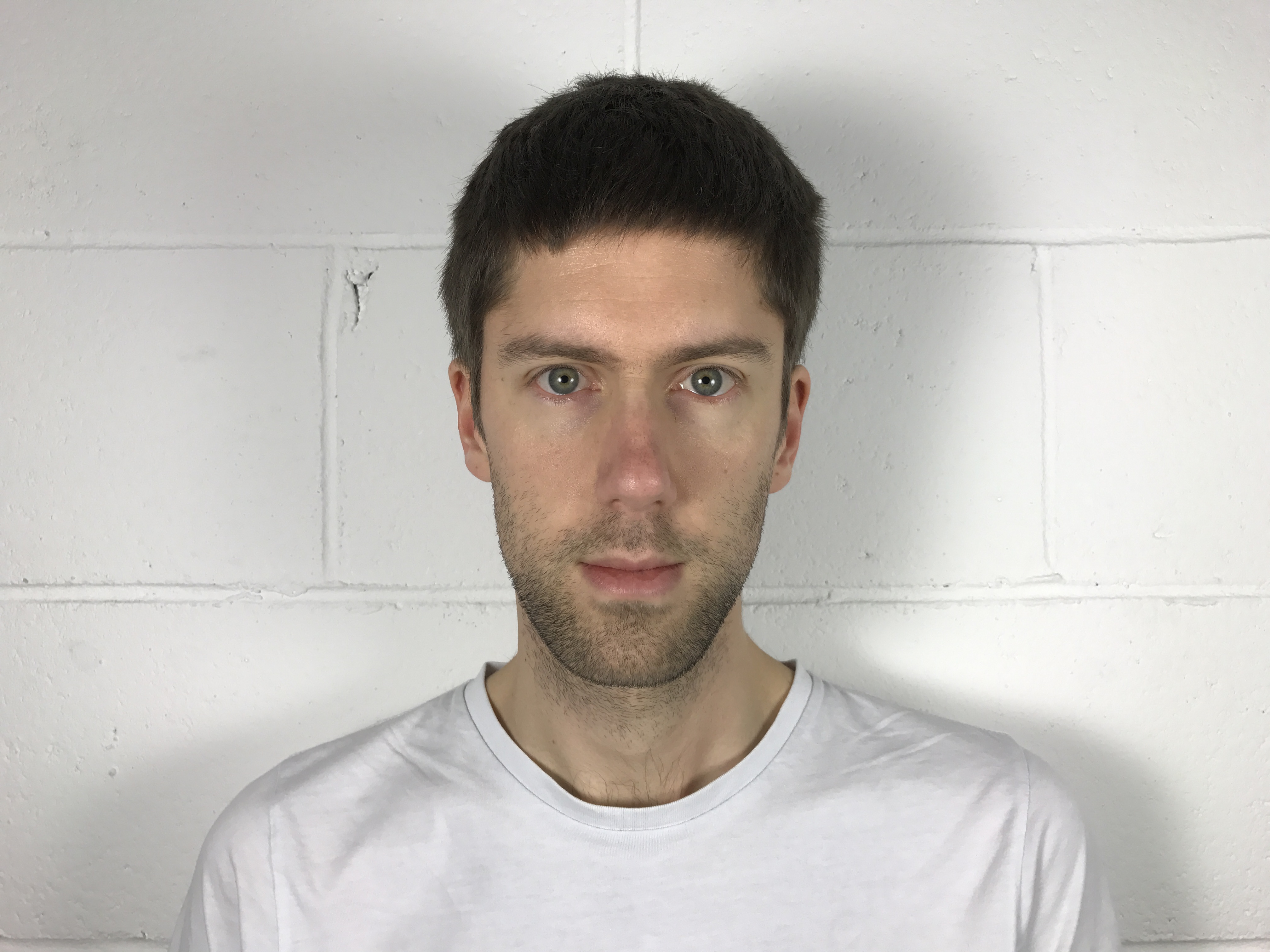
Click here to see the full resolution image
The iPhone’s excellent white balance is vital for portrait shots where you need accurate skin tones. Some colors could do with a little more saturation though, as the lips are slightly muted. But the iPhone 7 Plus’s most obvious shortcoming is detail, which is noticeably lower than in the Pixel XL and S7 Edge’s shots.
Google Pixel XL

Click here to see the full resolution image
White balance is bang on here and so too is skin tone rendition, but it’s the level of detail when you view at 100% image size that impresses most.
Fine detail in the eyes and eyebrows pops like no other shot here, although the Pixel’s extreme detail resolving power can produce some unwanted side effects in some scenarios. There’s some moiré noise on the T-shirt, as the sensor has even attempted to resolve the super-fine fabric texture.
HTC 10

Click here to see the full resolution image
HTC’s effort is slightly warm, but there’s plenty of detail - almost as much as in the Pixel XL’s shot.
Huawei P9

Click here to see the full resolution image
The P9 has produced a minor yellow color cast, though it’s not severe enough to be unflattering. It’s also a sharp shot, coming in just behind the HTC 10 on detail.
LG G5

Click here to see the full resolution image
LG’s image is a little underexposed and the G5’s auto white balance isn’t quite as accurate at it could be. There’s a fair amount of fine detail, however the result does look a bit painterly.
Motorola Moto Z

Click here to see the full resolution image
Motorola’s contrast is relatively high here, and it’s not particularly flattering. This isn’t helped by yellowish skin tones, while fine detail is lacking as the image is one of the softest here.
Samsung Galaxy S7 Edge
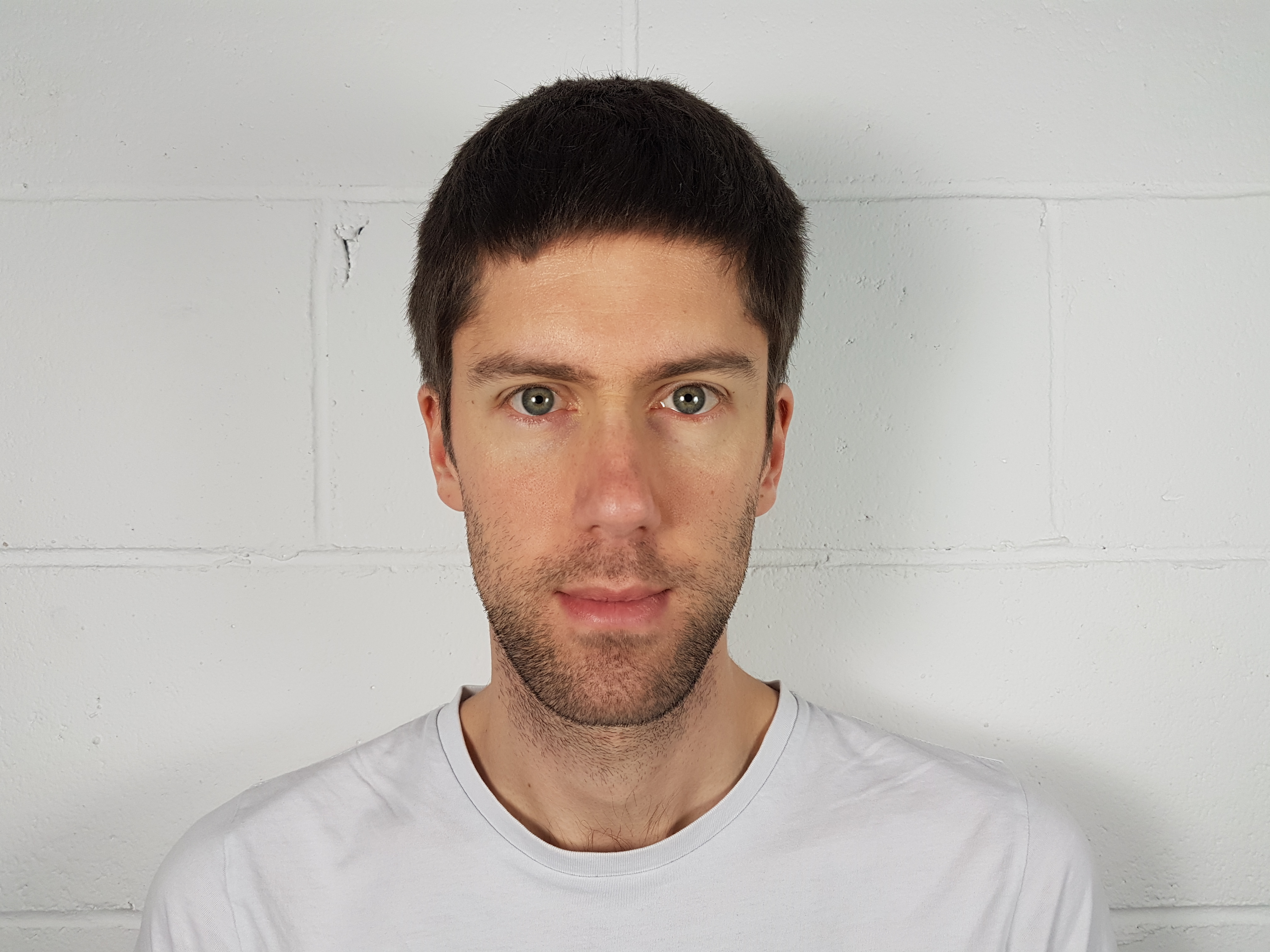
Click here to see the full resolution image
A bright yet balanced exposure and excellent white balance get the S7 Edge’s shot off to a good start. Detail isn’t immediately impressive, but it appears this may be down to the autofocusing, which has focused slightly too far back, as the nose is out of focus, but the ears, neck and T-shirt are very sharp.
Sony Xperia XZ

Click here to see the full resolution image
Last and unfortunately also least comes the Xperia. The XZ’s shot is underexposed, and even though it’s only been captured at ISO 64, there’s masses of image processing visible.
Contrasty detail like the stubble is retained, but more subtle elements like skin pores have been mostly smeared away. The eyebrows and hair haven’t escaped the image processing issues either and are a painterly mess.
Winner: Google Pixel XL
Stunning sharpness and good color accuracy give Google the win in this test.
Runner up: Samsung Galaxy S7 Edge
Only some slightly inaccurate focusing causes the S7 Edge to lose out here.
Highly commended: Huawei P9
It doesn’t take much to fall down the order in this close-run test, and it’s just the P9’s slight color cast that goes against its image.
Highly commended: HTC 10
There’s great detail here, but like the P9, the colors could be more flattering.
Flashes are notoriously bad for flattering portraiture if they’re not carefully controlled, but with dual-tone technology, smartphone flashes promise decent results. Let’s see how well they actually perform.
Apple iPhone 7 Plus

Click here to see the full resolution image
Although its flash puts in a powerful performance here, the 7 Plus’s image is quite contrasty and not as flattering as it could be. Fine detail is again lacking, especially when compared to equivalent shots from the HTC 10 and Pixel XL.
Google Pixel XL

Click here to see the full resolution image
Although the Pixel XL’s flash definitely fired here, you can barely tell this shot apart from the non-flash image. Skin tones are natural and auto white balance has done a great job. As with the non-flash shot, detail is first class, though there’s still some moiré patterning on the very fine T-shirt weave.
HTC 10

Click here to see the full resolution image
HTC’s image is somewhat underexposed and the dual-tone flash has left skin tones looking slightly too warm. Detail is very good though.
Huawei P9

Click here to see the full resolution image
There’s plenty of detail in the Huawei P9’s shot, and no sign of any noise or painterly smearing. Trouble is, you’ve got to get past the nasty yellow color cast to appreciate this, as the P9’s auto white balance seems to have gone on strike.
LG G5

Click here to see the full resolution image
Here’s another example of dodgy white balance and color accuracy, as the LG G5 is all over the place in its color rendering. Skin tones are hugely oversaturated, while the background wall is a rainbow of color casts.
The image is also underexposed by at least 1 stop, but detail is fairly good, if ever so slightly painterly in a few places.
Motorola Moto Z

Click here to see the full resolution image
The Moto Z’s performance here isn’t as bad as in some of our tests, as detail is quite well preserved, though it’s still some way off what the Pixel XL and HTC 10 can resolve. Auto white balance has also done a good job, though a slightly longer exposure would have helped lift the shot.
Samsung Galaxy S7 Edge
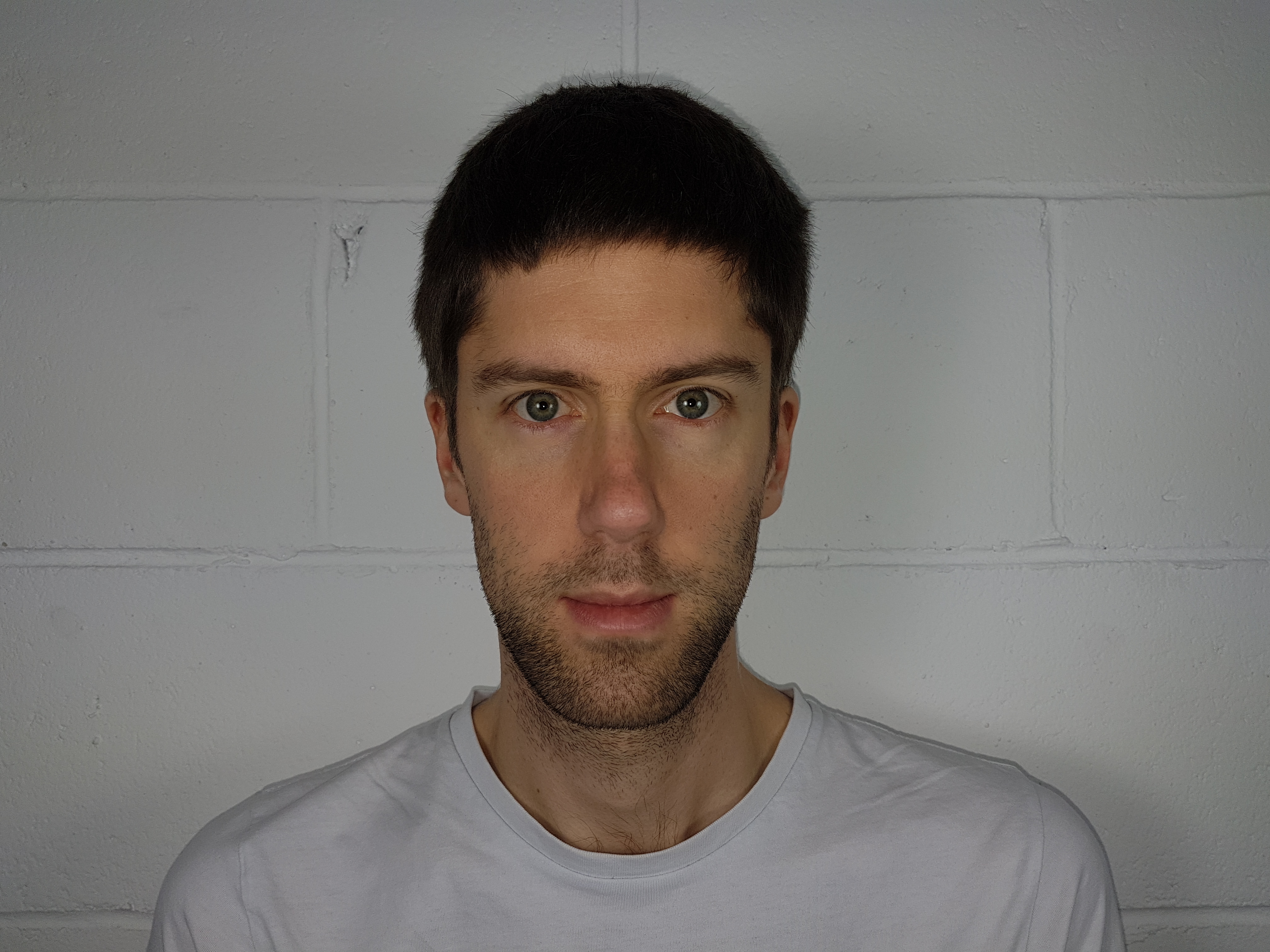
Click here to see the full resolution image
A rare exposure metering error here sees the S7 Edge produce an underexposed image. Detail levels are still impressively high though, even if the hair is more of a silhouette and doesn’t respond very well to a shadow lift in Photoshop.
Sony Xperia XZ

Click here to see the full resolution image
As with the Pixel’s result, there’s little to separate the XZ’s flash and non-flash portrait shots. However, that also means this image retains Sony’s excessive noise reduction processing, which has smeared subtle details and left an unrealistic look at 100% image size.
Auto white balance has performed well though, but the image is slightly underexposed.
Winner: Google Pixel XL
Its flash portrait is almost identically detailed and well-lit as the non-flash image, and therefore just as impressive.
Runner up: Samsung Galaxy S7 Edge
It’s underexposed, but otherwise the S7 Edge’s shot is very good.
Highly commended: HTC 10
Also slightly underexposed, but it’s the warm skin tones that prevent the HTC 10 taking second position.
Selfie cameras generally lack the image quality and performance of rear-facing counterparts, but if you want to look good in your selfies, they’d better deliver decent results.
Apple iPhone 7 Plus

Click here to see the full resolution image
The iPhone’s 7MP front-facing selfie camera produces well exposed and well saturated photos. Autofocusing, though not perfectly accurate, performs better than many rival systems.
Google Pixel XL

Click here to see the full resolution image
The Pixel XL’s selfie camera is surprisingly awkward to use, as the autofocus struggles to lock on to nearby subjects. Detail in the background is therefore pretty good - it's just a shame your face will probably be out of focus.
HTC 10

Click here to see the full resolution image
Like the LG G5’s shot, HTC’s selfie image is flipped, making it easier to compose, but meaning you’ll need to flip it back afterwards if you want a composition that’s true to life.
Focusing is accurate, though there isn’t much depth of field. Aside from the glasses in this shot which are sharp, skin detail is lacking and the camera hasn’t resolved any texture in the clothing.
Huawei P9

Click here to see the full resolution image
Sound white balance and plenty of detail from the Huawei P9’s front-facing camera make it one of the best selfie-snappers here.
LG G5

Click here to see the full resolution image
The G5’s image shares the same flipped composition as HTC’s shot, and it’s autofocus system performs much like the Pixel’s, focusing too far back and resulting in better background than subject detail.
Motorola Moto Z

Click here to see the full resolution image
Despite its relatively modest 5MP resolution, the Moto Z’s selfie camera resolves a decent amount of detail. Shame about the color reproduction though, which is way too saturated.
Samsung Galaxy S7 Edge

Click here to see the full resolution image
By contrast to the Moto Z, Samsung’s selfie shot could do with more saturation. Detail isn’t great either, especially in the stubble areas of this image.
Sony Xperia XZ

Click here to see the full resolution image
Xperia fans, rejoice: the XZ finally comes good. Sure, Sony’s characteristic overzealous image processing almost takes the shine off things, but the sheer size of its 13MP selfie shots makes them more detailed than any of its rivals, just. Color reproduction and accurate autofocusing ensure the XZ comes away with the win here.
Winner: Sony Xperia XZ
More megapixels haven’t done its main camera any favors, but the ‘less isn’t more’ ethos just about works for selfie shots.
Runner up: Apple iPhone 7 Plus
There’s nothing particularly special about the 7 Plus’s selfie shots, but it’s a very good all-rounder here.
Highly commended: Huawei P9
It’ll resolve as much detail as the iPhone 7 Plus, so it’s a shame the P9’s selfie camera autofocus isn’t quite as accurate.
So here we are, the big decision. Which phone wins the overall title of TechRadar’s best camera phone 2016?
We scored each category awarding 3 points for a win, 2 points for a runner up, and 1 point for a highly commended. The phone with the highest total score is our smartphone snapper supremo.
Drum roll please...
8. Motorola Moto Z (1 point)
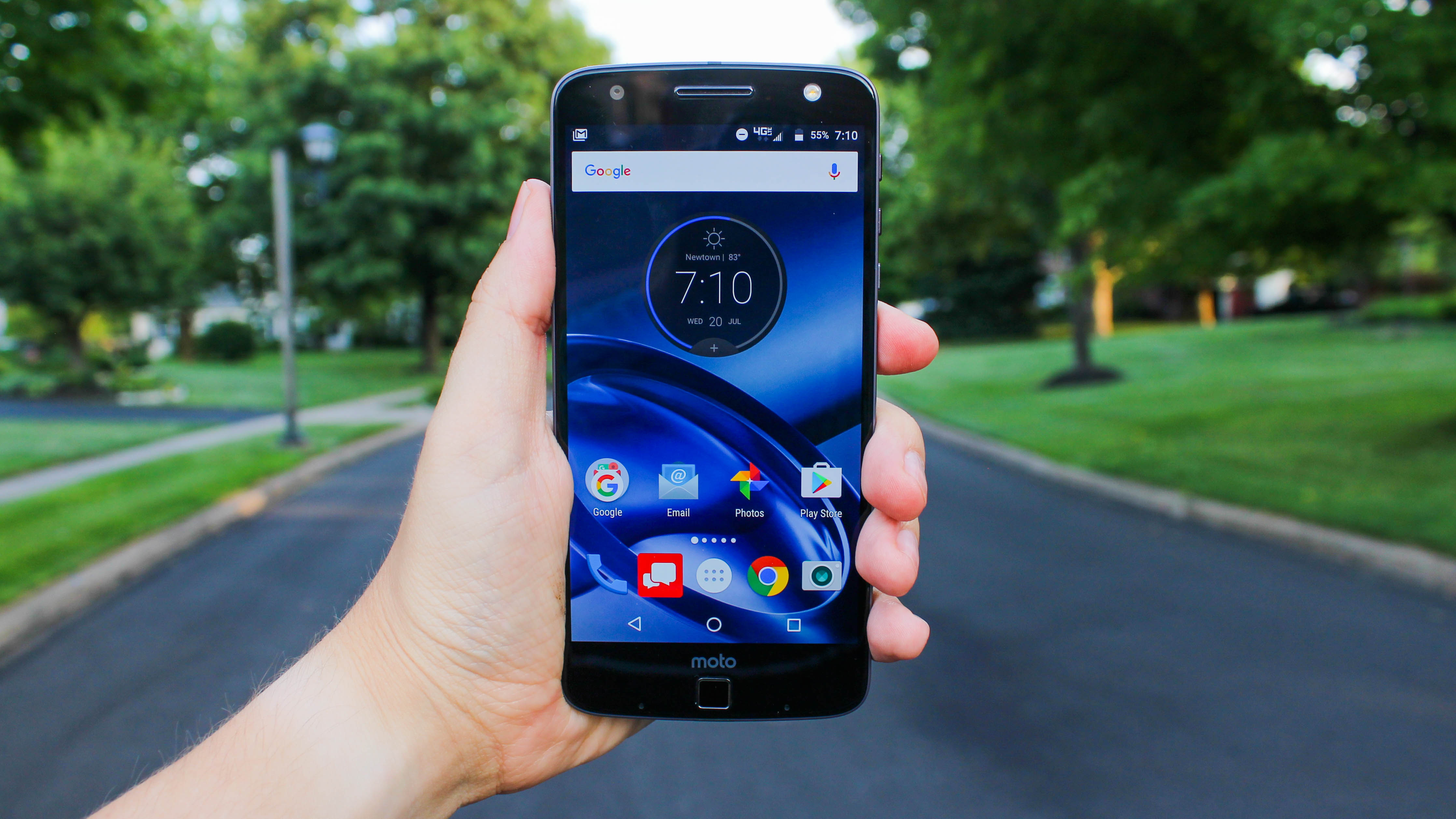
It may be one of the world’s slimmest smartphones and is relatively well priced, but the Motorola Moto Z’s camera is also pretty lean on image quality. Lack of detail and overzealous image processing that leaves shots with a nasty watercolor effect when viewed closely plagues the Moto Z’s shots.
Some iffy color and contrast - both with the rear and front-facing camera - add insult to injury, as does lackluster dynamic range and poor high ISO performance.
The Moto Z does at least sport a well-designed, comprehensive, yet easy to use camera app, but it’s not enough to rescue this disappointing effort.
7. Sony Xperia XZ (4 points)

The Sony Xperia XZ’s 23MP camera may look great on paper, but its shots don’t. In all of our main camera tests, those extra megapixels only serve to reduce image quality, as the XZ resolves considerably less detail than most of its rivals.
If fine detail isn’t already endangered, relatively prominent image noise at low sensitivities, combined with prominent image smoothing, brings it close to extinction.
It’s not all bad news though, as Sony’s camera app is one of the most feature-packed here, with plenty of manual control and fun effects. Lastly, the Xperia XZ’s selfie camera may not be perfectly refined, but it’s good enough to outdo all its competitors.
6. LG G5 (4 points)
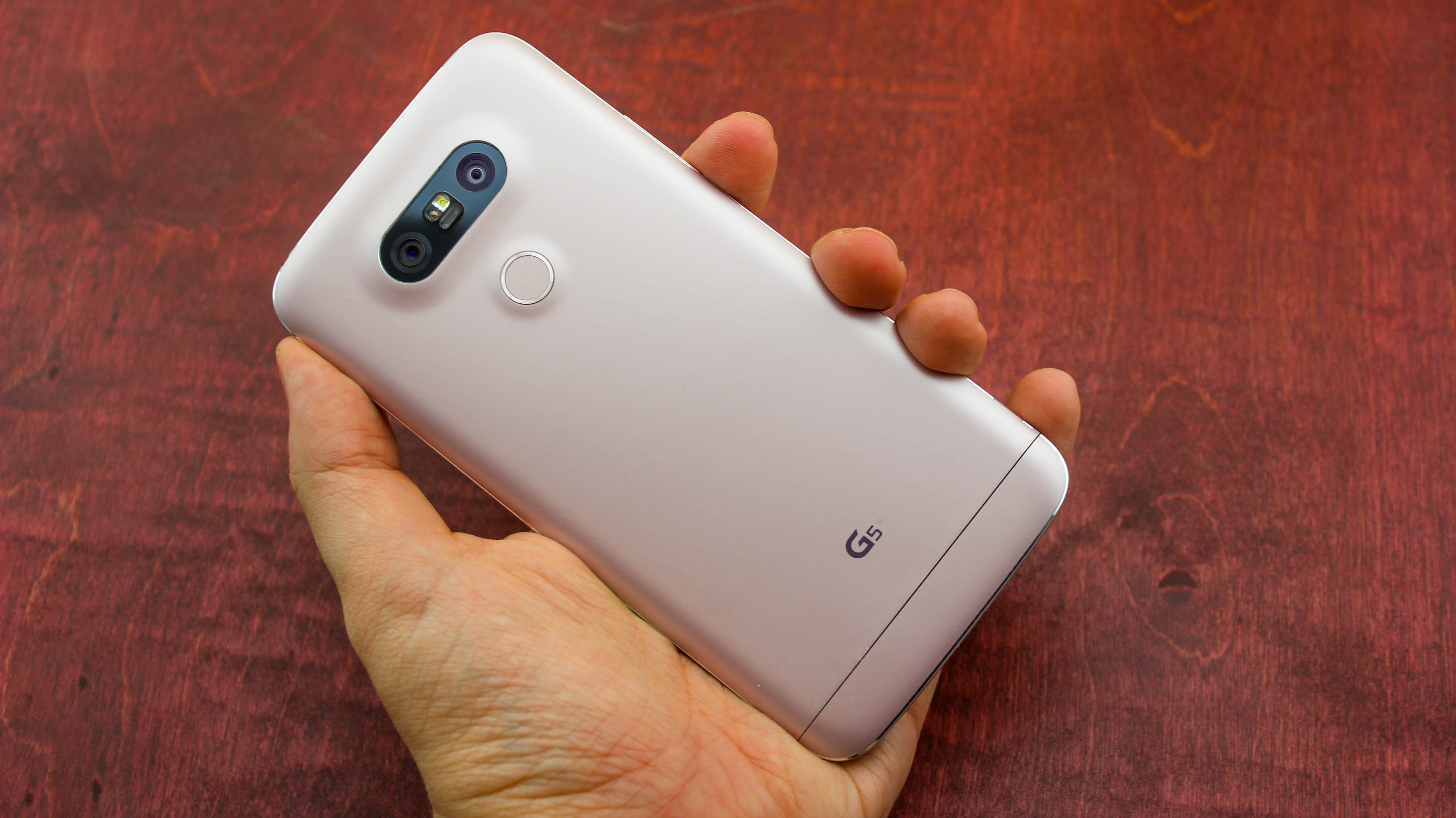
The LG G5 is the most initially satisfying camera to shoot with, as it’s the only phone here to pack a native 16:9 aspect ratio that fills its 5.3-inch screen with a big, bright image preview. The G5’s camera app is also well featured, though it’s a pity Manual mode isn’t as intuitive as it could be.
Other annoyances include poor high ISO performance that’s plagued by image noise, and LG seems to have missed a trick with its dual-camera set-up. A secondary camera configured for extra telephoto zoom would likely be more useful than the G5’s ultra-wide lens.
But the G5 gains ground by resolving plenty of detail in good lighting and it can capture stunning dynamic range with HDR enabled.
5. Apple iPhone 7 Plus (4 points)
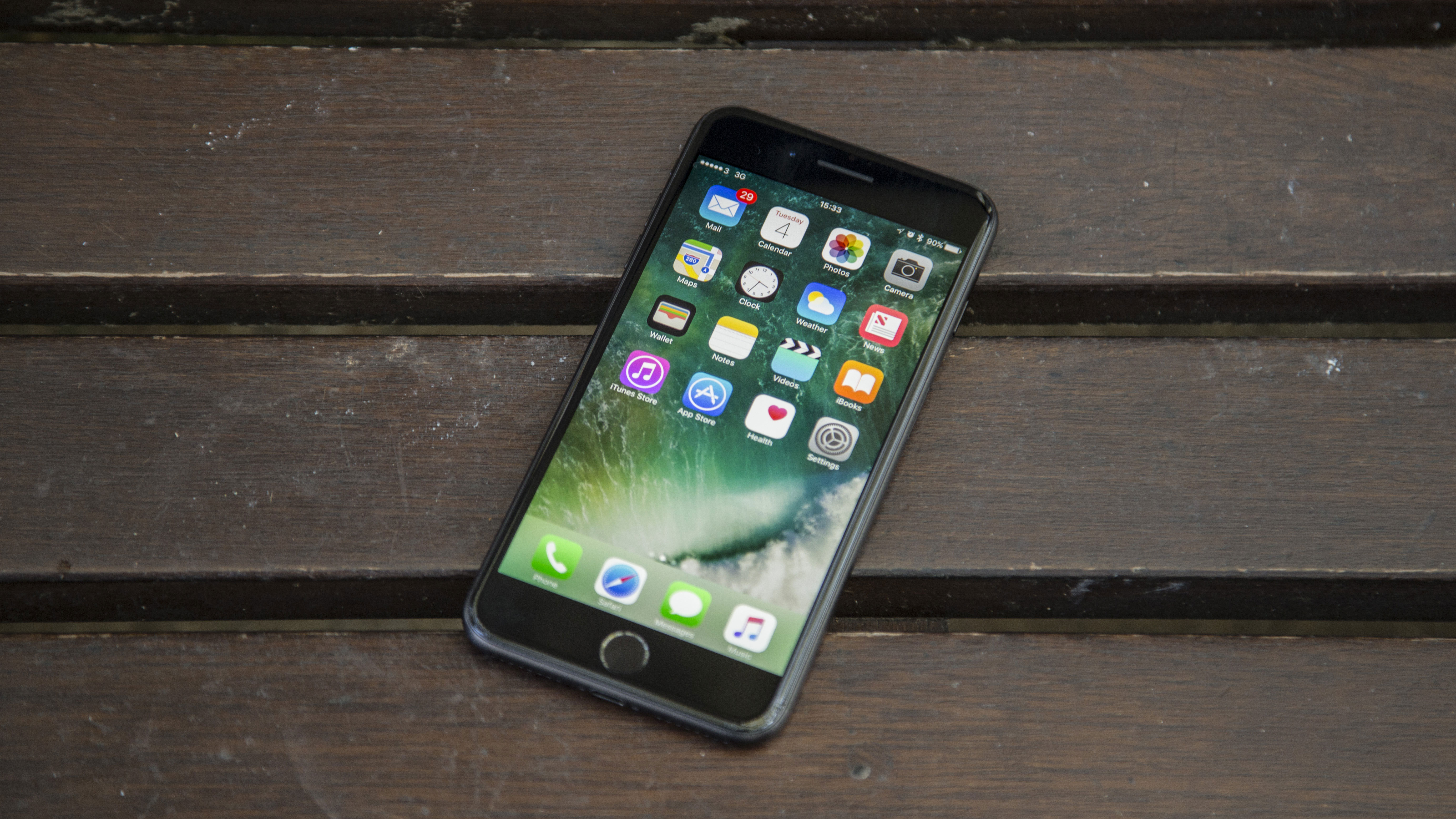
Fifth place. Yes, you’re reading this correctly. Let’s clear one thing up though: the iPhone 7 Plus is by no means a bad camera phone, it just can’t quite cut it against some exceptional rivals.
Apple’s color reproduction, autofocusing and screen accuracy are all very good, but the slightly smaller than average 1/3-inch primary camera sensor just doesn’t resolve enough detail to keep pace with phones like the Samsung Galaxy S7 Edge and Pixel XL.
Low light performance is another disappointment, as not only does Apple lose out to Samsung and Google here, its results are also beaten by HTC and Huawei. Factor in a native camera app short on manual control and you have a phone that performs well in many areas, but rarely excels.
4. HTC 10 (10 points)

The HTC 10 is a world away from its predecessor’s disappointing camera performance. Detail is well resolved in good light, and when the going gets dim, the HTC 10’s high ISO image quality is impressive.
The 10 misses out on a spot on our podium due to its slightly flat color and contrast, plus its camera app doesn't preview colors all that accurately when composing shots.
3. Huawei P9 (13 points)
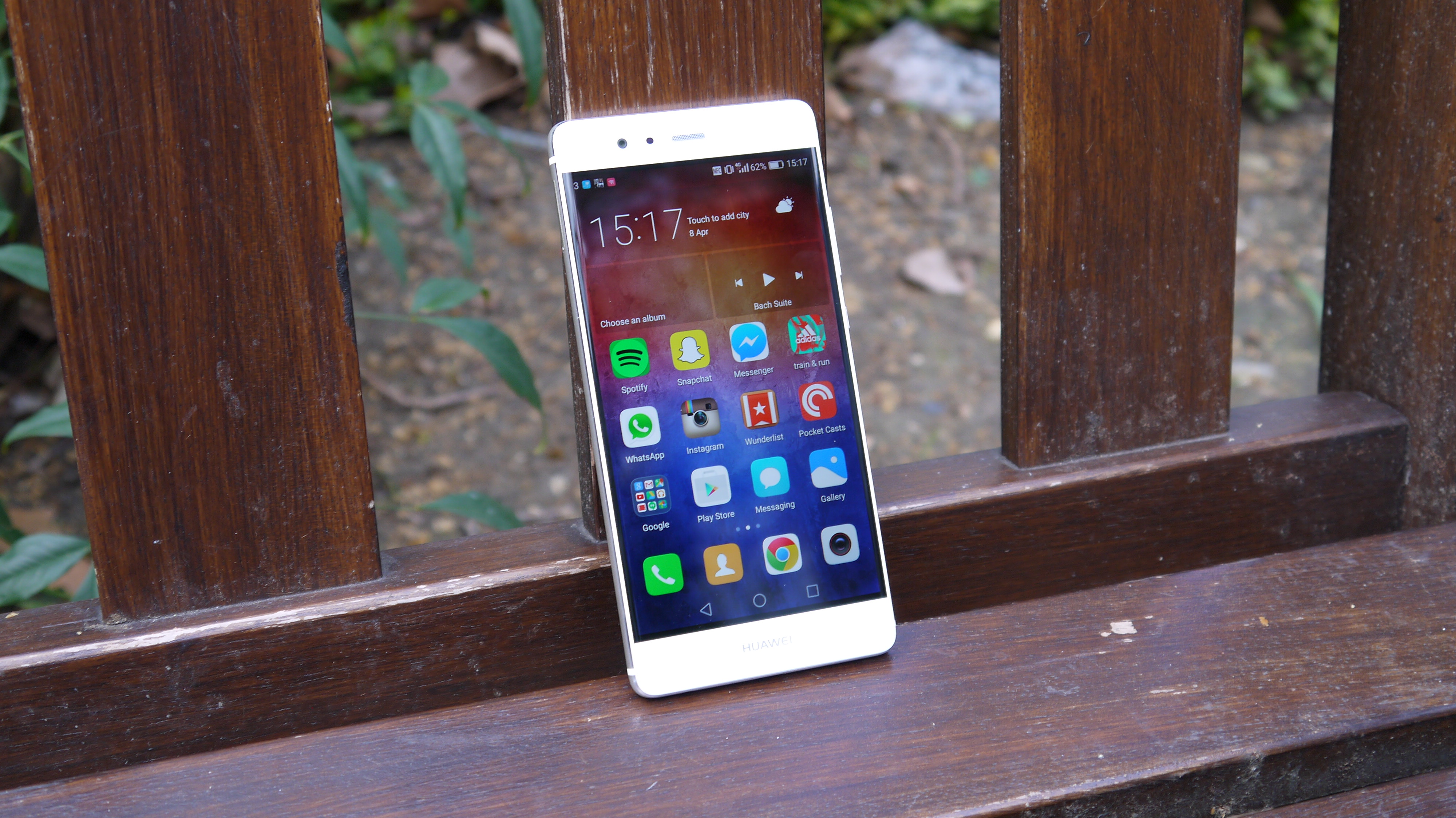
Huawei’s collaboration with the camera veterans at Leica has clearly paid off with the P9. While its images don’t contain as much fine detail as those shot by the Pixel XL, it’s not far off the S7 Edge in this department.
Color, contrast, white balance and dynamic range are all excellent, but it’s the P9’s performance in low light that’s most astonishing. At ISO 800 it’s impressive, but the clarity of its images at ISO 3200 defies logic.
Factor in the very well designed camera app that’s easy to use, yet packed with features, and the P9 is a superb all-rounder.
2. Google Pixel XL (17 points)
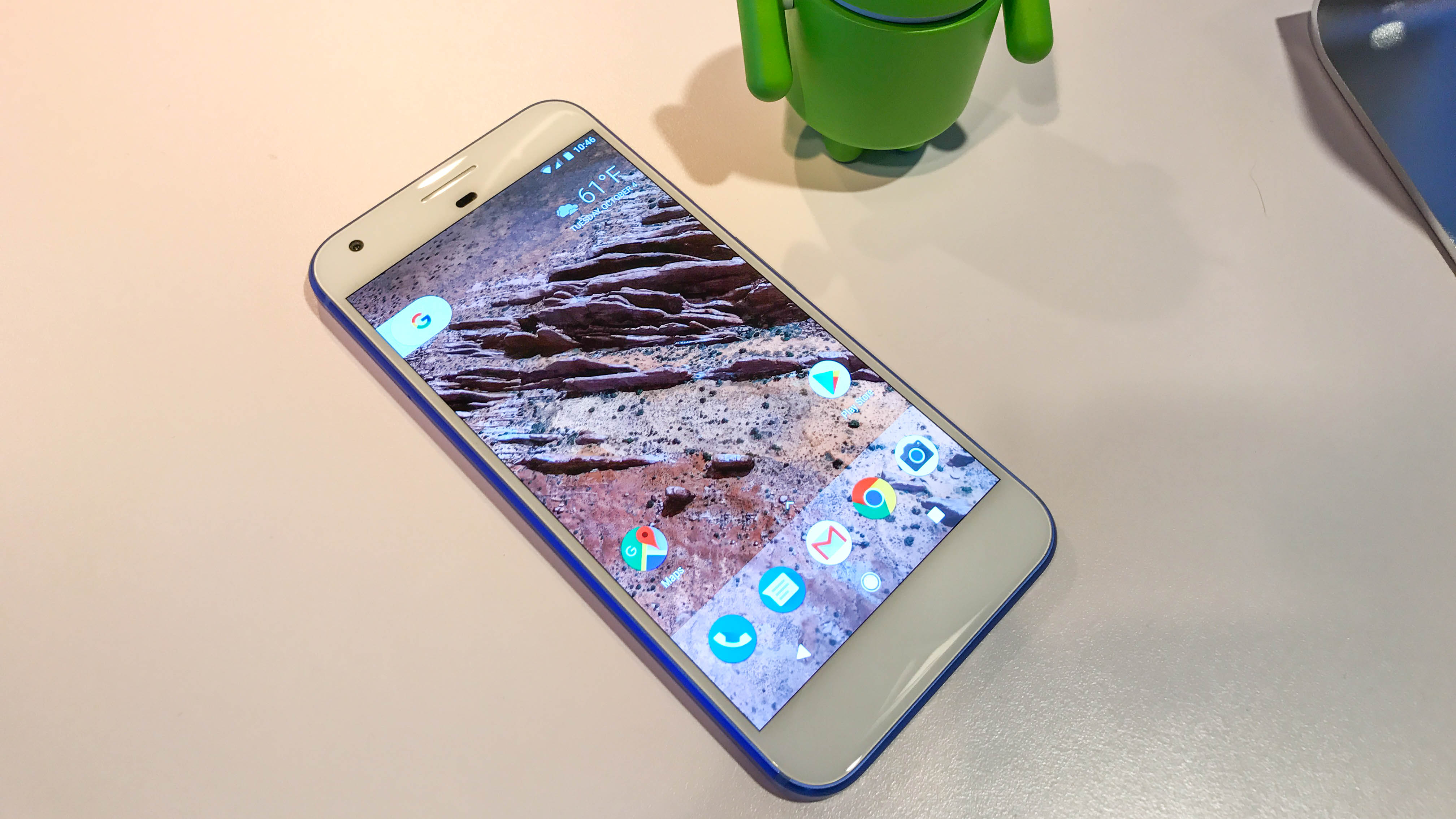
If one thing sums up the Pixel XL’s camera performance, it’s detail. Even our winner can’t resolve as much fine detail as the Pixel XL, which produces images that are incredibly sharp.
Not only does this benefit landscape shots, it also helps portraits pop thanks to razor sharp eyes and lips.
This is no one-hit wonder though, as high ISO performance is almost as impressive, and the Pixel XL’s white balance and exposure metering are also totally reliable. The Pixel doesn’t quite win out due to a stock camera app that’s short on manual control, and a selfie camera lacking dependable autofocus.
1. Samsung Galaxy S7 Edge (19 points)

Given Samsung’s strong camera performance with the Galaxy S6, it’s probably not too surprising to find the S7 Edge comes out on top here. It doesn’t get an easy ride though, as if outright detail is of prime concern, you’re better off with a Pixel XL.
Ultimately Samsung beats Google because of the S7 Edge’s far more powerful camera app, a slightly more accurate screen preview when composing shots, and extremely impressive low light performance with flash enabled.
The S7 Edge isn’t perfect though. We found a couple of occasions where exposure metering wasn’t completely accurate, plus if you feel the need to manually select ISO 800, the resulting image quality is uncharacteristically poor. Thankfully the large f/1.7 lens aperture and excellent optical image stabilization mean that even in low light, auto ISO rarely even needs ISO 400.
Just think twice before choosing an S7 Edge over a regular S7 though, as those bevelled screen edges make the Edge worryingly slippery to hold.
- Those are the best cameras, these are the best phones
from TechRadar: Phone and communications news http://www.techradar.com/news/best-camera-phone
No comments:
Post a Comment